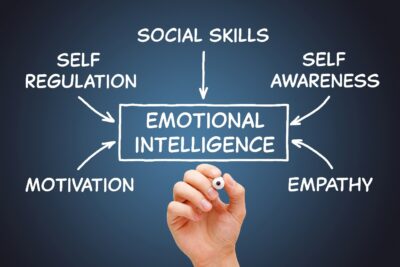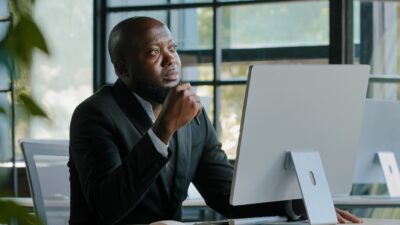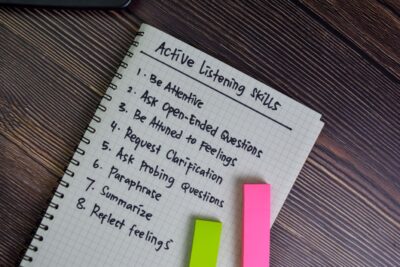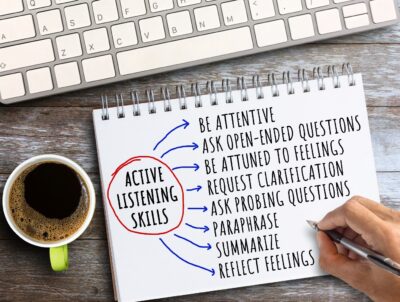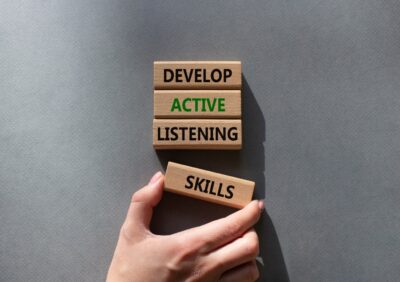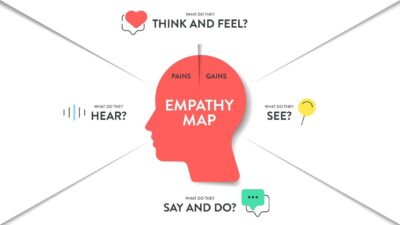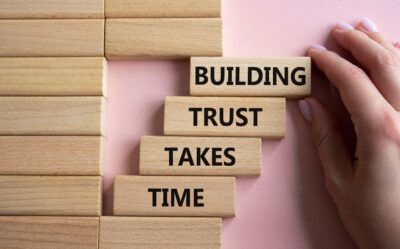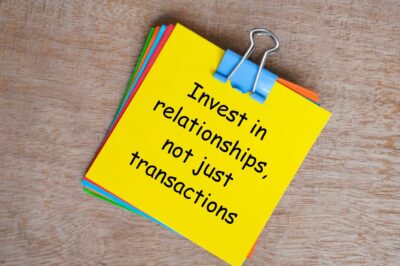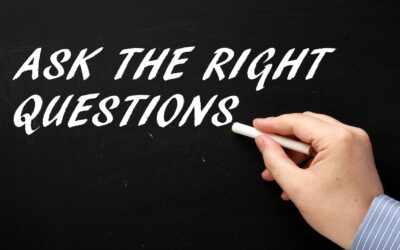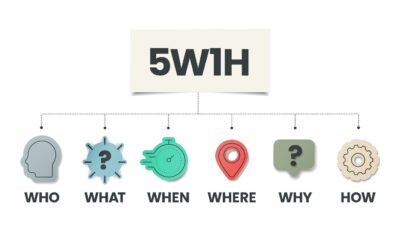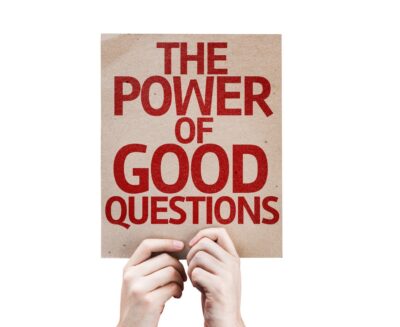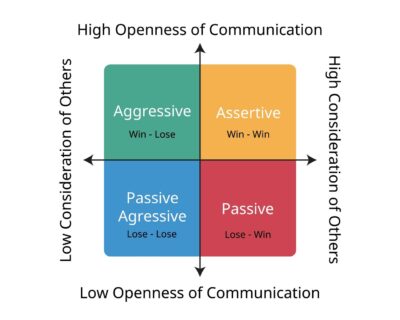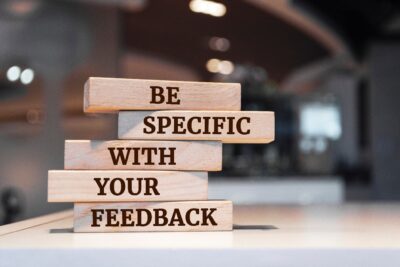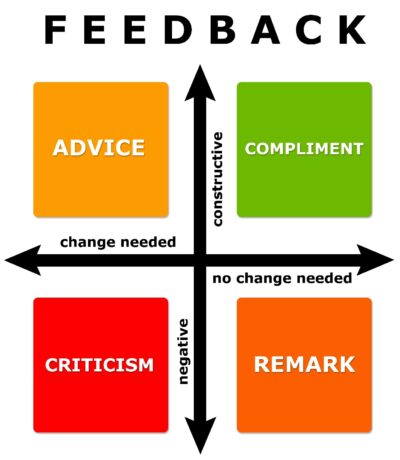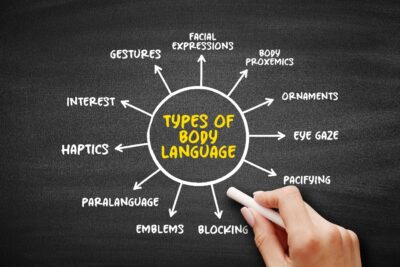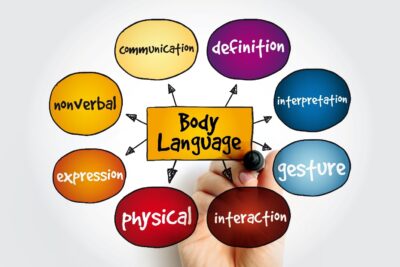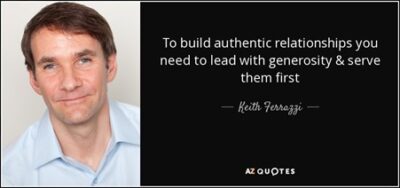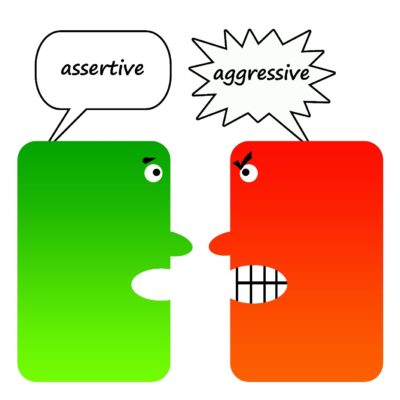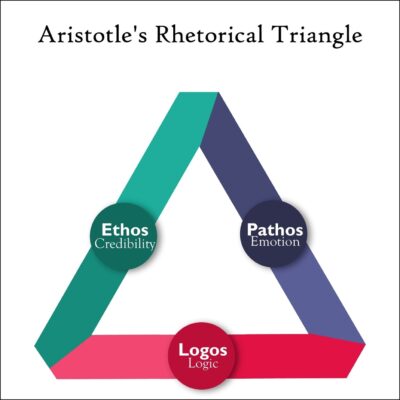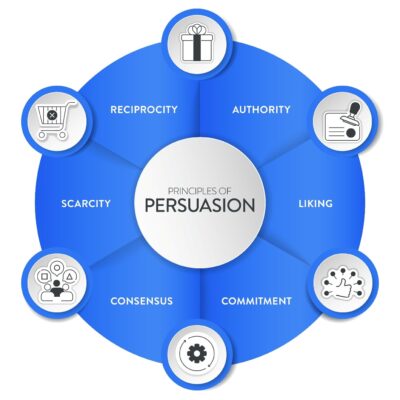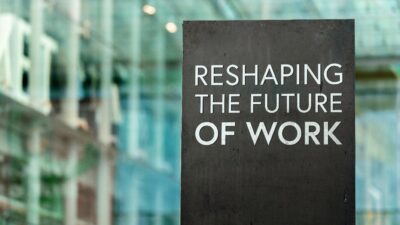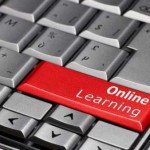Professional Services Advisor – WDP2 (Effective Communication)
The Appleton Greene Corporate Training Program (CTP) for Professional Services Advisor is provided by Dr. Cherry Certified Learning Provider (CLP). Program Specifications: Monthly cost USD$2,500.00; Monthly Workshops 6 hours; Monthly Support 4 hours; Program Duration 12 months; Program orders subject to ongoing availability.
If you would like to view the Client Information Hub (CIH) for this program, please Click Here
Learning Provider Profile

Prior to his advisory, academic and training career, Dr. Cherry had significant senior management experience, at general manager and managing director level, across manufacturing and service industries. His strong commercial acumen and strategic thinking, coupled with formal business and technical tertiary qualifications, have allowed him to achieve significant revenue and profitability growth through his senior career. Dr Cherry has worked in senior management, executive director, and non-executive director roles across multinationals, listed and private companies as well as not-for-profits. A strong strategic mind-set, coupled with an ability to lead senior and middle management teams have been the keys to Dr Cherry’s commercial success in business, across a range of industries. Throughout his career, Dr Cherry has demonstrated his capability to affect change, turnaround, re-engineer and grow businesses both organically and via acquisition. He has leveraged this corporate experience and success into his professional services career and provides strategic advisory and training services at senior management and board level to clients globally. Outside his professional career, Dr Cherry was a founding director of the Cure Brain Cancer Foundation, established to fund advances in brain tumour treatment and research. He also lectures and supervises at undergraduate and postgraduate levels across several Australian and Irish universities and business schools.
Dr Cherry holds an honours degree in Chemical Engineering, a Master of Commerce degree with a marketing major and a Doctor of Business Administration degree where he researched trust in the professional services context.
MOST Analysis
Mission Statement
Welcome to Workshop 2 on Effective Communication. Effective communication is the cornerstone of success in professional services organisations. It is the foundation for building trust, fostering collaboration, and delivering exceptional value to clients while cultivating a positive and productive workplace culture. The mission of this workshop is to empower professionals with the skills and strategies necessary to transform communication from a routine task into a powerful tool for achieving both individual and organisational goals.
This comprehensive programme is designed to address a wide range of essential communication competencies, ensuring participants can navigate the complexities of modern professional interactions with confidence and skill. Active listening, a fundamental aspect of effective communication, is emphasised to help participants deepen their connections with others and overcome common barriers to understanding. Similarly, the workshop focuses on building trust and rapport, equipping attendees with strategies to foster meaningful relationships through verbal and non-verbal communication.
A key component of the training involves enhancing questioning and feedback skills. Participants learn how to craft insightful questions to uncover client needs and deliver constructive feedback that inspires growth and improvement. The workshop also prioritises the development of a personalised communication style by encouraging self-awareness and emotional intelligence, enabling professionals to adapt their approach to diverse audiences and situations.
Recognising the challenges of professional interactions, this programme provides practical tools for managing complex communication scenarios. Whether navigating conflicts, addressing difficult conversations, or communicating under pressure, participants gain the confidence and techniques needed to achieve productive outcomes. The workshop also explores the art of persuasion and effective presentations, teaching participants how to craft compelling messages, engage audiences, and influence stakeholders.
In today’s increasingly virtual work environment, communication skills must extend beyond traditional settings. This programme addresses the unique challenges of remote interactions, providing best practices for virtual meetings, guidance on leveraging digital tools, and techniques for maintaining strong connections in a digital landscape.
Our workshop is built on the principles of interactivity, practicality, and relevance. By blending evidence-based methodologies with real-world scenarios, it ensures participants leave with actionable insights that can be applied immediately in their professional lives. Ultimately, Effective Communication seeks to cultivate a culture of authentic, impactful communication within organisations, driving long-term success and creating lasting positive change in every interaction.
Objectives
01. Active Listening Techniques: To develop participants’ ability to fully engage in conversations by mastering active listening, identifying barriers, and practicing techniques to ensure clear understanding and meaningful connections in professional settings.
02. Building Trust and Rapport: To equip participants with strategies to establish, strengthen, and maintain trust and rapport through effective verbal and non-verbal communication in professional relationships.
03. Effective Questioning Skills: To enhance participants’ ability to ask purposeful and insightful questions that clarify needs, encourage dialogue, and deepen understanding in client and team interactions.
04. Developing Personal Communication Style: To help participants identify their communication strengths and weaknesses, adapt styles for diverse situations, and cultivate emotional intelligence for more impactful interactions.
05. Giving Constructive Feedback: To teach participants techniques for delivering constructive feedback that is clear, actionable, and supportive, fostering growth and improved performance.
06. Receiving Feedback Positively: To prepare participants to embrace feedback as a tool for development by processing it objectively and using it to drive personal and professional growth.
07. Non-Verbal Communication Skills: To strengthen participants’ ability to interpret, manage, and leverage non-verbal cues, including body language and facial expressions, for effective communication in any context.
08. Building and Enhancing Working Relationships: To provide strategies for fostering collaboration, managing conflicts, and creating a positive, inclusive, and cohesive working environment.
09. Dealing with Difficult Communication Situations: To train participants in techniques to navigate high-pressure or conflict-prone scenarios effectively, ensuring resolution and maintaining professionalism.
10. Persuasive Communication Techniques: To enable participants to craft and deliver persuasive messages tailored to their audience, enhancing influence and achieving desired outcomes.
11. Presentation Skills: To help participants design and deliver impactful presentations that captivate audiences, communicate key messages effectively, and handle feedback with confidence.
12. Communication in Virtual Environments: To prepare participants to overcome challenges of remote communication by mastering virtual meeting best practices, optimising digital tools, and fostering meaningful connections online.
Strategies
01. Encourage the use of paraphrasing and summarising to confirm understanding during conversations, ensuring both parties are aligned.
02. Utilise consistent eye contact, open body language, and active acknowledgment of others’ perspectives to build trust and connection.
03. Adopt the 80/20 rule: listen 80% of the time and ask open-ended, probing questions 20% of the time to encourage deeper dialogue.
04. Conduct regular self-assessments and gather feedback from colleagues to identify communication blind spots and areas for improvement.
05. Frame feedback using the “Situation-Behaviour-Impact” (SBI) model to provide clear, specific, and actionable observations.
06. Practice active listening when receiving feedback, avoid becoming defensive, and ask clarifying questions to fully understand the input.
07. Pay attention to congruence between verbal and non-verbal messages to ensure alignment and avoid sending mixed signals.
08. Adopt collaborative language and focus on shared goals to strengthen relationships and create an inclusive team environment.
09. Utilise the “Pause, Reflect, Respond” technique to maintain composure, analyse the situation objectively, and craft an appropriate response.
10. Tailor your message to the audience’s values and priorities, incorporating evidence and storytelling to make it compelling and relatable.
11. Practice the “10-20-30 rule” for slides: 10 slides, 20 minutes, 30-point font minimum, to maintain clarity and audience engagement.
12. Establish clear agendas and guidelines for virtual meetings while leveraging video and chat tools to foster interaction and maintain focus.
Tasks
01. During a one-on-one discussion, paraphrase the speaker’s main points after every key statement. Begin with phrases like “So, what I’m hearing is…” to confirm understanding and ask for clarification if necessary.
02. Engage in a conversation with a colleague or client, maintaining steady eye contact, an open posture (e.g., uncrossed arms), and affirming their points with verbal nods like “I see” or “That makes sense.”
03. Prepare for your next meeting by drafting three open-ended questions (e.g., “What are your priorities for this project?”) and one probing question to explore details further. Use these during the discussion to deepen understanding.
04. Ask three colleagues for feedback on your communication strengths and weaknesses, focusing on clarity, tone, and adaptability. Use their input to create a list of three behaviours you will adjust or improve.
05. Use the SBI model to prepare feedback for a team member. Describe a specific situation, their behaviour, and its impact (e.g., “In yesterday’s meeting, when you interrupted Jane, it disrupted her explanation, which caused confusion.”). Practice delivering this feedback in a non-confrontational tone.
06. After receiving feedback from a colleague, pause and repeat their key points to show understanding (e.g., “You’re saying I could work on responding quicker to emails. Is that correct?”). End by thanking them and outlining one action you’ll take.
07. Record yourself during a conversation or presentation. Watch the video to identify any incongruences between your verbal and non-verbal cues (e.g., slouched posture while sounding enthusiastic). Adjust as needed for consistency.
08. Identify a shared team goal and initiate a discussion where you highlight common objectives (e.g., “We all want this project to succeed, so let’s agree on steps we can take together.”). Encourage inclusive brainstorming.
09. Identify a challenging scenario you’ve faced recently. Role-play with a colleague or coach, practising the “Pause, Reflect, Respond” technique. Focus on staying calm, rephrasing emotional language, and delivering a clear response.
10. Choose a recent proposal or idea you want to advocate for. Craft a 2-minute pitch that ties your suggestion to the audience’s priorities, using one statistic and one relatable example to support your point.
11. Prepare a 10-slide presentation on a topic of your choice, limiting slides to one main idea each. Practise presenting in 20 minutes, maintaining an engaging tone and posture while using the 30-point font rule for clarity.
12. Plan a virtual meeting by creating an agenda with time allocations for each topic. At the meeting’s start, set expectations (e.g., mute when not speaking), and use the chat function or polls to involve all participants actively.
Introduction
Understanding Effective Communication
Effective communication is the cornerstone of successful interactions within any organisation. It encompasses the exchange of information, ideas, and feelings through various channels—spoken, written, non-verbal, and digital—ensuring that the intended message is accurately delivered and understood. As defined by Adler and Elmhorst (2016), communication is effective when the sender’s message aligns with the receiver’s interpretation, minimising miscommunication and fostering clarity and mutual understanding.
In today’s interconnected and fast-paced business environment, effective communication is a critical skill. It enables individuals and teams to collaborate efficiently, resolve conflicts, build relationships, and make informed decisions. Moreover, it plays a pivotal role in fostering organisational success by promoting a culture of transparency, inclusivity, and trust. The multifaceted nature of communication—encompassing verbal, non-verbal, written, and digital forms—adds to its complexity and importance, requiring professionals to master various modes to adapt to diverse situations.
The Societal Importance of Effective Communication
Effective communication is a cornerstone of societal progress and cohesion, playing a pivotal role in fostering understanding, collaboration, and harmony among individuals and groups. At its core, communication allows people to share ideas, express emotions, and build relationships, serving as the foundation for collective decision-making and problem-solving.
One of the most significant contributions of effective communication to society is its ability to bridge differences. In a world marked by cultural, linguistic, and ideological diversity, clear and empathetic communication fosters mutual respect and understanding. It helps break down stereotypes and prejudices, promoting inclusivity and tolerance.
Moreover, effective communication is integral to the functioning of democratic societies. Open dialogue, free expression, and the exchange of ideas are essential for informed citizenry and participatory governance. Media, education, and public discourse rely on effective communication to disseminate knowledge and empower individuals to make reasoned decisions.
In public health and safety, communication plays a life-saving role. During crises, such as natural disasters or pandemics, timely and accurate information dissemination can prevent panic, guide public behaviour, and save lives. Similarly, public awareness campaigns about health, environmental conservation, and social issues depend on impactful messaging to drive behavioural change.
Additionally, communication nurtures interpersonal relationships, forming the fabric of communities. Whether in families, friendships, or workplaces, effective communication fosters trust, empathy, and collaboration, enabling people to work towards common goals.
Ultimately, effective communication underpins societal growth and innovation. By enabling the free flow of ideas and fostering collaboration across disciplines and borders, it drives advancements in science, technology, and culture, shaping a more connected and resilient world.

Case Study: The Societal Importance of Effective Communication
Effective communication is a cornerstone of societal progress, underpinning successful relationships, collaboration, and problem-solving. A compelling example of this is seen in public health campaigns, where communication directly impacts community wellbeing.
During the COVID-19 pandemic, the global response highlighted the critical role of clear, consistent communication. Governments, healthcare organisations, and media outlets had to disseminate complex scientific information to diverse populations. In countries where communication strategies were transparent, empathetic, and culturally sensitive, adherence to public health guidelines improved, resulting in lower infection rates and faster recovery. For instance, New Zealand’s Prime Minister Jacinda Ardern’s empathetic and accessible communication style helped build trust and foster unity, enabling swift collective action.
Conversely, inconsistent or unclear messaging led to confusion, misinformation, and public distrust. In some regions, mixed messages about mask mandates or vaccine safety resulted in significant resistance, prolonging the crisis and exacerbating its societal and economic impact.
Effective communication also strengthens social cohesion by bridging divides and fostering understanding. For example, community dialogue initiatives in post-conflict societies like Rwanda have facilitated reconciliation and healing. By providing platforms for honest and respectful conversation, these programmes have helped rebuild trust and nurture peace.
In the workplace, effective communication drives innovation, reduces conflict, and enhances productivity. A study by McKinsey found that organisations with strong communication practices were 50% more likely to report higher levels of employee engagement and morale.
In essence, effective communication is a vital societal tool. It not only empowers individuals to make informed decisions but also strengthens relationships, fosters trust, and promotes collective wellbeing. As societies face increasingly complex challenges, the need for clear, empathetic, and inclusive communication is more urgent than ever.
The Importance of Effective Communication in Business
Effective communication is not merely a tool for information exchange but a strategic enabler of business outcomes. According to Clampitt (2016), organisations that prioritise clear communication experience improved employee engagement, higher productivity levels, and enhanced customer satisfaction. Conversely, poor communication can result in misunderstandings, decreased morale, and financial losses. A study by Holmes (2017) estimates that larger organisations can lose an average of $62.4 million annually due to inadequate communication practices.
Key benefits of effective communication in the business context include:
1. Enhanced Collaboration: Clear communication ensures that team members understand their roles, responsibilities, and objectives, fostering a cohesive and cooperative work environment.
2. Improved Decision-Making: Sharing relevant and timely information enables informed and strategic decision-making processes.
3. Conflict Resolution: Transparent and respectful communication helps address misunderstandings and disagreements constructively.
4. Stronger Relationships: Building trust and rapport through effective communication strengthens relationships with stakeholders, employees, and clients.
5. Organisational Agility: Companies that communicate effectively can adapt to market changes and challenges more rapidly.
Effective communication also reduces operational inefficiencies and enhances organisational resilience. As organisations grow in complexity, the ability to convey clear messages across multiple departments and stakeholders becomes increasingly critical. Poor communication can lead to project delays, duplication of efforts, and even reputational damage. Leaders who cultivate open communication channels are better equipped to align their teams with organisational goals and foster innovation.
The Role of Effective Communication in Professional Services
Professional services—including law, consulting, accounting, and design—demand a heightened level of effective communication due to their client-centric nature. In this context, communication extends beyond internal interactions to include client-facing exchanges, where the quality of communication directly influences client satisfaction, trust, and loyalty. The intangible nature of many professional services means that clients’ perceptions of value are often shaped by the quality of communication.
Professional services operate in environments characterised by complexity, high stakes, and the need for precision. The ability to communicate effectively can determine the success of client engagements and the long-term viability of client relationships. Clear and accurate communication ensures that clients feel informed, valued, and confident in the services provided. Moreover, the trust and transparency established through effective communication can differentiate one provider from another in competitive markets.

Case Study: Effective Communication in Professional Services
In the professional services sector, effective communication is critical for building client relationships, delivering quality outcomes, and driving business growth. A notable example of this can be seen in the case of a UK-based consulting firm working with a large retail client to implement a digital transformation strategy.
The project’s success hinged on the ability of the consultancy team to communicate clearly and collaboratively across multiple stakeholders, including the client’s leadership, employees, and external vendors. Early in the engagement, the consultants identified potential communication barriers, including differing technical knowledge levels and misaligned expectations between departments.
To address these challenges, the consulting team developed a robust communication framework. Regular progress updates were delivered through tailored presentations for different audience groups—simplified and jargon-free for senior leadership, and more technical and detailed for IT teams. They also established a centralised project management platform, ensuring all stakeholders had access to real-time updates, timelines, and deliverables.
Open feedback loops were a key element of their approach. Weekly check-ins were implemented to address concerns, clarify priorities, and ensure alignment with the project’s goals. By fostering a culture of transparency and inclusivity, the consultants built trust and encouraged collaboration, even when navigating contentious decisions such as resource allocation and system adoption.
The result was a smooth implementation of the digital strategy, delivered on time and within budget. The client reported a 25% improvement in operational efficiency within the first year, attributed to streamlined workflows and better interdepartmental communication facilitated by the new systems.
This case demonstrates how effective communication in professional services is not merely a soft skill but a strategic enabler, fostering trust, minimising risks, and delivering value. Tailored, transparent, and consistent communication remains a cornerstone of successful client engagements.
Characteristics of Effective Communication in Professional Services
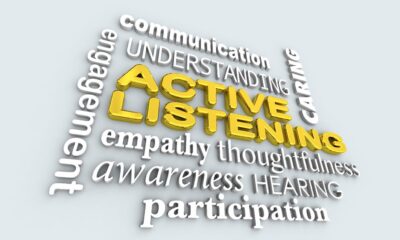
1. Client-Centric Communication: Professional service providers must tailor their communication to meet clients’ unique needs, preferences, and expectations. This involves active listening, empathy, and the ability to articulate complex concepts in an accessible manner. For instance, a legal advisor explaining intricate contractual terms to a non-legal client must ensure clarity without oversimplifying the content.
2. Precision and Clarity: Due to the technical and specialised nature of many professional services, ensuring accuracy and avoiding ambiguity are paramount. Miscommunication in these fields can lead to costly errors or reputational harm. Accountants, for example, must present financial data in a way that is both precise and comprehensible to clients with varying levels of financial literacy.
3. Relationship Building: Establishing strong client relationships requires consistent, transparent, and trustworthy communication practices. Trust is built over time through open dialogue and a genuine commitment to addressing client concerns. Regular updates and follow-ups are essential to keeping clients engaged and reassured.
4. Cultural Competence: In an increasingly globalised world, professional service providers must be adept at communicating across cultural boundaries. Understanding and respecting cultural nuances can strengthen client relationships and avoid misunderstandings. For example, being aware of cultural preferences for direct versus indirect communication styles can enhance rapport.
5. Adaptability: Professional service providers must navigate diverse communication styles, mediums, and client preferences. This includes being proficient in virtual communication tools and adapting to evolving client expectations. The shift to remote consultations during the COVID-19 pandemic highlighted the importance of adaptability in maintaining effective communication.
Effective communication in professional services also requires a balance between technical expertise and interpersonal skills. While technical knowledge is essential, the ability to convey that knowledge in a relatable and persuasive manner is what sets exceptional service providers apart. For instance, an architect presenting a design proposal must blend technical detail with a compelling narrative that resonates with the client’s vision and goals.
Influential Perspectives on Effective Communication
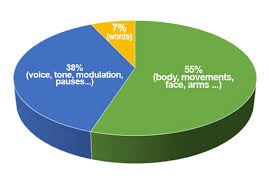
Numerous scholars and experts have shaped our understanding of effective communication:
1. Dale Carnegie: In his seminal work How to Win Friends and Influence People (1936), Carnegie emphasises the importance of empathy, active listening, and genuine interest in others as cornerstones of effective communication. Carnegie’s principles remain highly relevant, particularly in client-facing roles where building rapport is critical. He argues that understanding others’ perspectives and expressing sincere appreciation can transform relationships.
2. Albert Mehrabian: Mehrabian’s (1971) research highlights the significance of non-verbal communication, asserting that body language, tone, and facial expressions convey the majority of a message’s emotional content. This underscores the need for professional service providers to be mindful of their non-verbal cues during client interactions, particularly in face-to-face meetings where first impressions matter.
3. Edgar Schein: Schein’s studies on organisational culture underscore the role of communication in shaping workplace dynamics and fostering collaborative environments. His insights are particularly relevant in professional services, where teamwork and inter-departmental collaboration are common. Schein’s concept of “process consultation” highlights the importance of understanding and facilitating communication processes to achieve organisational goals.
4. Marshall B. Rosenberg: The developer of Nonviolent Communication (NVC), Rosenberg (1999), introduces a framework for compassionate and needs-based communication, which is particularly relevant in resolving conflicts. His principles encourage individuals to express themselves honestly while being empathetic to others’ perspectives. This approach is invaluable in high-stakes professional service scenarios where conflicts may arise.
5. Judith Glaser: In her book Conversational Intelligence (2016), Glaser explores how conversations shape organisational trust, innovation, and collaboration. Her research highlights the transformative power of effective conversations in building strong client relationships. She emphasises the importance of open, transparent, and trust-based dialogues to foster mutual understanding.
Expanding the Dimensions of Communication
To deepen our understanding, it is essential to explore the multifaceted nature of communication. Effective communication is not a monolithic skill but a dynamic interplay of various dimensions:
1. Verbal and Written Communication: While verbal communication allows for immediate feedback and clarification, written communication provides a permanent record and is crucial for detailed and formal exchanges. Mastering both is vital in professional services. Reports, proposals, and contracts must be meticulously crafted to convey key points without ambiguity.
2. Non-Verbal Communication: Non-verbal cues, including posture, eye contact, and gestures, significantly influence how messages are received and interpreted. Awareness of these cues can enhance the effectiveness of face-to-face interactions. For instance, maintaining eye contact during a presentation can convey confidence and credibility.
3. Emotional Intelligence: Effective communication requires high emotional intelligence, which involves recognising and managing one’s emotions while understanding and influencing others’ emotions. Emotional intelligence fosters trust and reduces conflicts. Professionals with strong emotional intelligence are better equipped to navigate challenging conversations with clients or colleagues.
4. Digital Communication: The rise of digital platforms has transformed the communication landscape. Professionals must be adept at using tools such as email, video conferencing, and collaborative platforms while maintaining etiquette and professionalism. Crafting concise yet comprehensive emails, for example, is an essential skill in maintaining clarity.
5. Cross-Cultural Communication: As globalisation continues to bring diverse cultures together, the ability to navigate cultural differences and adapt communication styles is increasingly important. Multinational teams and clients often require nuanced approaches to ensure inclusivity and respect.
Challenges in Achieving Effective Communication
While the benefits of effective communication are widely acknowledged, achieving it consistently can be challenging. Common barriers include:
1. Cultural Differences: Misunderstandings arising from diverse cultural norms and communication styles can hinder interactions. For instance, a direct communication style may be perceived as assertive in one culture but confrontational in another.
2. Technological Overload: The proliferation of digital tools can dilute the quality of communication and lead to information fatigue. Over-reliance on emails and instant messaging may reduce the effectiveness of face-to-face or voice interactions.
3. Emotional Biases: Personal biases and emotions can distort messages and hinder objective interpretation. Awareness and management of these biases are essential for clear communication.
4. Time Constraints: Limited time often results in rushed or incomplete communication, leading to misunderstandings and errors. Allocating sufficient time for critical conversations is essential.
5. Language Barriers: In multinational environments, language differences can pose significant challenges. Simplifying language and using visuals can help bridge this gap.
Workshop Activities
Participants in this workshop will engage in a variety of interactive and practical exercises designed to enhance their communication skills in professional contexts. Below is an outline of what participants can expect:
1. Active Listening Exercises:
Participants will practice techniques such as maintaining eye contact, summarising others’ points, and asking clarifying questions. Role-playing scenarios will help them navigate common communication challenges, such as distractions and emotional biases. Through guided feedback, they will improve their ability to interpret verbal and non-verbal cues.
2. Building Trust and Rapport:
Attendees will engage in trust-building exercises that involve both verbal and non-verbal communication. Activities will focus on fostering empathy, demonstrating reliability, and using positive body language to strengthen professional relationships.
3. Effective Questioning Workshops:
Participants will learn to ask open-ended, probing, and strategic questions to better understand client needs and expectations. Interactive group discussions will allow them to experiment with different questioning techniques and receive constructive feedback.
4. Personal Communication Style Analysis:
Through self-assessment tools and peer feedback, participants will identify their communication strengths and areas for improvement. Activities will include adapting their communication style to various scenarios and audiences to ensure effectiveness.
5. Feedback Exchange Simulations:
Attendees will practice giving and receiving constructive feedback in a controlled environment. Scenarios will range from performance reviews to addressing interpersonal conflicts, focusing on maintaining professionalism and fostering a growth-oriented mindset.
6. Non-Verbal Communication Training:
Exercises will explore the interpretation of facial expressions, gestures, and posture in both face-to-face and virtual settings. Participants will refine their ability to use non-verbal cues to complement verbal messages, ensuring clarity and engagement.
7. Dealing with Difficult Conversations:
Role-play activities will simulate challenging communication scenarios, such as conflict resolution and high-pressure negotiations. Participants will develop strategies for maintaining composure and achieving positive outcomes under stress.
8. Presentation Skills Development:
Attendees will prepare and deliver short presentations, focusing on structuring content, engaging the audience, and handling questions effectively. Feedback sessions will help refine their delivery and enhance confidence.
9. Virtual Communication Mastery:
Participants will learn best practices for effective remote communication, including using digital tools, managing virtual meetings, and addressing common challenges like time zones and technical issues. They will practice creating engaging virtual presentations and fostering collaboration in digital spaces.
Preparing for the Workshop
To maximise the workshop experience, participants should take the following preparatory steps:
1. Reflect on Communication Challenges:
Identify specific situations where communication has been challenging, such as misunderstandings, conflicts, or presenting complex ideas. Reflecting on these experiences will provide context for applying workshop strategies.
2. Assess Personal Communication Skills:
Take note of personal strengths and weaknesses in communication. Consider seeking informal feedback from colleagues or friends to identify areas for improvement.
3. Familiarise with Workshop Topics:
Reviewing foundational concepts like active listening, non-verbal communication, and feedback techniques will enhance comprehension during the workshop. Participants may find it helpful to read books or articles by influential authors such as Dale Carnegie or Judith Glaser.
4. Prepare Relevant Scenarios:
Bring examples of real-life challenges, such as client interactions, team conflicts, or presentation issues. These examples will serve as valuable input for role-play exercises and discussions.
5. Test Technology:
For virtual communication segments, ensure familiarity with video conferencing platforms and collaborative tools. Testing audio, video, and internet connectivity will help avoid technical disruptions during the workshop.
6. Adopt a Growth Mindset:
Approach the workshop with an openness to learning and a willingness to experiment with new communication strategies. Being receptive to feedback and actively participating will enhance the overall experience.
By engaging in these preparatory steps and fully participating in the workshop activities, attendees will gain actionable skills to transform their professional communication.
Executive Summary
Professional services organisations are paid for their insights, so need to communicate very well. The prior module highlighted this need as a significant determinant of trust in the relationship between professional services providers and their clients. To achieve this, participants will learn how to use active listening techniques, adopt behaviours to enhance working relationships and use effective questioning skills. Participants can also expect to identify and develop their own personal communication style. Skills around giving and receiving appropriate feedback will also be explored, as well how to deal with difficult communication situations.
Chapter 1: Active Listening Techniques
Active listening is essential for professional communication, involving fully concentrating, understanding, and responding thoughtfully to others. Understanding active listening includes recognising its role in building trust and clarity, as well as interpreting both verbal and non-verbal cues. Practising active listening skills involves techniques like maintaining eye contact, nodding, summarising points, and asking clarifying questions. Overcoming barriers to effective listening requires addressing distractions, managing personal biases, and ensuring an open, conducive environment. By focusing on these sub-topics, professionals can enhance their ability to listen actively, fostering better client relationships and more effective, meaningful communication.
Chapter 2: Building Trust and Rapport
Building trust and rapport in professional relationships is crucial for collaboration, productivity, and overall success. Trust is the foundation of any effective relationship, fostering open communication and mutual respect. Strategies for building trust include consistent honesty, reliability, and transparency. Actively listening and showing empathy further strengthen connections. Non-verbal communication, such as maintaining eye contact, offering genuine smiles, and using open body language, also plays a significant role in building rapport. Positive body language can convey sincerity and openness, reinforcing verbal messages. Maintaining trust involves continual commitment to these practices, demonstrating integrity and respect in all interactions.
Chapter 3: Effective Questioning Skills
Effective questioning skills are essential for gaining insights and understanding client needs. The types of questions asked play a crucial role: open-ended questions encourage detailed responses, closed-ended questions provide specific information, and probing questions delve deeper into topics. Techniques for asking effective questions include being clear and concise, avoiding leading questions, and using active listening to follow up appropriately. Questions should be used strategically to clarify and understand client needs, ensuring that all aspects of their concerns are addressed. This approach fosters better communication, builds trust, and ensures that the solutions provided are well-suited to the client’s requirements.
Chapter 4: Developing Personal Communication Style
Developing a personal communication style involves recognising your strengths and weaknesses in communication. Understanding your own tendencies allows you to leverage strengths and work on areas needing improvement. Adapting communication styles to different situations and audiences is crucial; what works in one context may not be effective in another. Enhancing self-awareness and emotional intelligence is fundamental in this process, as it helps you understand and manage your emotions, as well as empathise with others. This heightened awareness enables more thoughtful and effective interactions, fostering better relationships and more successful communication across various settings.
Chapter 5: Giving Constructive Feedback
Giving constructive feedback involves adhering to key principles: focus on specific behaviours, be objective, and aim for a balance between positive and negative feedback. Techniques for delivering feedback effectively include using “I” statements to express your perspective, ensuring the timing is appropriate, and being clear and concise. It’s also helpful to offer suggestions for improvement. Handling reactions to feedback requires empathy and active listening; acknowledge the recipient’s feelings and be prepared for possible defensive responses. By maintaining a supportive and respectful approach, you can foster an environment where feedback is seen as an opportunity for growth and improvement.
Chapter 6: Receiving Feedback Positively
Receiving feedback positively involves actively encouraging and welcoming it, demonstrating an openness to learning and improvement. Techniques for processing and responding to feedback include listening attentively without interrupting, reflecting on the feedback before responding, and asking clarifying questions if needed. It’s essential to manage defensive reactions and approach feedback with a growth mindset. Using feedback for personal and professional growth involves identifying actionable steps based on the feedback, setting goals for improvement, and continuously monitoring progress. Embracing feedback as a tool for development fosters resilience, enhances skills, and contributes to ongoing success in various areas of life.
Chapter 7: Non-Verbal Communication Skills
Non-verbal communication skills are crucial for effective interaction. Understanding the role of non-verbal cues, such as facial expressions, gestures, and posture, enhances the depth of communication. Interpreting and using body language effectively involves being aware of your own non-verbal signals and accurately reading those of others to ensure messages are conveyed clearly and accurately. Managing non-verbal signals in virtual communication requires attention to elements like eye contact, facial expressions, and tone of voice, even through a screen. Adjusting lighting, camera angles, and maintaining an engaged posture can help convey attentiveness and professionalism in virtual settings.
Chapter 8: Building Working Relationships
Building and enhancing working relationships is essential for a productive and harmonious workplace. Strategies for effective teamwork and collaboration include open communication, setting clear goals, and leveraging individual strengths. Regular team meetings and collaborative tools can also enhance coordination. Managing and resolving conflicts involves addressing issues promptly, actively listening to all parties, and seeking mutually beneficial solutions. It’s important to approach conflicts with empathy and a problem-solving mindset. Creating a positive and inclusive work environment requires promoting diversity, encouraging respect, and recognising contributions from all team members. This fosters a sense of belonging and motivates employees to perform their best.
Chapter 9: Dealing with Difficult Communication Situations
Dealing with difficult communication situations requires identifying and understanding challenging scenarios, such as misunderstandings, conflicts, or high-stakes conversations. Recognising these situations early can help in preparing an appropriate response. Techniques for managing and diffusing conflicts include active listening, maintaining a calm and respectful tone, and seeking common ground. It’s important to address issues directly but tactfully, avoiding blame and focusing on solutions. Communicating under stress and pressure involves staying composed, being clear and concise, and prioritising key points. Practising stress management techniques, such as deep breathing and pausing before responding, can also help maintain effectiveness in high-pressure situations.
Chapter 10: Persuasive Communication Skills
Persuasive communication techniques are essential for influencing and motivating others. Crafting compelling messages involves presenting clear, concise, and well-structured information that highlights benefits and appeals to the audience’s values and needs. Using persuasive language and techniques, such as storytelling, rhetorical questions, and emotional appeals, can enhance the impact of your message. Tailoring messages to different stakeholders requires understanding their perspectives, priorities, and concerns, and adapting your communication style accordingly. By addressing their specific interests and demonstrating how your proposal aligns with their goals, you can build stronger connections and increase the likelihood of achieving your desired outcome.
Chapter 11: Presentation Skills
Effective presentation skills are vital for conveying ideas clearly and persuasively. Structuring and delivering impactful presentations involves organising content logically, using visual aids effectively, and practising confident delivery. Engaging and maintaining audience interest can be achieved through storytelling, interactive elements, and varying vocal tone and pace. It’s important to connect with the audience by making eye contact and using body language that conveys enthusiasm and confidence. Handling questions and feedback during presentations requires active listening, responding thoughtfully, and being prepared for a range of queries. This ensures a dynamic and interactive presentation experience, enhancing overall effectiveness.
Chapter 12: Communication in Virtual Environments
Communication in virtual environments requires adapting to unique challenges and leveraging technology effectively. Best practices for virtual meetings and communication include setting clear agendas, ensuring reliable technology, and fostering active participation. Overcoming challenges of remote communication involves addressing issues like time zone differences and potential misunderstandings by promoting clear, concise communication and regular check-ins. Using digital tools, such as video conferencing platforms, collaborative software, and instant messaging apps, can enhance virtual interactions. These tools facilitate real-time collaboration, document sharing, and maintain team cohesion. By embracing these strategies, remote communication can be as effective and engaging as face-to-face interactions.
Curriculum
Professional Services Advisor – WDP2 – Effective Communication
-
Creating an effective communication training program for professional services organisations requires covering a comprehensive range of topics. Here is a list of twelve essential topic areas covered:
1. Active Listening Techniques:
o Understanding active listening
o Practicing active listening skills
o Overcoming barriers to effective listening
2. Building Trust and Rapport:
o Importance of trust in professional relationships
o Strategies for building and maintaining trust
o Non-verbal communication and body language
3. Effective Questioning Skills:
o Types of questions (open-ended, closed-ended, probing)
o Techniques for asking effective questions
o Using questions to clarify and understand client needs
4. Developing Personal Communication Style:
o Identifying personal communication strengths and weaknesses
o Adapting communication styles to different situations and audiences
o Enhancing self-awareness and emotional intelligence
5. Giving Constructive Feedback:
o Principles of giving constructive feedback
o Techniques for delivering feedback effectively
o Handling reactions to feedback
6. Receiving Feedback Positively:
o Encouraging and welcoming feedback
o Techniques for processing and responding to feedback
o Using feedback for personal and professional growth
7. Non-Verbal Communication Skills:
o Understanding the role of non-verbal cues in communication
o Interpreting and using body language effectively
o Managing non-verbal signals in virtual communication
8. Building and Enhancing Working Relationships:
o Strategies for effective teamwork and collaboration
o Managing and resolving conflicts
o Creating a positive and inclusive work environment
9. Dealing with Difficult Communication Situations:
o Identifying and understanding difficult communication scenarios
o Techniques for managing and diffusing conflicts
o Communicating under stress and pressure
10. Persuasive Communication Techniques:
o Crafting compelling messages
o Using persuasive language and techniques
o Tailoring messages to different stakeholders
11. Presentation Skills:
o Structuring and delivering impactful presentations
o Engaging and maintaining audience interest
o Handling questions and feedback during presentations
12. Communication in Virtual Environments:
o Best practices for virtual meetings and communication
o Overcoming challenges of remote communication
o Using digital tools to enhance virtual interactions
These topics cover the essential skills and techniques required for effective communication in professional services, ensuring participants can build trust, manage relationships, and navigate various communication challenges proficiently.
Distance Learning
Introduction
Welcome to Appleton Greene and thank you for enrolling on the Professional Services Advisor corporate training program. You will be learning through our unique facilitation via distance-learning method, which will enable you to practically implement everything that you learn academically. The methods and materials used in your program have been designed and developed to ensure that you derive the maximum benefits and enjoyment possible. We hope that you find the program challenging and fun to do. However, if you have never been a distance-learner before, you may be experiencing some trepidation at the task before you. So we will get you started by giving you some basic information and guidance on how you can make the best use of the modules, how you should manage the materials and what you should be doing as you work through them. This guide is designed to point you in the right direction and help you to become an effective distance-learner. Take a few hours or so to study this guide and your guide to tutorial support for students, while making notes, before you start to study in earnest.
Study environment
You will need to locate a quiet and private place to study, preferably a room where you can easily be isolated from external disturbances or distractions. Make sure the room is well-lit and incorporates a relaxed, pleasant feel. If you can spoil yourself within your study environment, you will have much more of a chance to ensure that you are always in the right frame of mind when you do devote time to study. For example, a nice fire, the ability to play soft soothing background music, soft but effective lighting, perhaps a nice view if possible and a good size desk with a comfortable chair. Make sure that your family know when you are studying and understand your study rules. Your study environment is very important. The ideal situation, if at all possible, is to have a separate study, which can be devoted to you. If this is not possible then you will need to pay a lot more attention to developing and managing your study schedule, because it will affect other people as well as yourself. The better your study environment, the more productive you will be.
Study tools & rules
Try and make sure that your study tools are sufficient and in good working order. You will need to have access to a computer, scanner and printer, with access to the internet. You will need a very comfortable chair, which supports your lower back, and you will need a good filing system. It can be very frustrating if you are spending valuable study time trying to fix study tools that are unreliable, or unsuitable for the task. Make sure that your study tools are up to date. You will also need to consider some study rules. Some of these rules will apply to you and will be intended to help you to be more disciplined about when and how you study. This distance-learning guide will help you and after you have read it you can put some thought into what your study rules should be. You will also need to negotiate some study rules for your family, friends or anyone who lives with you. They too will need to be disciplined in order to ensure that they can support you while you study. It is important to ensure that your family and friends are an integral part of your study team. Having their support and encouragement can prove to be a crucial contribution to your successful completion of the program. Involve them in as much as you can.
Successful distance-learning
Distance-learners are freed from the necessity of attending regular classes or workshops, since they can study in their own way, at their own pace and for their own purposes. But unlike traditional internal training courses, it is the student’s responsibility, with a distance-learning program, to ensure that they manage their own study contribution. This requires strong self-discipline and self-motivation skills and there must be a clear will to succeed. Those students who are used to managing themselves, are good at managing others and who enjoy working in isolation, are more likely to be good distance-learners. It is also important to be aware of the main reasons why you are studying and of the main objectives that you are hoping to achieve as a result. You will need to remind yourself of these objectives at times when you need to motivate yourself. Never lose sight of your long-term goals and your short-term objectives. There is nobody available here to pamper you, or to look after you, or to spoon-feed you with information, so you will need to find ways to encourage and appreciate yourself while you are studying. Make sure that you chart your study progress, so that you can be sure of your achievements and re-evaluate your goals and objectives regularly.
Self-assessment
Appleton Greene training programs are in all cases post-graduate programs. Consequently, you should already have obtained a business-related degree and be an experienced learner. You should therefore already be aware of your study strengths and weaknesses. For example, which time of the day are you at your most productive? Are you a lark or an owl? What study methods do you respond to the most? Are you a consistent learner? How do you discipline yourself? How do you ensure that you enjoy yourself while studying? It is important to understand yourself as a learner and so some self-assessment early on will be necessary if you are to apply yourself correctly. Perform a SWOT analysis on yourself as a student. List your internal strengths and weaknesses as a student and your external opportunities and threats. This will help you later on when you are creating a study plan. You can then incorporate features within your study plan that can ensure that you are playing to your strengths, while compensating for your weaknesses. You can also ensure that you make the most of your opportunities, while avoiding the potential threats to your success.
Accepting responsibility as a student
Training programs invariably require a significant investment, both in terms of what they cost and in the time that you need to contribute to study and the responsibility for successful completion of training programs rests entirely with the student. This is never more apparent than when a student is learning via distance-learning. Accepting responsibility as a student is an important step towards ensuring that you can successfully complete your training program. It is easy to instantly blame other people or factors when things go wrong. But the fact of the matter is that if a failure is your failure, then you have the power to do something about it, it is entirely in your own hands. If it is always someone else’s failure, then you are powerless to do anything about it. All students study in entirely different ways, this is because we are all individuals and what is right for one student, is not necessarily right for another. In order to succeed, you will have to accept personal responsibility for finding a way to plan, implement and manage a personal study plan that works for you. If you do not succeed, you only have yourself to blame.
Planning
By far the most critical contribution to stress, is the feeling of not being in control. In the absence of planning we tend to be reactive and can stumble from pillar to post in the hope that things will turn out fine in the end. Invariably they don’t! In order to be in control, we need to have firm ideas about how and when we want to do things. We also need to consider as many possible eventualities as we can, so that we are prepared for them when they happen. Prescriptive Change, is far easier to manage and control, than Emergent Change. The same is true with distance-learning. It is much easier and much more enjoyable, if you feel that you are in control and that things are going to plan. Even when things do go wrong, you are prepared for them and can act accordingly without any unnecessary stress. It is important therefore that you do take time to plan your studies properly.
Management
Once you have developed a clear study plan, it is of equal importance to ensure that you manage the implementation of it. Most of us usually enjoy planning, but it is usually during implementation when things go wrong. Targets are not met and we do not understand why. Sometimes we do not even know if targets are being met. It is not enough for us to conclude that the study plan just failed. If it is failing, you will need to understand what you can do about it. Similarly if your study plan is succeeding, it is still important to understand why, so that you can improve upon your success. You therefore need to have guidelines for self-assessment so that you can be consistent with performance improvement throughout the program. If you manage things correctly, then your performance should constantly improve throughout the program.
Study objectives & tasks
The first place to start is developing your program objectives. These should feature your reasons for undertaking the training program in order of priority. Keep them succinct and to the point in order to avoid confusion. Do not just write the first things that come into your head because they are likely to be too similar to each other. Make a list of possible departmental headings, such as: Customer Service; E-business; Finance; Globalization; Human Resources; Technology; Legal; Management; Marketing and Production. Then brainstorm for ideas by listing as many things that you want to achieve under each heading and later re-arrange these things in order of priority. Finally, select the top item from each department heading and choose these as your program objectives. Try and restrict yourself to five because it will enable you to focus clearly. It is likely that the other things that you listed will be achieved if each of the top objectives are achieved. If this does not prove to be the case, then simply work through the process again.
Study forecast
As a guide, the Appleton Greene Professional Services Advisor corporate training program should take 12-18 months to complete, depending upon your availability and current commitments. The reason why there is such a variance in time estimates is because every student is an individual, with differing productivity levels and different commitments. These differentiations are then exaggerated by the fact that this is a distance-learning program, which incorporates the practical integration of academic theory as an as a part of the training program. Consequently all of the project studies are real, which means that important decisions and compromises need to be made. You will want to get things right and will need to be patient with your expectations in order to ensure that they are. We would always recommend that you are prudent with your own task and time forecasts, but you still need to develop them and have a clear indication of what are realistic expectations in your case. With reference to your time planning: consider the time that you can realistically dedicate towards study with the program every week; calculate how long it should take you to complete the program, using the guidelines featured here; then break the program down into logical modules and allocate a suitable proportion of time to each of them, these will be your milestones; you can create a time plan by using a spreadsheet on your computer, or a personal organizer such as MS Outlook, you could also use a financial forecasting software; break your time forecasts down into manageable chunks of time, the more specific you can be, the more productive and accurate your time management will be; finally, use formulas where possible to do your time calculations for you, because this will help later on when your forecasts need to change in line with actual performance. With reference to your task planning: refer to your list of tasks that need to be undertaken in order to achieve your program objectives; with reference to your time plan, calculate when each task should be implemented; remember that you are not estimating when your objectives will be achieved, but when you will need to focus upon implementing the corresponding tasks; you also need to ensure that each task is implemented in conjunction with the associated training modules which are relevant; then break each single task down into a list of specific to do’s, say approximately ten to do’s for each task and enter these into your study plan; once again you could use MS Outlook to incorporate both your time and task planning and this could constitute your study plan; you could also use a project management software like MS Project. You should now have a clear and realistic forecast detailing when you can expect to be able to do something about undertaking the tasks to achieve your program objectives.
Performance management
It is one thing to develop your study forecast, it is quite another to monitor your progress. Ultimately it is less important whether you achieve your original study forecast and more important that you update it so that it constantly remains realistic in line with your performance. As you begin to work through the program, you will begin to have more of an idea about your own personal performance and productivity levels as a distance-learner. Once you have completed your first study module, you should re-evaluate your study forecast for both time and tasks, so that they reflect your actual performance level achieved. In order to achieve this you must first time yourself while training by using an alarm clock. Set the alarm for hourly intervals and make a note of how far you have come within that time. You can then make a note of your actual performance on your study plan and then compare your performance against your forecast. Then consider the reasons that have contributed towards your performance level, whether they are positive or negative and make a considered adjustment to your future forecasts as a result. Given time, you should start achieving your forecasts regularly.
With reference to time management: time yourself while you are studying and make a note of the actual time taken in your study plan; consider your successes with time-efficiency and the reasons for the success in each case and take this into consideration when reviewing future time planning; consider your failures with time-efficiency and the reasons for the failures in each case and take this into consideration when reviewing future time planning; re-evaluate your study forecast in relation to time planning for the remainder of your training program to ensure that you continue to be realistic about your time expectations. You need to be consistent with your time management, otherwise you will never complete your studies. This will either be because you are not contributing enough time to your studies, or you will become less efficient with the time that you do allocate to your studies. Remember, if you are not in control of your studies, they can just become yet another cause of stress for you.
With reference to your task management: time yourself while you are studying and make a note of the actual tasks that you have undertaken in your study plan; consider your successes with task-efficiency and the reasons for the success in each case; take this into consideration when reviewing future task planning; consider your failures with task-efficiency and the reasons for the failures in each case and take this into consideration when reviewing future task planning; re-evaluate your study forecast in relation to task planning for the remainder of your training program to ensure that you continue to be realistic about your task expectations. You need to be consistent with your task management, otherwise you will never know whether you are achieving your program objectives or not.
Keeping in touch
You will have access to qualified and experienced professors and tutors who are responsible for providing tutorial support for your particular training program. So don’t be shy about letting them know how you are getting on. We keep electronic records of all tutorial support emails so that professors and tutors can review previous correspondence before considering an individual response. It also means that there is a record of all communications between you and your professors and tutors and this helps to avoid any unnecessary duplication, misunderstanding, or misinterpretation. If you have a problem relating to the program, share it with them via email. It is likely that they have come across the same problem before and are usually able to make helpful suggestions and steer you in the right direction. To learn more about when and how to use tutorial support, please refer to the Tutorial Support section of this student information guide. This will help you to ensure that you are making the most of tutorial support that is available to you and will ultimately contribute towards your success and enjoyment with your training program.
Work colleagues and family
You should certainly discuss your program study progress with your colleagues, friends and your family. Appleton Greene training programs are very practical. They require you to seek information from other people, to plan, develop and implement processes with other people and to achieve feedback from other people in relation to viability and productivity. You will therefore have plenty of opportunities to test your ideas and enlist the views of others. People tend to be sympathetic towards distance-learners, so don’t bottle it all up in yourself. Get out there and share it! It is also likely that your family and colleagues are going to benefit from your labors with the program, so they are likely to be much more interested in being involved than you might think. Be bold about delegating work to those who might benefit themselves. This is a great way to achieve understanding and commitment from people who you may later rely upon for process implementation. Share your experiences with your friends and family.
Making it relevant
The key to successful learning is to make it relevant to your own individual circumstances. At all times you should be trying to make bridges between the content of the program and your own situation. Whether you achieve this through quiet reflection or through interactive discussion with your colleagues, client partners or your family, remember that it is the most important and rewarding aspect of translating your studies into real self-improvement. You should be clear about how you want the program to benefit you. This involves setting clear study objectives in relation to the content of the course in terms of understanding, concepts, completing research or reviewing activities and relating the content of the modules to your own situation. Your objectives may understandably change as you work through the program, in which case you should enter the revised objectives on your study plan so that you have a permanent reminder of what you are trying to achieve, when and why.
Distance-learning check-list
Prepare your study environment, your study tools and rules.
Undertake detailed self-assessment in terms of your ability as a learner.
Create a format for your study plan.
Consider your study objectives and tasks.
Create a study forecast.
Assess your study performance.
Re-evaluate your study forecast.
Be consistent when managing your study plan.
Use your Appleton Greene Certified Learning Provider (CLP) for tutorial support.
Make sure you keep in touch with those around you.

Tutorial Support
Programs
Appleton Greene uses standard and bespoke corporate training programs as vessels to transfer business process improvement knowledge into the heart of our clients’ organizations. Each individual program focuses upon the implementation of a specific business process, which enables clients to easily quantify their return on investment. There are hundreds of established Appleton Greene corporate training products now available to clients within customer services, e-business, finance, globalization, human resources, information technology, legal, management, marketing and production. It does not matter whether a client’s employees are located within one office, or an unlimited number of international offices, we can still bring them together to learn and implement specific business processes collectively. Our approach to global localization enables us to provide clients with a truly international service with that all important personal touch. Appleton Greene corporate training programs can be provided virtually or locally and they are all unique in that they individually focus upon a specific business function. They are implemented over a sustainable period of time and professional support is consistently provided by qualified learning providers and specialist consultants.
Support available
You will have a designated Certified Learning Provider (CLP) and an Accredited Consultant and we encourage you to communicate with them as much as possible. In all cases tutorial support is provided online because we can then keep a record of all communications to ensure that tutorial support remains consistent. You would also be forwarding your work to the tutorial support unit for evaluation and assessment. You will receive individual feedback on all of the work that you undertake on a one-to-one basis, together with specific recommendations for anything that may need to be changed in order to achieve a pass with merit or a pass with distinction and you then have as many opportunities as you may need to re-submit project studies until they meet with the required standard. Consequently the only reason that you should really fail (CLP) is if you do not do the work. It makes no difference to us whether a student takes 12 months or 18 months to complete the program, what matters is that in all cases the same quality standard will have been achieved.
Support Process
Please forward all of your future emails to the designated (CLP) Tutorial Support Unit email address that has been provided and please do not duplicate or copy your emails to other AGC email accounts as this will just cause unnecessary administration. Please note that emails are always answered as quickly as possible but you will need to allow a period of up to 20 business days for responses to general tutorial support emails during busy periods, because emails are answered strictly within the order in which they are received. You will also need to allow a period of up to 30 business days for the evaluation and assessment of project studies. This does not include weekends or public holidays. Please therefore kindly allow for this within your time planning. All communications are managed online via email because it enables tutorial service support managers to review other communications which have been received before responding and it ensures that there is a copy of all communications retained on file for future reference. All communications will be stored within your personal (CLP) study file here at Appleton Greene throughout your designated study period. If you need any assistance or clarification at any time, please do not hesitate to contact us by forwarding an email and remember that we are here to help. If you have any questions, please list and number your questions succinctly and you can then be sure of receiving specific answers to each and every query.
Time Management
It takes approximately 1 Year to complete the Professional Services Advisor corporate training program, incorporating 12 x 6-hour monthly workshops. Each student will also need to contribute approximately 4 hours per week over 1 Year of their personal time. Students can study from home or work at their own pace and are responsible for managing their own study plan. There are no formal examinations and students are evaluated and assessed based upon their project study submissions, together with the quality of their internal analysis and supporting documents. They can contribute more time towards study when they have the time to do so and can contribute less time when they are busy. All students tend to be in full time employment while studying and the Professional Services Advisor program is purposely designed to accommodate this, so there is plenty of flexibility in terms of time management. It makes no difference to us at Appleton Greene, whether individuals take 12-18 months to complete this program. What matters is that in all cases the same standard of quality will have been achieved with the standard and bespoke programs that have been developed.
Distance Learning Guide
The distance learning guide should be your first port of call when starting your training program. It will help you when you are planning how and when to study, how to create the right environment and how to establish the right frame of mind. If you can lay the foundations properly during the planning stage, then it will contribute to your enjoyment and productivity while training later. The guide helps to change your lifestyle in order to accommodate time for study and to cultivate good study habits. It helps you to chart your progress so that you can measure your performance and achieve your goals. It explains the tools that you will need for study and how to make them work. It also explains how to translate academic theory into practical reality. Spend some time now working through your distance learning guide and make sure that you have firm foundations in place so that you can make the most of your distance learning program. There is no requirement for you to attend training workshops or classes at Appleton Greene offices. The entire program is undertaken online, program course manuals and project studies are administered via the Appleton Greene web site and via email, so you are able to study at your own pace and in the comfort of your own home or office as long as you have a computer and access to the internet.
How To Study
The how to study guide provides students with a clear understanding of the Appleton Greene facilitation via distance learning training methods and enables students to obtain a clear overview of the training program content. It enables students to understand the step-by-step training methods used by Appleton Greene and how course manuals are integrated with project studies. It explains the research and development that is required and the need to provide evidence and references to support your statements. It also enables students to understand precisely what will be required of them in order to achieve a pass with merit and a pass with distinction for individual project studies and provides useful guidance on how to be innovative and creative when developing your Unique Program Proposition (UPP).
Tutorial Support
Tutorial support for the Appleton Greene Professional Services Advisor corporate training program is provided online either through the Appleton Greene Client Support Portal (CSP), or via email. All tutorial support requests are facilitated by a designated Program Administration Manager (PAM). They are responsible for deciding which professor or tutor is the most appropriate option relating to the support required and then the tutorial support request is forwarded onto them. Once the professor or tutor has completed the tutorial support request and answered any questions that have been asked, this communication is then returned to the student via email by the designated Program Administration Manager (PAM). This enables all tutorial support, between students, professors and tutors, to be facilitated by the designated Program Administration Manager (PAM) efficiently and securely through the email account. You will therefore need to allow a period of up to 20 business days for responses to general support queries and up to 30 business days for the evaluation and assessment of project studies, because all tutorial support requests are answered strictly within the order in which they are received. This does not include weekends or public holidays. Consequently you need to put some thought into the management of your tutorial support procedure in order to ensure that your study plan is feasible and to obtain the maximum possible benefit from tutorial support during your period of study. Please retain copies of your tutorial support emails for future reference. Please ensure that ALL of your tutorial support emails are set out using the format as suggested within your guide to tutorial support. Your tutorial support emails need to be referenced clearly to the specific part of the course manual or project study which you are working on at any given time. You also need to list and number any questions that you would like to ask, up to a maximum of five questions within each tutorial support email. Remember the more specific you can be with your questions the more specific your answers will be too and this will help you to avoid any unnecessary misunderstanding, misinterpretation, or duplication. The guide to tutorial support is intended to help you to understand how and when to use support in order to ensure that you get the most out of your training program. Appleton Greene training programs are designed to enable you to do things for yourself. They provide you with a structure or a framework and we use tutorial support to facilitate students while they practically implement what they learn. In other words, we are enabling students to do things for themselves. The benefits of distance learning via facilitation are considerable and are much more sustainable in the long-term than traditional short-term knowledge sharing programs. Consequently you should learn how and when to use tutorial support so that you can maximize the benefits from your learning experience with Appleton Greene. This guide describes the purpose of each training function and how to use them and how to use tutorial support in relation to each aspect of the training program. It also provides useful tips and guidance with regard to best practice.
Tutorial Support Tips
Students are often unsure about how and when to use tutorial support with Appleton Greene. This Tip List will help you to understand more about how to achieve the most from using tutorial support. Refer to it regularly to ensure that you are continuing to use the service properly. Tutorial support is critical to the success of your training experience, but it is important to understand when and how to use it in order to maximize the benefit that you receive. It is no coincidence that those students who succeed are those that learn how to be positive, proactive and productive when using tutorial support.
Be positive and friendly with your tutorial support emails
Remember that if you forward an email to the tutorial support unit, you are dealing with real people. “Do unto others as you would expect others to do unto you”. If you are positive, complimentary and generally friendly in your emails, you will generate a similar response in return. This will be more enjoyable, productive and rewarding for you in the long-term.
Think about the impression that you want to create
Every time that you communicate, you create an impression, which can be either positive or negative, so put some thought into the impression that you want to create. Remember that copies of all tutorial support emails are stored electronically and tutors will always refer to prior correspondence before responding to any current emails. Over a period of time, a general opinion will be arrived at in relation to your character, attitude and ability. Try to manage your own frustrations, mood swings and temperament professionally, without involving the tutorial support team. Demonstrating frustration or a lack of patience is a weakness and will be interpreted as such. The good thing about communicating in writing, is that you will have the time to consider your content carefully, you can review it and proof-read it before sending your email to Appleton Greene and this should help you to communicate more professionally, consistently and to avoid any unnecessary knee-jerk reactions to individual situations as and when they may arise. Please also remember that the CLP Tutorial Support Unit will not just be responsible for evaluating and assessing the quality of your work, they will also be responsible for providing recommendations to other learning providers and to client contacts within the Appleton Greene global client network, so do be in control of your own emotions and try to create a good impression.
Remember that quality is preferred to quantity
Please remember that when you send an email to the tutorial support team, you are not using Twitter or Text Messaging. Try not to forward an email every time that you have a thought. This will not prove to be productive either for you or for the tutorial support team. Take time to prepare your communications properly, as if you were writing a professional letter to a business colleague and make a list of queries that you are likely to have and then incorporate them within one email, say once every month, so that the tutorial support team can understand more about context, application and your methodology for study. Get yourself into a consistent routine with your tutorial support requests and use the tutorial support template provided with ALL of your emails. The (CLP) Tutorial Support Unit will not spoon-feed you with information. They need to be able to evaluate and assess your tutorial support requests carefully and professionally.
Be specific about your questions in order to receive specific answers
Try not to write essays by thinking as you are writing tutorial support emails. The tutorial support unit can be unclear about what in fact you are asking, or what you are looking to achieve. Be specific about asking questions that you want answers to. Number your questions. You will then receive specific answers to each and every question. This is the main purpose of tutorial support via email.
Keep a record of your tutorial support emails
It is important that you keep a record of all tutorial support emails that are forwarded to you. You can then refer to them when necessary and it avoids any unnecessary duplication, misunderstanding, or misinterpretation.
Individual training workshops or telephone support
Please be advised that Appleton Greene does not provide separate or individual tutorial support meetings, workshops, or provide telephone support for individual students. Appleton Greene is an equal opportunities learning and service provider and we are therefore understandably bound to treat all students equally. We cannot therefore broker special financial or study arrangements with individual students regardless of the circumstances. All tutorial support is provided online and this enables Appleton Greene to keep a record of all communications between students, professors and tutors on file for future reference, in accordance with our quality management procedure and your terms and conditions of enrolment. All tutorial support is provided online via email because it enables us to have time to consider support content carefully, it ensures that you receive a considered and detailed response to your queries. You can number questions that you would like to ask, which relate to things that you do not understand or where clarification may be required. You can then be sure of receiving specific answers to each individual query. You will also then have a record of these communications and of all tutorial support, which has been provided to you. This makes tutorial support administration more productive by avoiding any unnecessary duplication, misunderstanding, or misinterpretation.
Tutorial Support Email Format
You should use this tutorial support format if you need to request clarification or assistance while studying with your training program. Please note that ALL of your tutorial support request emails should use the same format. You should therefore set up a standard email template, which you can then use as and when you need to. Emails that are forwarded to Appleton Greene, which do not use the following format, may be rejected and returned to you by the (CLP) Program Administration Manager. A detailed response will then be forwarded to you via email usually within 20 business days of receipt for general support queries and 30 business days for the evaluation and assessment of project studies. This does not include weekends or public holidays. Your tutorial support request, together with the corresponding TSU reply, will then be saved and stored within your electronic TSU file at Appleton Greene for future reference.
Subject line of your email
Please insert: Appleton Greene (CLP) Tutorial Support Request: (Your Full Name) (Date), within the subject line of your email.
Main body of your email
Please insert:
1. Appleton Greene Certified Learning Provider (CLP) Tutorial Support Request
2. Your Full Name
3. Date of TS request
4. Preferred email address
5. Backup email address
6. Course manual page name or number (reference)
7. Project study page name or number (reference)
Subject of enquiry
Please insert a maximum of 50 words (please be succinct)
Briefly outline the subject matter of your inquiry, or what your questions relate to.
Question 1
Maximum of 50 words (please be succinct)
Maximum of 50 words (please be succinct)
Question 3
Maximum of 50 words (please be succinct)
Question 4
Maximum of 50 words (please be succinct)
Question 5
Maximum of 50 words (please be succinct)
Please note that a maximum of 5 questions is permitted with each individual tutorial support request email.
Procedure
* List the questions that you want to ask first, then re-arrange them in order of priority. Make sure that you reference them, where necessary, to the course manuals or project studies.
* Make sure that you are specific about your questions and number them. Try to plan the content within your emails to make sure that it is relevant.
* Make sure that your tutorial support emails are set out correctly, using the Tutorial Support Email Format provided here.
* Save a copy of your email and incorporate the date sent after the subject title. Keep your tutorial support emails within the same file and in date order for easy reference.
* Allow up to 20 business days for a response to general tutorial support emails and up to 30 business days for the evaluation and assessment of project studies, because detailed individual responses will be made in all cases and tutorial support emails are answered strictly within the order in which they are received.
* Emails can and do get lost. So if you have not received a reply within the appropriate time, forward another copy or a reminder to the tutorial support unit to be sure that it has been received but do not forward reminders unless the appropriate time has elapsed.
* When you receive a reply, save it immediately featuring the date of receipt after the subject heading for easy reference. In most cases the tutorial support unit replies to your questions individually, so you will have a record of the questions that you asked as well as the answers offered. With project studies however, separate emails are usually forwarded by the tutorial support unit, so do keep a record of your own original emails as well.
* Remember to be positive and friendly in your emails. You are dealing with real people who will respond to the same things that you respond to.
* Try not to repeat questions that have already been asked in previous emails. If this happens the tutorial support unit will probably just refer you to the appropriate answers that have already been provided within previous emails.
* If you lose your tutorial support email records you can write to Appleton Greene to receive a copy of your tutorial support file, but a separate administration charge may be levied for this service.

How To Study
Your Certified Learning Provider (CLP) and Accredited Consultant can help you to plan a task list for getting started so that you can be clear about your direction and your priorities in relation to your training program. It is also a good way to introduce yourself to the tutorial support team.
Planning your study environment
Your study conditions are of great importance and will have a direct effect on how much you enjoy your training program. Consider how much space you will have, whether it is comfortable and private and whether you are likely to be disturbed. The study tools and facilities at your disposal are also important to the success of your distance-learning experience. Your tutorial support unit can help with useful tips and guidance, regardless of your starting position. It is important to get this right before you start working on your training program.
Planning your program objectives
It is important that you have a clear list of study objectives, in order of priority, before you start working on your training program. Your tutorial support unit can offer assistance here to ensure that your study objectives have been afforded due consideration and priority.
Planning how and when to study
Distance-learners are freed from the necessity of attending regular classes, since they can study in their own way, at their own pace and for their own purposes. This approach is designed to let you study efficiently away from the traditional classroom environment. It is important however, that you plan how and when to study, so that you are making the most of your natural attributes, strengths and opportunities. Your tutorial support unit can offer assistance and useful tips to ensure that you are playing to your strengths.
Planning your study tasks
You should have a clear understanding of the study tasks that you should be undertaking and the priority associated with each task. These tasks should also be integrated with your program objectives. The distance learning guide and the guide to tutorial support for students should help you here, but if you need any clarification or assistance, please contact your tutorial support unit.
Planning your time
You will need to allocate specific times during your calendar when you intend to study if you are to have a realistic chance of completing your program on time. You are responsible for planning and managing your own study time, so it is important that you are successful with this. Your tutorial support unit can help you with this if your time plan is not working.
Keeping in touch
Consistency is the key here. If you communicate too frequently in short bursts, or too infrequently with no pattern, then your management ability with your studies will be questioned, both by you and by your tutorial support unit. It is obvious when a student is in control and when one is not and this will depend how able you are at sticking with your study plan. Inconsistency invariably leads to in-completion.
Charting your progress
Your tutorial support team can help you to chart your own study progress. Refer to your distance learning guide for further details.
Making it work
To succeed, all that you will need to do is apply yourself to undertaking your training program and interpreting it correctly. Success or failure lies in your hands and your hands alone, so be sure that you have a strategy for making it work. Your Certified Learning Provider (CLP) and Accredited Consultant can guide you through the process of program planning, development and implementation.
Reading methods
Interpretation is often unique to the individual but it can be improved and even quantified by implementing consistent interpretation methods. Interpretation can be affected by outside interference such as family members, TV, or the Internet, or simply by other thoughts which are demanding priority in our minds. One thing that can improve our productivity is using recognized reading methods. This helps us to focus and to be more structured when reading information for reasons of importance, rather than relaxation.
Speed reading
When reading through course manuals for the first time, subconsciously set your reading speed to be just fast enough that you cannot dwell on individual words or tables. With practice, you should be able to read an A4 sheet of paper in one minute. You will not achieve much in the way of a detailed understanding, but your brain will retain a useful overview. This overview will be important later on and will enable you to keep individual issues in perspective with a more generic picture because speed reading appeals to the memory part of the brain. Do not worry about what you do or do not remember at this stage.
Content reading
Once you have speed read everything, you can then start work in earnest. You now need to read a particular section of your course manual thoroughly, by making detailed notes while you read. This process is called Content Reading and it will help to consolidate your understanding and interpretation of the information that has been provided.
Making structured notes on the course manuals
When you are content reading, you should be making detailed notes, which are both structured and informative. Make these notes in a MS Word document on your computer, because you can then amend and update these as and when you deem it to be necessary. List your notes under three headings: 1. Interpretation – 2. Questions – 3. Tasks. The purpose of the 1st section is to clarify your interpretation by writing it down. The purpose of the 2nd section is to list any questions that the issue raises for you. The purpose of the 3rd section is to list any tasks that you should undertake as a result. Anyone who has graduated with a business-related degree should already be familiar with this process.
Organizing structured notes separately
You should then transfer your notes to a separate study notebook, preferably one that enables easy referencing, such as a MS Word Document, a MS Excel Spreadsheet, a MS Access Database, or a personal organizer on your cell phone. Transferring your notes allows you to have the opportunity of cross-checking and verifying them, which assists considerably with understanding and interpretation. You will also find that the better you are at doing this, the more chance you will have of ensuring that you achieve your study objectives.
Question your understanding
Do challenge your understanding. Explain things to yourself in your own words by writing things down.
Clarifying your understanding
If you are at all unsure, forward an email to your tutorial support unit and they will help to clarify your understanding.
Question your interpretation
Do challenge your interpretation. Qualify your interpretation by writing it down.
Clarifying your interpretation
If you are at all unsure, forward an email to your tutorial support unit and they will help to clarify your interpretation.
Qualification Requirements
The student will need to successfully complete the project study and all of the exercises relating to the Professional Services Advisor corporate training program, achieving a pass with merit or distinction in each case, in order to qualify as an Accredited Professional Services Advisor Specialist (APSAS). All monthly workshops need to be tried and tested within your company. These project studies can be completed in your own time and at your own pace and in the comfort of your own home or office. There are no formal examinations, assessment is based upon the successful completion of the project studies. They are called project studies because, unlike case studies, these projects are not theoretical, they incorporate real program processes that need to be properly researched and developed. The project studies assist us in measuring your understanding and interpretation of the training program and enable us to assess qualification merits. All of the project studies are based entirely upon the content within the training program and they enable you to integrate what you have learnt into your corporate training practice.
Professional Services Advisor – Grading Contribution
Project Study – Grading Contribution
Customer Service – 10%
E-business – 05%
Finance – 10%
Globalization – 10%
Human Resources – 10%
Information Technology – 10%
Legal – 05%
Management – 10%
Marketing – 10%
Production – 10%
Education – 05%
Logistics – 05%
TOTAL GRADING – 100%
Qualification grades
A mark of 90% = Pass with Distinction.
A mark of 75% = Pass with Merit.
A mark of less than 75% = Fail.
If you fail to achieve a mark of 75% with a project study, you will receive detailed feedback from the Certified Learning Provider (CLP) and/or Accredited Consultant, together with a list of tasks which you will need to complete, in order to ensure that your project study meets with the minimum quality standard that is required by Appleton Greene. You can then re-submit your project study for further evaluation and assessment. Indeed you can re-submit as many drafts of your project studies as you need to, until such a time as they eventually meet with the required standard by Appleton Greene, so you need not worry about this, it is all part of the learning process.
When marking project studies, Appleton Greene is looking for sufficient evidence of the following:
Pass with merit
A satisfactory level of program understanding
A satisfactory level of program interpretation
A satisfactory level of project study content presentation
A satisfactory level of Unique Program Proposition (UPP) quality
A satisfactory level of the practical integration of academic theory
Pass with distinction
An exceptional level of program understanding
An exceptional level of program interpretation
An exceptional level of project study content presentation
An exceptional level of Unique Program Proposition (UPP) quality
An exceptional level of the practical integration of academic theory
Preliminary Analysis
Here are some helpful readings which provide participants and other stakeholders with further detail and context in relation to trust in the professional services context. Two readings are provided for each of the course manuals (1 through 12) and presented in course manual order.
Books
01 Active Listening Techniques
“The Lost Art of Listening: How Learning to Listen Can Improve Relationships” by Michael P. Nichols
• This book delves into the psychology of listening and how it impacts relationships. Nichols explains the barriers to effective listening, including distractions and biases, and offers practical techniques to overcome them. The book provides actionable strategies for improving listening skills, such as summarising what others say and reflecting on underlying emotions, making it a valuable resource for enhancing professional and personal communication.
“Listening Well: The Art of Empathic Understanding” by William R. Miller
• Miller’s book focuses on the concept of empathic listening, a cornerstone of active listening. It explores how understanding verbal and non-verbal cues, managing personal judgments, and maintaining genuine curiosity about others’ perspectives can lead to meaningful interactions. The book is particularly insightful for professionals who aim to foster trust and build stronger connections in their communications.
02 Building Trust and Rapport
“The Speed of Trust: The One Thing That Changes Everything” by Stephen M.R. Covey
• This book explores the transformative power of trust in relationships, organizations, and society. Covey outlines a framework of thirteen behaviours, such as transparency, accountability, and empathy, which foster trust and rapport. He emphasises how trust accelerates success and reduces costs, making it a vital component of professional and personal interactions.
“Influence Without Authority” by Allan R. Cohen and David L. Bradford
• This book focuses on how to build trust and rapport to influence others, even without formal authority. It introduces the concept of “currencies of exchange,” teaching readers how to understand others’ needs and perspectives. By creating mutually beneficial relationships, the authors demonstrate how trust can lead to collaboration and positive outcomes in complex environments.
03 Effective Questioning Skills
“A More Beautiful Question: The Power of Inquiry to Spark Breakthrough Ideas” by Warren Berger
• Berger emphasizes the importance of asking thoughtful and open-ended questions to drive innovation and understanding. Drawing from real-world examples, the book explores how questioning fosters deeper insight, problem-solving, and creativity. It provides a framework for crafting questions that challenge assumptions and encourage exploration, making it a valuable resource for professionals seeking to improve their inquiry skills.
“The Coaching Habit: Say Less, Ask More & Change the Way You Lead Forever” by Michael Bungay Stanier
• This book focuses on how leaders can use powerful questions to drive meaningful conversations and unlock potential in others. Bungay Stanier introduces seven essential questions designed to encourage reflection, clarify issues, and prompt action. The book combines practical techniques with actionable advice, making it an excellent guide for enhancing questioning skills in professional contexts.
04 Developing Personal Communication Style
“Everyone Communicates, Few Connect: What the Most Effective People Do Differently” by John C. Maxwell
• Maxwell explores the difference between simply communicating and truly connecting with others. He provides actionable strategies for tailoring your communication style to resonate with different audiences, emphasising the importance of authenticity and emotional intelligence. The book is a practical guide to enhancing personal impact and building meaningful relationships through effective communication.
“Talk Like TED: The 9 Public-Speaking Secrets of the World’s Top Minds” by Carmine Gallo
• Gallo analyses the communication styles of successful TED speakers to uncover the principles behind their ability to engage and inspire. The book provides tools for developing a unique and compelling communication style, focusing on storytelling, clarity, and passion. It is an invaluable resource for professionals aiming to refine their personal voice and command attention in any setting.
05 Giving Constructive Feedback
“Radical Candor: Be a Kick-Ass Boss Without Losing Your Humanity” by Kim Scott
• This book offers a framework for delivering feedback that is both direct and compassionate. Scott emphasizes the importance of balancing care for individuals with clear, honest communication to help them grow. Through actionable advice and relatable anecdotes, the book provides tools for creating a culture of open, constructive feedback that fosters trust and improvement.
“Thanks for the Feedback: The Science and Art of Receiving Feedback Well” by Douglas Stone and Sheila Heen
• While focused on receiving feedback, this book provides profound insights into the dynamics of giving it effectively. The authors delve into the emotional and psychological factors that influence how feedback is perceived and offer strategies for tailoring messages to be more constructive and actionable. It is an essential read for those looking to improve the impact of their feedback.
06 Receiving Feedback Positively
“Thanks for the Feedback: The Science and Art of Receiving Feedback Well” by Douglas Stone and Sheila Heen
• This book is a comprehensive guide to understanding and managing the complexities of receiving feedback. Stone and Heen explore the emotional triggers that can make feedback difficult to accept and provide strategies for processing it constructively, regardless of the delivery. By reframing feedback as an opportunity for growth, the book empowers readers to turn even challenging critiques into actionable insights.
“Crucial Conversations: Tools for Talking When Stakes Are High” by Kerry Patterson, Joseph Grenny, Ron McMillan, and Al Switzler
• Although broader in scope, this book addresses how to handle high-stakes conversations, including receiving critical feedback. It teaches techniques for staying calm, listening actively, and focusing on mutual understanding rather than defensiveness. By fostering openness and emotional resilience, the book helps readers approach feedback with a growth-oriented mindset.
07 Non-Verbal Communication Skills
“What EveryBODY is Saying: An Ex-FBI Agent’s Guide to Speed-Reading People” by Joe Navarro and Marvin Karlins
• Written by a former FBI agent, this book provides a deep dive into interpreting body language and understanding the messages people convey without words. Navarro offers practical techniques for decoding gestures, facial expressions, and posture while emphasising how to use non-verbal cues to enhance communication and build rapport. It is an insightful resource for mastering the subtleties of non-verbal interaction.
“The Definitive Book of Body Language” by Allan and Barbara Pease
• This classic book explains the science behind body language and its impact on communication. The authors break down various non-verbal signals, from hand gestures to micro-expressions, and discuss how cultural differences influence interpretation. The book is filled with practical examples and tips for using body language to convey confidence, understand others better, and improve overall communication skills.
08 Building Working Relationships
“How to Win Friends and Influence People” by Dale Carnegie
• This timeless classic offers practical advice on building strong and positive relationships in professional and personal settings. Carnegie provides strategies for understanding others’ perspectives, expressing genuine appreciation, and resolving conflicts amicably. The book focuses on principles like empathy, active listening, and effective communication to create lasting and productive relationships.
“The Five Dysfunctions of a Team: A Leadership Fable” by Patrick Lencioni
• Lencioni’s book explores the key challenges teams face in building trust and collaboration. Through a compelling narrative, he outlines the five dysfunctions—absence of trust, fear of conflict, lack of commitment, avoidance of accountability, and inattention to results—and provides actionable strategies to overcome them. It is an essential read for professionals aiming to foster strong, cohesive working relationships within teams.
09 Dealing with Difficult Communication Situations
“Crucial Conversations: Tools for Talking When Stakes Are High” by Kerry Patterson, Joseph Grenny, Ron McMillan, and Al Switzler
• This book provides a step-by-step approach to handling high stakes, emotionally charged conversations. It teaches readers how to stay calm, speak with clarity, and foster mutual understanding even in the most challenging situations. By focusing on creating a safe space for dialogue, the book equips professionals with tools to navigate conflicts and reach positive outcomes.
“Difficult Conversations: How to Discuss What Matters Most” by Douglas Stone, Bruce Patton, and Sheila Heen
• Written by members of the Harvard Negotiation Project, this book explores the underlying dynamics of difficult conversations. It provides insights into recognizing personal triggers, managing emotions, and reframing challenging discussions to focus on shared goals. The book emphasises listening, empathy, and preparation as key strategies for addressing tough topics effectively.
10 Persuasive Communication Skills
“Influence: The Psychology of Persuasion” by Robert B. Cialdini
• This groundbreaking book explores the psychology behind why people say “yes” and how to apply these principles ethically in communication. Cialdini outlines six key principles of persuasion—reciprocity, commitment, social proof, authority, liking, and scarcity—and provides real-world examples of how to use them effectively. It is an essential guide for mastering the art of influence in professional and personal interactions.
“Made to Stick: Why Some Ideas Survive and Others Die” by Chip Heath and Dan Heath
• This book focuses on how to craft messages that are not only persuasive but also memorable. The Heath brothers introduce the “SUCCES” framework—Simple, Unexpected, Concrete, Credible, Emotional, and Stories—to explain what makes ideas resonate with an audience. It is a practical resource for professionals looking to enhance their ability to communicate persuasively and inspire action.
11 Presentation Skills
“Presentation Zen: Simple Ideas on Presentation Design and Delivery” by Garr Reynolds
• Reynolds’ book emphasizes the importance of simplicity and clarity in presentations. It focuses on creating engaging, visually appealing slides and delivering them in a natural, compelling way. The book draws on principles of design, storytelling, and mindfulness to help presenters connect with their audience, maintain focus, and deliver impactful messages.
“Talk Like TED: The 9 Public-Speaking Secrets of the World’s Top Minds” by Carmine Gallo
• This book offers insights into the presentation techniques used by some of the most successful TED speakers. Gallo explores the secrets behind their ability to captivate audiences, such as storytelling, using emotion, and delivering with passion. He provides practical advice for structuring presentations, enhancing delivery, and engaging audiences to make a lasting impression.
12 Communication in Virtual Environments
“Virtual Teams: Mastering Communication and Collaboration in the Digital Age” by Deborah L. Duarte and Nancy Tennant Snyder
• This book focuses on the unique challenges and opportunities of communication in virtual teams. The authors offer strategies for fostering collaboration, building trust, and overcoming the barriers posed by remote work, such as time zone differences and lack of face-to-face interaction. It provides practical tools for effective virtual communication, emphasising the importance of clear messaging and technology usage to enhance team dynamics and performance.
“The Digital Body Language: How to Build Trust and Connection, No Matter the Distance” by Erica Dhawan
• Dhawan’s book explores how to master digital communication through understanding the nuances of virtual interactions. She emphasises the concept of “digital body language,” which includes email tone, response time, and video conferencing cues. The book provides strategies for building trust, fostering connection, and navigating misunderstandings in digital communication environments, making it an invaluable resource for professionals working in remote or hybrid settings.
Course Manuals 1-12
Course Manual 1: Active Listening Techniques
Introduction
Dr. Mark Goulston, a well-known psychiatrist and business consultant, emphasises in his book Just Listen: Discover the Secret to Getting Through to Absolutely Anyone that listening is a skill. It can be learned. It can be unlearned. Seeing someone through a screen is not much different from seeing them in person and requires, on both sides, the same amount of visual focus. Yet, when in a virtual meeting, I feel as though I cannot either see or be seen by the other party much of the time and that, consequently, the virtual visual space is not worth the effort.
A fundamental method is to fully attend to the person speaking, with your full, undistracted attention. This means maintaining eye contact and using your head and your face to maintain the conversation. Verbal affirmatives like “uh-huh” and “I see” go a long way in keeping someone talking and making them feel like you are present with them. Instead of these basic techniques, however, why not use Goulston’s five levels of listening? Listening at level one is just paying attention—only now, you are actually going to pay attention.
An important facet of respectful communication involves not interrupting the other person while they speak. Of course, this is not always easy to do, especially when the listener has a strong reaction to something the speaker has said. The listener must remind themselves that the speaker is entitled to full expression and that their thoughts will be respected in the same way that the listener would want to be respected in their own moments of expression.
Goulston highlights the potency of using open-ended questions to prompt richer conversations and get to the root of what may be troubling a person or a group. These questioning techniques, in combination with those of “the 5 essential steps to active listening,” create the type of environment that is conducive to “co-minding,” which is a method of not only better understanding someone else but also of effectively resolving a problem.
The Importance of Active Listening in Professional Services
The indispensable art of professional communication is most evident in the sphere of professional services. Within this realm, there exists a specific communication skill that distinguishes the extraordinaires from the average and governs nearly every human encounter: active listening. While this may be an entirely new concept for some, it is path-embedded in many of us; that is, we go down this path because we are trained to do so, we are forced to do so, or we have learned that if we don’t go down this path, we will hit a wall (a.k.a. barrier) with someone we’re trying to communicate with.
The Importance of Active Listening
Establishing Trust and Understanding
Trust and clarity are the currency of professional relationships. To render both in an interaction with a client requires active listening, which amounts to giving full attention to the client and taking in what the client says through to its conclusion. When you engage in active listening, you are giving the speaker an opportunity not only to state what is on the speaker’s mind but also to work through any ideas in the speaker’s mind that have not yet reached full formulation.
Trust is essential in the professional-services sector. Clients must gain the impression that their service providers are not just going-through-the-motions competent, but also consistently four-alarm reliable. I contend that active listening does a lot to inspire this trust—especially in the necessary (but often maligned) intro of the first R of the three-part structure for delivering bad news. This flop in the dynamic of telling a client he or she did not get the profession is not operationally good for either the client or the service provider. Listening is not just about hearing words; it has a lot to do with the professional trying to discern the client’s frame of mind and the “what” and “why” of the client’s emotions.
Interpreting Verbal and Non-Verbal Cues
Going beyond the simple use of words, effective communication also revolves around the interpretation of both verbal and non-verbal signals. Our use of language may give us a direct line to an explicit message, but our non-verbal cues such as body language, tone, and even facial expressions provide lines of additional context and can reveal lots of hidden emotions and intentions. For professionals at any point in the service delivery process, being able to directly see the hidden parts of their clients’ communication gives them a clearer window into the directions and destinations of their clients’ verbal requests.
At times, communication without words can say more than speech itself. A client might insist they are satisfied with a service, but their body might be shouting something else. The key is recognised these kinds of discrepancies and what they might indicate. It could be an indication of a hidden concern that, if left unaddressed, could potentially explode into some kind of issue. Professionals who are great at this are said to have “empathy,” and their clients are the better for it.
Key Techniques for Practising Active Listening
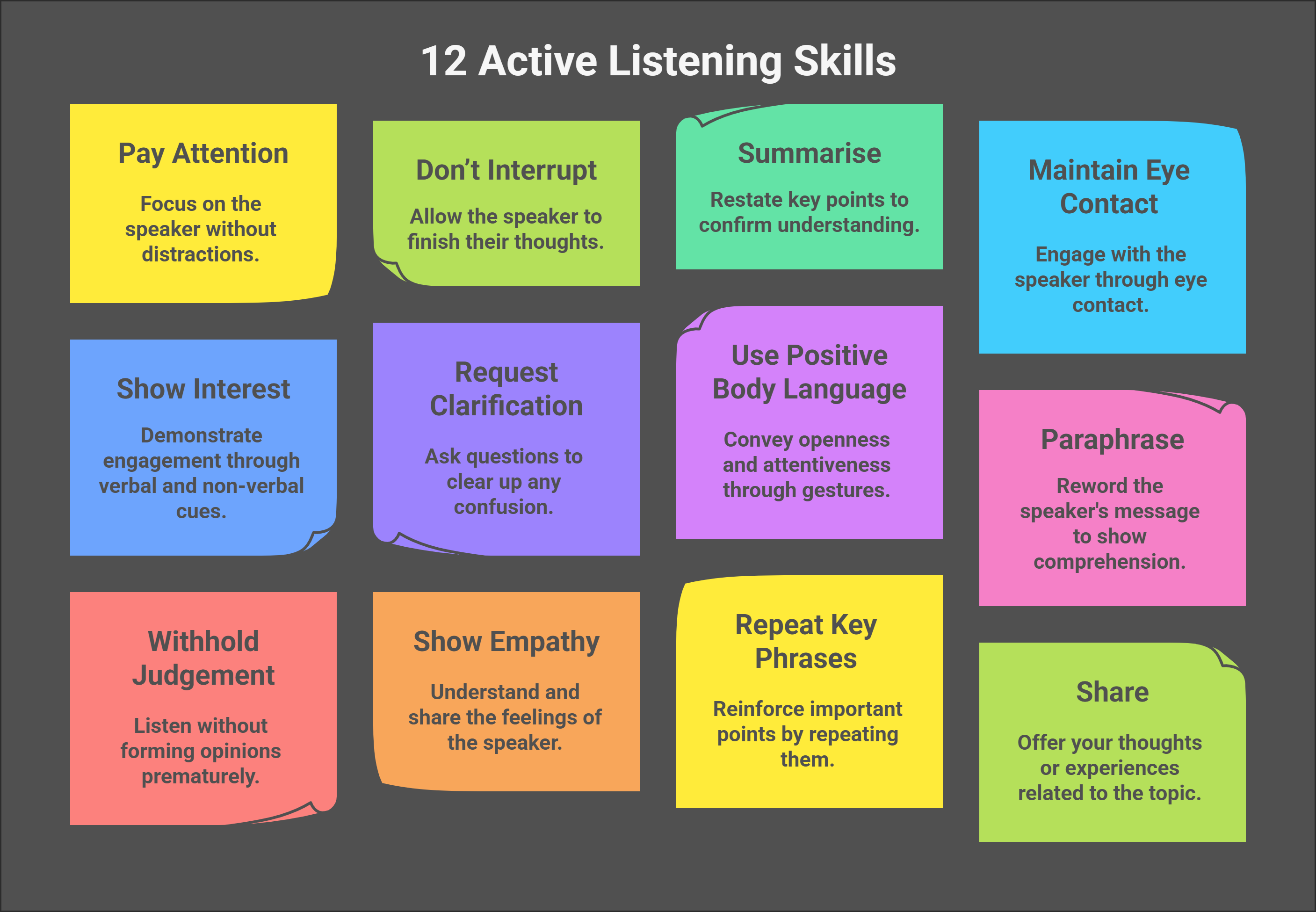
1. Maintaining Eye Contact
A critical component of active listening is eye contact. When you look a person in the eyes, you are telling them that you are all there with them and that you are giving them your full attention. Eye contact is also, in many cases, a respect thing. It is akin to saying, “I’m not only here with you now; I may not be in the room with you all the time, but I am in your space with you and am here to listen.”
One of the most potent means of communicating is through the eyes. Directing one’s gaze toward another person can indicate several positive traits—confidence, sincerity, even friendliness. However, too direct a gaze can make a person feel as though they are under a spotlight. Or, in more cross-cultural terms, it can make one feel as though they are being “stared at.” Indeed, the level of eye contact considered “normal” can vary widely from culture to culture.
2. Nodding and Other Ways to Give Non-Verbal Feedback
Non-verbal feedback—like nodding, smiling, and leaning forward—indicates that you are paying attention and encourages the speaker to keep going. These gestures create an environment that makes the other person feel not just heard, but understood and valued—in our case, by professional services. Yet many of us underestimate the power of simply being a non-verbal good listener with our body language and facial expressions.
Nodding and giving other kinds of non-verbal feedback act as very subtle signals that tell a person to go ahead and say more. When someone is already not stating something as fully as they could, we do not want to have too much of a positive feedback loop. A positive feedback loop is created when the listener really looks like they are getting something out of whatever the speaker is saying.
3. Summarising Points
Restating what a speaker has said in your own words is what constitutes a summary. If you can summarise what the speaker has said, then you have understood the key points. What is nice about this technique is that often it is necessary to use it for the parties involved in a conversation to achieve clarity. This is especially true in business meetings where lots of information is being conveyed and a lot of “on the same page” type understandings need to be achieved.
To encapsulate the core of a speaker’s message in a summary, one must be careful not to let personal interpretations or biases slip in. Such a practise really demonstrates one’s understanding of the speaker’s words and one’s valuing of the speaker’s input. And summarising is a much better way to ensure accurate communication of the speaker’s message than rephrasing or ambiguous parroting.
4. Asking Clarifying Questions
Open-ended inquiries are what make a good conversation great. Statements like, “Elaborate!” or even questions themselves (especially when they are not loaded with as much meaning as good conversation necessitates) are what get the speaker speaking more. That, in part, is why clarifying questions are so important. They do a lot with not a lot of words. On the surface, it seems like they are simply asking for more information. They are trying to encourage the speaker to share more of what they mean. This is part of a conversation’s natural evolution, and these questions help to ensure that it happens.
For us to push complex matters toward resolution, it is essential that we first plumb their depths to understand our clients’ concerns and requests in all their richness. To be effective in this endeavour, we need to coax our clients into providing us with the kinds of information that will yield a complete and comprehensive understanding of the situation.
And because we work best in a partnership with our clients, we are also motivated to use clarifying ploys that signal we have a real interest in understanding them.
Overcoming Barriers to Effective Listening
1. Dealing With Distractions
Active listening can be seriously compromised when a person is distracted. In an atmosphere of professional communication, it is vital to eliminate as many outside distractions as possible so that the two parties can interact most effectively. This can take some planning, but it is genuinely worthwhile; when you are fully present with the speaker, you are much more likely to pick up on their many verbal and non-verbal cues and signals.
Distractions are omnipresent in today’s hurried society. The interruptions spawned by never-ending emails and buzzing smartphones can subtract from the overall effect of any communication if one is not fully present during the interaction. To maintain focus during conversations, professionals must take the initiative to manage their distractions. This can be accomplished in several ways. One can simply attempt to not let anything coming in the direction of one’s eyes or ears interfere with the conversation. Alternatively, and possibly more effectively, one can use tools that cut down on the noise and visual distractions that can prevent one from being an active listener.
2. Managing our Biases
Active listening can be impeded by the personal biases and preconceived ideas that we all carry. It is a natural human tendency to interpret what we hear based on what we already think and believe. This type of judgmental, “passive” listening is not at all the same as the “active” listening that is such an essential skill for effective conversation in any human relationship. You cannot listen to someone if you are busy thinking about how what they are saying is different from or similar to what you already think.
There are many different places biases can emerge from, like our experiences or the cultures we come from. Biases also come from the beliefs we hold. These influences can colour how we see and understand information. It is particularly important in a work context to recognise the biases we hold, to set them aside, and to listen with the intention of hearing what is being said and not just what we expect to hear. Hearing us out is a step toward making a more inclusive and respectful workspace and one where multiple viewpoints are celebrated and more than just tolerated.
3. Making Sure There’s an Open and Friendly Environment
For active listening to be effective, it requires an environment of good communication to flourish. This environment starts with approachability and extends to encouraging open dialogue. More crucial than prior two steps, however, for setting the stage for effective communication is mutual respect—or, as it is often termed, a “culture of respect.” In that culture, communication flows naturally, and humans are as good at listening as they are at hearing. Once that stage is set, the stage becomes a platform for understanding.
From there, it becomes easy to teleport to the culture of professional services: it is all about good communication.
Trust, respect, and psychological safety form the basis of an open environment. Clients feel free to express their true thoughts and concerns in such an environment because they know judgment will not be passed. They also know there will not be any negative fallout if they speak up. Professionals can help create this environment with their clients by actively encouraging feedback (and not just the “you’re doing great” type that makes us feel good), acknowledging that there are many different and valid viewpoints in the world, and demonstrating empathy (which is really just a fancier word for “understanding”).
Benefits of Active Listening in Professional Services
1. Improved Connections with Clients
Building trust and demonstrating empathy are two essential aspects of creating and maintaining strong client relationships. Active listening is an effective way to achieve both, as it assures clients that their concerns are valid and important. When professionals listen with the intent to understand, they are better equipped to address current client issues, as well as to anticipate future needs. Active listening may also be a form of “relationship magic,” in that it fosters and creates the conditions necessary for personalised and effective service delivery.
In the cutthroat world of professional services, hanging onto clients is indispensable. To retain clients, one must ensure their satisfaction. To ensure satisfaction, the next logical step is to listen to the clients. This seems simple enough, but the act of listening can be far more complicated than one might think. Listening and understanding what a client is saying are the first steps in creating a foundation upon which a long-term relationship with the client can exist. A relationship established on mutual respect and trust is the underpinning of any successful business.
2. Problem Solving That Packs a Punch
When professionals take the time to comprehend their clients’ needs and worries, they resolve issues more effectively—especially when the problems are complicated, the clients are under stress, or both. Healthy listening—listening with the intent not just to hear but also to understand—enables directors to unearth the actual root of the problem. And that work is foundational to finding a truly effective, truly sustainable solution.
In the professional services, multifaceted and complex problems require resolution. Solving them is not usually a straightforward process, but there are methods that can make the work go more smoothly. A prominent one is active listening. This entails not only hearing what the client has to say but also comprehensively taking in and understanding the information. Why is this so important? Because it is the first step in developing well-aligned and effectively nuanced solutions.
3. Enhanced Interaction and Teamwork
Promoting clear, open, and active communication in a team is not a trivial pursuit. It is essential for effective collaboration, especially when different team members across various functions and geographies must work with each other toward a shared goal. But for us (as well as you), why should we care about clear, open, and active communication in a team? And what does a team look like when it communicates clearly, openly, and actively?
For a team to work well together, there must be a deep level of understanding and respect among its members. Listening actively is an effective way to ensure that happens. When you listen actively, you give the speaker your full attention and make an effort to understand not just the words, but also the meaning and intent behind them. If this were a seminar, I would say we had just shared a “moment of lecture.” You, the audience, have listened with a level of engagement that has taken you, collectively, into the realm of “understanding.”
4. Fostering a Culture of Active Listening
To fully integrate active listening into a professional services firm, it is essential to foster a culture that values and prioritises this skill. There is not just a need for training at the individual level but also for the creation of policies and practices that support active listening across all levels of the organisation.
5. Leadership and Active Listening
The crucial part that leadership plays in demonstrating active listening behaviours cannot be overstated. When a leader invests in demonstrating the kinds of behaviours that constitute active listening, it sends a very strong message to the rest of the organisation—especially when one considers that most people don’t know to look for the signs of active listening (or lack thereof) when they are being spoken to. Leaders can commit to this investment in two very important ways: by having open dialogues and by seeking feedback.
6. Training and Development
Maintenance and enhancement of active listening skills hinge on consistent training and development. Investment by professional services organisations in regular workshops and training sessions that target advanced listening technique, cultural competence, and emotional intelligence is key. These sessions need to be tailored to the organisation’s and its clients’ evolving needs, ensuring that professionals retain the skill at a high level.
7. Integrating Technology
In the contemporary age of technology, the professional world is experiencing a noticeable shift toward digital work. While this presents certain challenges for active listening, technology can also lend a helping hand. Meeting through video conferencing platforms instead of in person calls for professionals to be even more intentional with listening.
Nevertheless, this is not a signal to abandon the listening practises outlined so far. Try using them along with the digital tools being utilised. Doing so will likely result in a more engaged audience.
8. Measuring the Impact
Active listening initiatives can only be effective if organisations measure their impact. This might be done by surveying the clients and even the staff who partake in multiplied listening sessions. Feedback from these sorts of initiatives is crucial to ensuring that listening multiplied or otherwise is efficient and that it is “serving the organisation.” Performance appraisals are another way to measure the impact of listening “on the ground.”
Case Studies and Success Stories
Emphasising instances and success tales can give real-world gravitas to the active listening conversation. These potent examples show just what active listening can do when it has taken up as a practise. And as with all good conversations, these examples can lead to others sharing their own stories. What is remarkable here is how the active listening practise seems to lead to stories with remarkable resolutions. And sure enough, these stories have enjoyable moments for the active listener. After all, who does not love a good story?
Final Thoughts
Listening well is hard work. It takes not only effort and self-awareness but also, I think, a commitment that is often undemonstrated in respects to just getting things done in professional services. And with that commitment, the art of active listening has never been more relevant as the professions evolve, not just through economic cycles but also in scope and focus. It is a skill that allows you to build safe passages through helter-skelter interactions with clients and colleagues. When you navigate these waters with a deft touch, no one drowns, and everyone emerges happy and satisfied on the other side.
This training session delved into the basic tenets and techniques of the art of active listening. Trust and clarity are essential prerequisites for the active listening process to work. The listener must fully comprehend the speaker’s words and their intended meaning, as well as not get distracted by the speaker’s affect, or lack thereof. More than ten problems can block a person’s ability to listen actively. Yet, you can be a more effective problem-solver and collaborator when you enhance your skills to interpret the verbal and non-verbal cues that indicate your speaker is finished talking.
As you progress, keep in mind that listening is a potent tool that can change your work interactions. Remember the techniques I have shown you today, and make sure to practise them in your daily work. If you do, you will not only become a better communicator yourself; you will also help create a more effective and successful environment for the professional services you and I provide.
To sum up, active listening is an indispensable competence for any professional in the service sector. It necessitates not only considerable time and effort but also an unfeigned want to comprehend and bond with other human beings. If you were to put a gun to my head and force me to prioritise what makes our company a suitable candidate for your human capital, I would say it is this: Active listening is a fault line that, when bulged, delivers the seismic activity that builds not only a solid foundation for stronger relationships with clients but also a framework that enables us to reach the right (and often innovative) outcomes in our work.
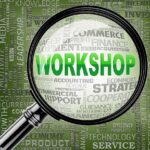
Exercises

Case Study: Deloitte and Active Listening in Client Engagement
Background
One of the Big Four accounting firms, Deloitte, had a major client in the financial services sector that was unhappy with the progress being made. The client perceived that there was a lack of understanding regarding their specific needs, which resulted in a relationship that was so strained it could have led to a termination of the contract.
Implementation of Active Listening
Deloitte addressed this issue by rolling out a structured, active listening method for all client interactions. The consulting team received training to hone their active listening skills, which are now considered essential for effective communication and for establishing trust with clients. The team was taught to maintain eye contact, to nod when appropriate, and to give ample and thoughtful verbal affirmations that signal the meeting’s “first half” was equally as important as the “second half.”
Consultants were taught the art of subtlety when it came to expressing the client’s points in their own words. They learned to listen first and then, by way of reflection, make the client’s thoughts their own. This was the ideal segue into more profound and exploratory questioning. When it came to inquiring about sensitive topics, it was best to use open-ended questions. But there was no rush. It was about creating a safe space for the client.
Outcome
This realignment of strategy had a notable effect. The client was able to receive the improved communication and articulation they needed to truly understand the issues and concerns at play. That clearly was not happening before. “The client feels much better about this,” said Paul Daugherty, CTO, and global consulting lead for Deloitte. “They feel it’s more personal and better articulated.”
Consequently, the client renewed their contract with Deloitte and the partnership thrived. The project results were markedly better, demonstrating that simply not barking orders but truly hearing what your client is saying can shift a professional services relationship from “just working” to “thriving.”

Course Manual 2: Building Trust and Rapport
Setting the Scene
The Speed of Trust: The One Thing That Changes Everything, written by Stephen M.R. Covey, places trust as the bedrock of any effective relationship. If it is not there, then a relationship is either non-existent or on the verge of collapse, no matter how many other positive things might be present in it. When it comes to professional relationships, trust is even more critical.
Covey is clear that the foundation of trust, what it is built upon, are two things: character and competence. More specifically, he lays out (10) consistent honesty and integrity as some key building blocks for trust. To him, “Being transparent and admitting your mistakes is a powerful way to build trust.”
Then he shifts attention to the second component: competence. This is where some might think of skills, but Covey, here again, focuses on the part of competence that deals with trust. Can you perform? Are you doing what you should be doing, and if not, are you working on it? Delivering on promises is another thing he emphasises to build and maintain trust, as is being believable in how and what you say.
Foundations of Trust
Any successful relationship rests on a foundation of trust. In the professional services that we and L.E.K. provide as a partnership, trust allows for more open communication, more mutual respect, and more effective collaboration. When clients and colleagues can trust one another, they share a lot more and with much less hesitation. And when they share more and with much less hesitation, they are better working toward the goals that we help them define, which are mostly serves longer than short-term order accomplishes.
Benefits of Building Rapport
A positive and harmonious relationship between individuals defines rapport. Achieving this in a professional situation can culminate in communication that flows on the same frequency, with all intended signals received and understood. Cooperation among team members seems to increase manyfold when there is even a whiff of rapport in the air. Everyone seems to be on board, sailing in the same direction. And good old’ satisfaction—who does not love it when service providers and clients alike are happy with the outcome of their interactions?
Strategies for Building Trust
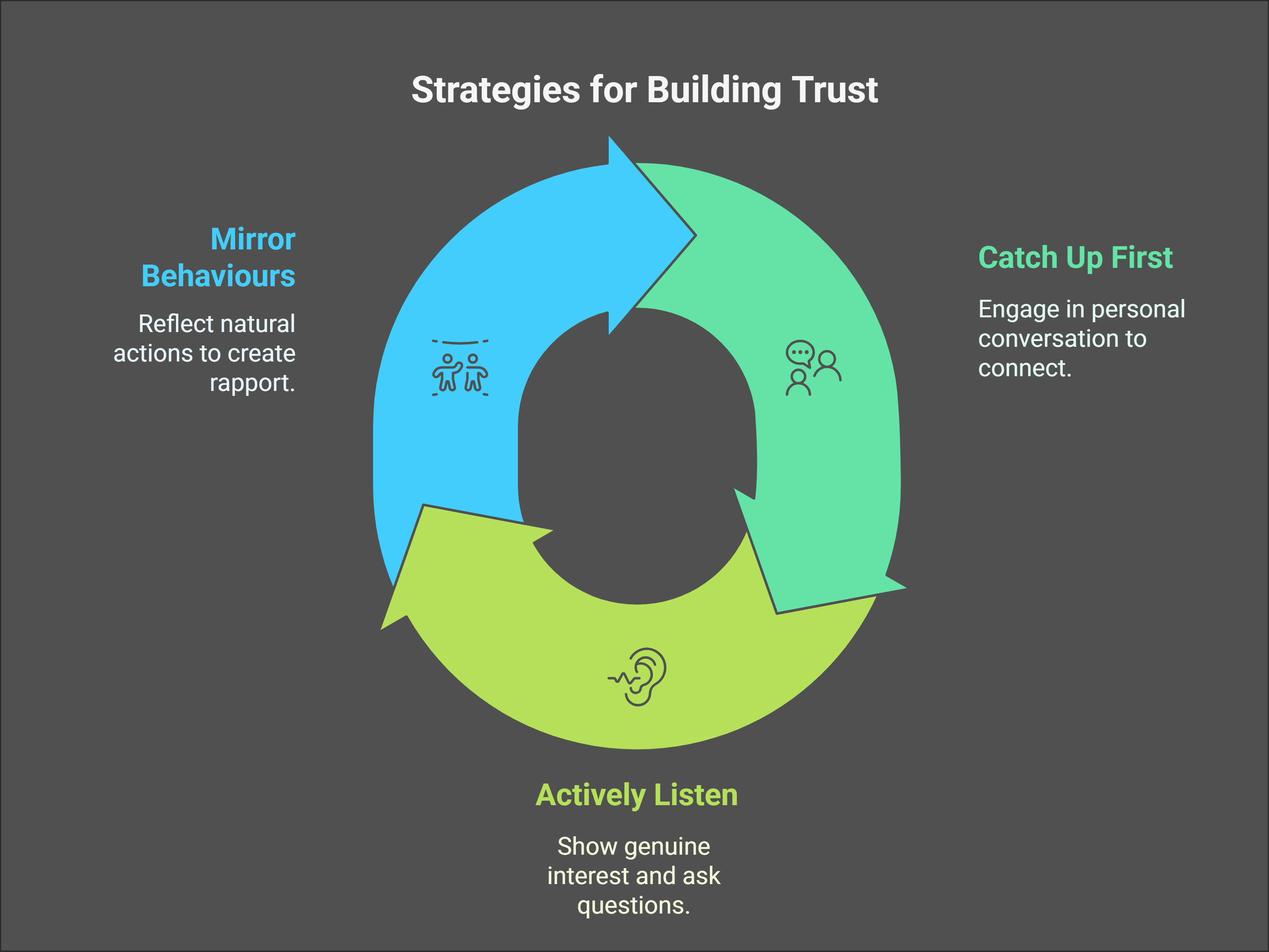
Consistent Honesty
The foundation of trust is laid by honesty. When all communications, whether praiseworthy or otherwise, are carried out with truthfulness, then clients and colleagues can know, with certainty, that reliance on one’s word is not misplaced. The practise of being consistently honest in a professional setting gives way to the truth being told, yes, but it also gives way to an equal part of the equation: No uncertainties, limitations, or mistakes are glossed over. And in sharing what is shared on the part of being honest, there is no part of the equation that is small enough to be a “tell” for any lies that have yet to be told. In this way, being consistently honest keeps one on the path to being a trustworthy professional.
Reliability and Dependability
Trust follows naturally when one is dependable and acts consistently. To be reliable is to be on time, to fulfill commitments, and to meet deadlines. Not in just one or two of these tasks, but in all of them all the time is the correct formula for “reliability.” We extend “reliability” to all actions we take, or do not take, in the professional world of “work” and “workspace.” If you know how to do any of these tasks, you can invariably do them well and you can do them on time. They have to do with acts of profession—behaving in a way that produces “reliable” results. At the same time, you must be behaving in a “reliable” way for people who might want to work with you.
Transparency in Communication
Being open and clear about intentions, processes, and decisions is what transparency is about. In professional services, you can achieve transparency by regularly updating your clients on project progress, making the rationale behind decisions clear, and being open about potential challenges. Trust is built by ensuring that everyone involved has a clear and certain understanding of the situation. This is transparent communication. To be effectively transparent, however, you cannot only be reactive and wait for clients to come to you with questions. You must be proactive and go to them with answers, sharing project progress along the way and being forthright about any issues being faced. This is the clear, almost too-clear, communication style of the wealthy.
Strengthening Connections through Active Listening and Empathy
Active Listening
Trust and rapport come from active listening, a concentrated, thoughtful way of hearing another person. When someone is using active listening, they are maintaining eye contact; they are actually nodding (and not just doing it in their head); they are summarising the speaker’s previous point; they are asking that very important, clarifying question. Indeed, it is very difficult to do these things and pay attention at the same time. In fact, you cannot really do it and pay attention like you would when you are not being asked to do something special with your eyes, your head, or your mouth. So, when we are thinking about this whole act of listening as a kind of weird performance that we hold up for another person to actually trust and have rapport with, think special but not supremely intimate.
Showing Empathy
The ability to understand and share the feelings of others—that is what empathy is. A professional relationship with anyone—let alone a client or colleague—requires empathy, if not for anything else, then to understand what makes the other person tick. To empathise is to acknowledge and value the emotions that the other person is experiencing. It is possible to do this without sharing in their feelings. Many people find it easier to empathise with individuals who are like them. But empathy with those who are different from us in some way can be even more valuable and revealing. It is often said that to empathise is to put oneself in another’s shoes, imagining how life would feel from that person’s perspective.
The Role of Non-Verbal Communication in Building Rapport
Eye Contact
Non-verbal communication is a place where many advisors, especially those from a non-traditional background, miss the mark. The first and most important part of non-verbal communication is eye contact. When you are making eye contact with a person, it shows that you are engaged and that you are listening. It also builds trust. Conversely, when you are not making eye contact with a person, it shows that you are not present, that you are not listening, and that you are not trustworthy. Now, I am going to go over the most important parts of making eye contact.
Genuine Smiles
An authentic smile can exert a powerful influence on how you are viewed by others. To smile warmly and sends out signals that create a positive atmosphere and help build rapport. It is the kind of nonverbal signal that says, “I am pleasant, I am approachable, and I am open for business.” Even if the business is just casual conversation, a genuine smile makes what could be an awkward interaction into a comfortable one. You might be thinking that what I just described is the kind of smile you give when someone hands you a cupcake. But no. These smiling tips are on the same level as those for active listening. Smile when someone is talking to you as if you are about to receive a cupcake.
Open Body Language
The gestures and postures that convey openness and receptivity make up what is known as “open body language.” This includes such things as never crossing your arms, leaning slightly forward, and maintaining a relaxed posture. Open body language is a signal that you, the communicator, are approachable and the willing to engage, which, I can assure you, builds trust and rapport in almost any audience. Indeed, if you can be present and engaged in these ways, it is almost guaranteed that your communication will not only be effective but also the kind of communication that makes others want to engage with you.
Maintaining Trust and Rapport
Continual Commitment to Practices
Establishing trust and rapport is a perpetual process that requires an unfaltering pledge of commitment. When people are consistently honest, reliable, and transparent; when they actively listen and demonstrate empathy and positive body language; and when they are just simply pleasant to be around; they build an environment where trust and rapport are maintained and where it is safe to be vulnerable. Trust and rapport do not just happen. They take effort and time. But well worth it in the end. If you can secure it, you can be almost certain that you will accomplish nearly every goal imaginable in your work with teams and individuals.
Demonstrating Integrity
Acting with integrity means aligning your actions with your stated values and principles. In professional services, this means behaving ethically, keeping your word, and being accountable, especially when things go wrong. Reinforcing trust and respect is essential for that long-term relationship we call a “client.” Much of that is the stuff of old-time virtues: doing whatever it takes to live up to your commitments, keeping whatever promises you have made, and doing it all even when (especially when) it is hard to do.
Respect in All Interactions
Fundamental to building and maintaining trust and rapport is respect. Treating clients and colleagues with respect means recognising their inherent worth, acknowledging their valuable contributions, and appreciating their individual perspectives. Interacting with respect creates a positive and inclusive environment and fosters stronger connections that lead to much better collaboration. When it comes to being respectful, there is no magic formula. Showing respect is simply good business practice. The number one way to show respect is to listen. Not just to hear but to really listen. To absorb what the other person is saying, to think about it, and to respond to it. Listening is huge. And then there are the ideas, everyone’s ideas, which you are supposed to acknowledge.
Benefits of Trust and Rapport in Professional Services
Enhanced Collaboration
Collaboration is enhanced when team members trust one another and have established rapport. That is, when collaboration is at its best, it is performed in what some might term a “warm” environment that is supportive of ideas, feedback, and even some judiciously placed tough-love challenges. When team members have an easy-going relationship, you may occasionally find them holding forth on some aspect of the work in a half-joking, half-serious fashion. Indeed, this is also good atmosphere. If you are not at a stage where this is happening, do not worry. Trust and rapport take time to build. They are built best in the “long game” of team life, not in a series of “trust exercises” or “rapprochement events.”
Increased Productivity
Increased productivity comes from trust and rapport, which diminish misunderstandings and conflicts. When I work with clients and when I work with my colleagues, I want us to trust each other. I want us to have efficient communication. Think about it: if you work with someone whom you trust, isn’t task completion and goal achievement more effective because you are not spending time worrying about whether the communication you are having is “really” happening in a smooth manner? In my experience, when team members trust one another, they are also more likely to take initiative and to work in a way that feels fluid and natural.
Improved Client Relationships
Trust and rapport are the foundations of strong client relationships. When clients trust their service providers, they are much more likely to talk openly and give valuable feedback. And what is the result of that?
1. A deep understanding of client needs.
2. Tailored and effective services.
But there is more. When clients feel understood and valued, they display higher loyalty and are much more likely to make referrals. In the professional services industry, it is just not possible to have too many positive client relationships. They are the pathway to sustained success.
Conclusion
In professional relationships, trust and rapport must first be built. Then they must be maintained. Why? Because achieving better collaboration, productivity, and overall success continues to be the aim in the many different segments in which professionals work. We do not collaborate alone; we work with others. So how do we enhance our “inter-actor” competencies and build stronger connections? Practise honesty, reliability, and transparency, for example. Actively listen. Be empathetic. Maintain positive body language. And even when we are not with someone, our professional services work with and for them.
Questions and Discussion
Prompt participants to express their ideas, experiences, and questions. Facilitate a conversation around the trust and rapport issues they deal with and help them figure out as a group what potential solutions might work for them. Keep the discussion anchored in the professional service world so that the applicability of the concepts we are covering stays clear. This session should be low-key and carried out mostly in the round. If you do not get much discussion, we recommend that you fill in any gaps with your own real-world stories.
Final Thoughts
This training session is designed to be interactive and engaging, supplying service professionals with the tools and techniques they need to build and maintain trust and rapport. By incorporating these practices into your daily routine, you can enhance communication, build stronger client relationships, and achieve greater success in your career. Active listening and empathy are not just skills but are integral “parts of the toolkit of any professional who serves others (in part because ‘Those who can understand the communications of others can also command the communications of others.’). Better understanding leads to better service, and that’s what we’re all aiming for.” Richard Paul and Linda Elder.

Case Study: Building Rapport and Trust in Professional Services at PwC
Background
One of the world’s largest professional services firms, PwC, was engaged by a major client in the healthcare industry to boost its operation efficiency. Though the firm’s work on the project did not encounter major problems, the initial interactions were strained. Of course, the large size and global reach of PwC would make it a likely candidate for past and present engagement in the healthcare arena.
Implementation of Rapport and Trust-Building Strategies
PwC’s team understood the need to establish trust and rapport to ensure a successful partnership. They started by being consistently honest and open about themselves. The project was discussed in detail. Consistency is key when you are “coming clean” with a client. If you say something in the project kick-off that is not repeated during a status update, you have already put your partnership on shaky ground. The PwC consultants made every effort to say the same thing at every meeting to ensure that becoming a “trusted advisor” could be realised. The team even used the phrase “we have not achieved consistency” in a project retrospective to highlight the importance of honesty and transparency with a client that might have serious wake-up calls.
Outcome
The relationships with the client improved significantly. Trust was established, leading to a much more open, effective, and collaborative communication style. The project resulted in substantive operational efficiencies for the client, a payoff that can be traced directly to how effective the team was at establishing not just communication but also effective working relationships. Many of us in professional services have experienced this firsthand: when clients trust us, they are much more likely to work with us toward a common goal. And with trust, of course, comes with the much-desired benefit of having a client who is engaging instead of one who is merely tolerating our presence.

Practical Exercises to Build Trust and Rapport

Course Manual 3: Effective Questioning Skills
The Skilled Helper
Gerard Egan, a world-renowned expert in communication and counselling, has written extensively on the art of asking questions. His book, The Skilled Helper, is a classic in the field and provides a wealth of practical knowledge for professionals in both the helping and business services. Egan emphasises that questioning is a far more complex process than most people assume. He proposes that professionals who work with the public invest time in learning the practice of good questioning. Egan talks about the different types of questions that can be used and when to use them. He also discusses several important techniques to keep in mind when framing and delivering the question. Conducting a questioning session well is a form of professional artistry. It demands that one be clear, concise, and to-the-point without being abrupt. It also requires a careful balance between asking follow-up questions and not interrupting the speaker. When this process is rendered effectively, it fosters an environment of trust. When clients feel secure, they are far more likely to offer up pertinent details regarding the issue at hand. Egan offers several key insights regarding the collaborative nature of good questioning. When a professional asks a question well, it serves to clarify not only the client’s thoughts but also the professional’s understanding of the client’s stated problem or expressed need. Egan’s advice is not only sound but also easy to digest and apply. Questions are the lifeblood of any helping relationship. The stronger the questions, the stronger the relationship.
The Importance of Effective Questioning
Improving Dialogue Asking the Right Questions is Key
On the path to clear and open communication, the right questions must be asked. Professionals of all stripes can use questioning to elicit essential information, understand client needs, and arrive at a variety of decisions. With a conversation in mind as the foundation for gathering all necessary data, negative dialogue should be avoided—productive dialogue should be the goal. At the same time, well-constructed questions can navigate lots of detailed, dense, or complex information and dumb it down to a more manageable diameter.
Building Trust
Asking sharp and pertinent questions shows that you are really interested in the client’s condition. This is societal condition, not just individual. These moments build trust. “I think you value me when you ask good questions and then listen closely to my responses, as if you’re trying to figure out some big puzzle.” Trust is further reinforced when clients see that their concerns are being worked around in a pathway of good thought, not just in a pathway of “this is what we say when we mean something but don’t want to be too direct.”
Ensuring Well-Suited Solutions
Questioning that is done effectively makes certain that all elements of a client’s worry are addressed and leads to solutions that are appropriate to the client’s particular situation. This is almost always good for the client and for the professional who serves the client, but it is especially true when the client has a situation that is somewhat unusual and when the services prescribed could be of use to someone else in a similar situation. Then the professional is doubly effective: serving the current client and paving the way to serve future clients with the same or a comparable situation.
Types of Questions
Open-Ended Questions
Open-ended questions stimulate comprehensive responses and allow clients to articulate their thoughts and feelings in a detailed manner. These questions serve the dual purpose of eliciting the obvious “what,” “how,” or “why,” and of fishing for a response that requires the client to think and say something that is not a preordained part of the conversation. For example:
• “What would you see as the top-level benefits of changing to a new project management system?” • “How do you see this system affecting your team?”
Closed-Ended Questions
Questions that can be answered in a closed manner yield specific information. They usually generate responses that are monologic, that is, “yes” or “no” or some brief form of statement. Why would we use such questions in an interview? Well, they are good for confirming details or obtaining clear, specific information. For example:
• “Did the project meet your expectations?”
• “Is the budget for this project finalised?”
Benefits: You get clear, efficient responses that are easy to interpret. You not only verify facts but gain clarity on specific, key points.
Probing Questions
A questioning technique used to elicit a full response is the probing question. This kind of question goes deeper and ensures that a response to a question is fully understood and clarified. It forces the respondent to not only answer the initial question but to provide more information and context around the initial answer. A probing question might look something like this: • “In laying out the previous solution you had, what might have been some of the features that made it not work well for you?”
Benefits: The probing question helps get to the heart of the matter quickly. It can be a time-saving device both for the questioner and the person being questioned.
Techniques for Asking Effective Questions
Being Clear and Concise
Being clear and concise is especially important when asking questions. If questions are unclear or overly complex, they can confuse clients and result in answers that are misleading or incomplete. Make your questions direct and understandable.
Example: Instead of asking, “What are the possible implications if we proceed with the project without finalising the budget, considering all the potential risks and uncertainties?” try: “What risks do we face if we start the project without a finalised budget?”
Avoiding Leading Questions
Questions that are leading suggest a certain answer and can end up biasing the client’s response. To get honest and unbiased information, ask neutral questions that do not imply a preferred answer. For instance, instead of asking, “You think the current system is inefficient, don’t you?” try, “What is your opinion on the efficiency of the current system?”
Using Active Listening
Listening with intent means more than just hearing words spoken. It is about concentrating on the task at hand and the person with whom you are engaged. You cannot listen with intent if you are not paying close attention. Like good actors, who take their cues from the person with whom they are performing, good listeners also take their cues from the individual with whom they are engaged. You act on the words, and even the silences, of the individual with whom you are spending time, making each moment an opportunity to understand better. Follow-up questions arise naturally from active listening. They are not rehearsed or premeditated; instead, they occur in the moment, as a response to what has just been said.
Strategic Use of Questions to Understand Client Needs
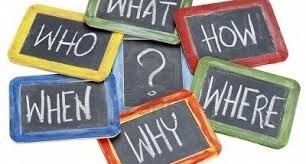
Clarifying and Confirming Information
Clarify and confirm the information given by the client by using questions. This ensures you have an accurate understanding of their needs and concerns. Example: “You brought up that budget constraints are a big deal for you. Can you give more details on that, and tell me a bit about the priorities we should keep in mind if we must make trade-offs?”
Exploring Client Needs in Depth
Go deeper into the client’s needs and preferences by asking probing questions. This may help bring to light not only the client’s immediate needs but also any underlying issues that could affect the project if not properly addressed. It also ensures that all relevant factors are considered, not just the ones the client has in mind at the moment. Asking about past experiences and the client’s vision for future ones can be revelatory.
Addressing All Aspects of Client Concerns
Make sure your inquiries encompass every part of the client’s worry. This all-encompassing strategy displays not only diligence but also helps solidify the client’s faith in you to attend to their various needs. For instance, one might ask: “Are there any other elements, like the overall design or how well this works with what we already have, that really matter to you?”
Overcoming Barriers to Effective Questioning

Addressing Personal Biases
Acknowledge and be aware of personal biases that can influence your questioning. Each conversation should be approached with an open mind; questions should be asked that allow for genuine and unbiased responses. It should be assumed that the client has a perspective that may be different from your own. Questions should be adjusted, if necessary, so that the client feels comfortable sharing their thoughts and opinions.
Managing Time Constraints
To ask questions well takes time and patience. When time is short, use it wisely. Prioritise the most important questions and ask them first. The length of your questioning session should be in direct correlation with the amount of time you have and the amount of detail you need to obtain. If you have only a little time, you should not be using just as much time to ask your questions. Remember: rushing through, or just plain leaving out, vital signs will get you a ticket to Misunderstanding Central.
The text you provided is an exact match for a date and does not contain any passage that can be rephrased. It refers specifically to “3 December 2024,” and any changes to that phrase would alter its meaning. Would you like me to help you with something else?
Creating a Conducive Environment
Make sure that the atmosphere is conducive to the open and honest communication of clients. This means choosing a location that is quiet, a setting that has very few distractions, and a placement within the client that ensures easy and natural conversation. A setting that makes the client comfortable breeds an atmosphere where the client feels free to share with you. If you can build a good rapport with the client at the very beginning of the conversation, then you create a setting that might just be good enough for the “open” and “honest” communication of thoughts and feelings that you might want.
Benefits of Effective Questioning in Professional Services
Improved Client Understanding
The client’s needs and concerns can be better understood when effective questions are asked. This kind of understanding is essential if what is delivered to the client is to be “tailored” and “effective.” It is not enough to understand the surface problem; you have to grasp the situation as it really is and the way the client really wants it to be. That is the kind of understanding that allows you to work out strategies and solutions that have a much better chance of meeting the client’s expectations and hitting the goals they are trying to achieve.
Enhanced Problem-Solving
Effective questioning elicits detailed information and probes issues to their depths. It is an indispensable tool of the problem solver. When used by professionals, it helps them to identify and understand the real (or root) causes of problems. It helps them to produce and develop far better (i.e., more effective, more innovative, more sustainable) solutions to serve their clients and themselves.
Stronger Client Relationships
The trust and rapport we build with our clients come from asking good questions, the kind that are not only relevant but also insightful. Leaving a client feeling as though they are just another cog in the wheel of an assembly line is a dangerous place to be as a consultant. The stronger your relationships with clients, the longer you can expect to work with them, the more you can expect them to send you other clients, and the more you can expect them to pay you across the years.
Conclusion
The services sector requires professionals to possess effective skills in asking questions. This can be achieved by mastering the art of clear and concise communication—something that, when reduced to its basic elements, consists of a “Q” part and an “A” part. Of course, we all know what the “Q” part is, but what exactly is the “A” part? And what do we really want it to be? Or, further still, what do our clients really want it to be? Implementing the discussed strategies will lead to more successful outcomes both for our clients and for ourselves.
Questions and Discussion
Urge participants to tell their thoughts, experiences, and any queries they may have. Talk about the tough spots that arise in being challenged to “practise what we preach” in terms of assuming a positive intent in our professional interactions. Focus on real-world scenarios relevant to participants’ work in professional services. This interactive segment will allow participants to engage with the material and solidify the “why” behind the effective questioning techniques being taught.
Final Thoughts
We have designed this training session to be interactive and engaging. Our intent is to provide professionals in service roles with the kinds of tools and techniques that lead to mastery of effective questioning skills. By using the practices, we demonstrate here in your daily routine, you can—and should, if you want to achieve what we see as greater success in service roles—enhance communication. You can and should build even stronger client relationships.
In any service-oriented profession, enhanced understanding and connections with clients are leading indicators of success. Questioning and listening, when done well, are the equivalent of an all-access pass to a client’s headspace. There is no short cut, no secret sauce. If a professional wants to reach a client’s world, they must first penetrate the fog of their own limited perspective. To that end, a questioning strategy serves as the means, and active listening serves as the complementary tactic of this two-part process of entering and inhabiting a client’s world.

Case Study: Effective Questioning Skills at Deloitte
Background
A large retail client engaged Deloitte, a global business consulting firm, to completely overhaul and rework their supply chain management system. The retail client’s needs were complex, and their history with previous consulting firms had left them dissatisfied and uncertain. This was a true consulting assignment that required Deloitte not only to apply its well-known suite of professional services to rework a systems solution but also to act like a business psychologist to understand the client’s psyche.
Implementation of Effective Questioning Skills
Deloitte’s consultants used effective questioning techniques to uncover the true needs and concerns of the client. They began with open-ended questions to elicit detailed responses. For example, they might ask, “Can you describe your current supply chain system? What are its biggest problems, from your point of view?” The point of this kind of question is to let the client speak freely, revealing as much as they want to about the situation at hand.
To obtain precise information, they employed closed-ended inquiries such as, “Is the inventory management software linked with your ordering system?” These types of questions were beneficial in elucidating technical particulars.
Questions that required more than a simple answer were used to dig deeper into specific areas. For instance, “You said there were issues with delivery delays. Can you give us more detail about what is causing those delays?” This helped the team really get to the bottom of the problem.
Outcome
By asking the right questions, Deloitte was able to uncover vital information that had formerly been ignored. This deep dive allowed them to understand not just the client’s surface problems, but the underlying issues. With that knowledge in hand, they were able to design a solution that fit the client like a glove. The relationship did not just survive; it thrived. And in a successful conclusion, the client was very satisfied with the result and even “commended the team for professionalism and excellence.”

Practical Exercises to Enhance Questioning Skills

Course Manual 4: Developing Personal Communication Style
Renowned psychologist Daniel Goleman, author of Emotional Intelligence, makes a compelling case for the personal communication style—affecting both the professional and the personal lives of people everywhere. With a focus on something he calls emotional intelligence, Goleman pushes the idea that effective communication starts from a good place regarding “social skills, motivation, empathy, self-regulation, and self-awareness.” He then takes these concepts to the next level of not just understanding what they mean but applying them in the service of developing a personal communication style. This is important and has real value because it leads to a greater understanding of oneself and an individual way of communicating. Yet, what Goleman offers is not just self-help for people with poor social skills. Indeed, he champions the idea that effective communication is the key to successful relationships in life.
The Importance of Personal Communication Style
Enhancing Professional Relationships
An effective personal communication style is conducive to the development of professional relationships. Such a style ensures that interactions are clear and respectful, rendering them as guarantees of effective communication. When you communicate clearly and with respect, your work relationships are bound to be better. That is not to say, however, that these personal styles of communication should be equated with “good” and “bad” methods of communicating. In fact, I would argue that in many situations, the personal style by which one communicates is much more important than the actual content of the interaction.
Improving Client Satisfaction
To improve satisfaction among diverse clients, it helps to adapt one’s communication style to suit that client’s needs. Why is this worth mentioning? Because client retention is influenced and often made possible by the little “wins” that can accumulate during any professional relationship. Listening and then leading—in this case, leading the conversation by maintaining the flow along the lines of the client’s preferences—demonstrates that one is not only able to carry on a conversation but do so in a way that makes the client feel good about the interaction.
Boosting Professional Growth
Professional advancement typically has its roots in effective communication. By the very nature of “communication,” it involves an audience, yet it also involves a sender who has a clear intention. Historically, dictation, letter writing, and “the memo” were the styles of the day; indeed, these were the ways of being “seen” until the much more recent advent of the era of electronic communication. At present, we have far greater visibility in the workplace than ever before, with far more potential distractions. Someday, we will either evolve some new style of communication or return to one of the old forms, as yet another era of “the next big thing” unfolds.
Recognising Your Strengths and Weaknesses
Self-Assessment
The first step in recognising your communication strengths and weaknesses is to conduct a self-assessment. Interactions of the recent past—along with the reactions these have elicited from colleagues and clients—should be the basis of your reflection. Look for what is effective in your communication style. But also look for what needs improvement. Be honest. If you can do this, it is a safe bet that you have diagnosed your real communication issues. And if you have, then you can go about righting these wrongs.
Seeking Feedback
Ask for trusted colleagues, mentors, and clients to give you feedback. Honest feedback can give you valuable insights into your communication style. How do you think it is going? How do others think it is going? Even with mentors and colleagues, we sometimes have blind spots when we are not aware of how someone else is perceiving things. They can offer valuable perspectives on what is working and what is not. If you are going to get feedback, you had better be prepared for some honest truths. But better to hear them now and adjust accordingly than to be a secret subject of discussion.
Understanding Your Communication Tendencies
Identifying Communication Preferences
To know your communication preference is to know whether you tend to lean naturally toward the more assertive, passive, aggressive, or passive-aggressive styles of interaction. Each of these styles has its strengths and limitations, but as you understand your default tendencies, you also understand the reason for some of your relationship challenges. For instance, while being assertive is almost always beneficial, being overly aggressive can certainly alienate some people. On the other hand, being passive just does not cut it in some situations. By identifying your natural style, you can at least manage your relationship interactions with a slightly better compass.
Adapting to Different Contexts
Acknowledge that varied contexts call for varied communication styles. For instance, if you are in a team meeting, a collaborative approach may serve you best; but if you are negotiating with a client, you may need a more assertive style to get your point across. Being able to switch up your style as the situation demands is a crucial skill in maintaining your context-appropriate appearance. And not just in terms of making the appearance of “getting along” go in situations where that is necessary but also in terms of making the appearance of being “as tough as nails” in situations where that is necessary.
Enhancing Self-Awareness and Emotional Intelligence
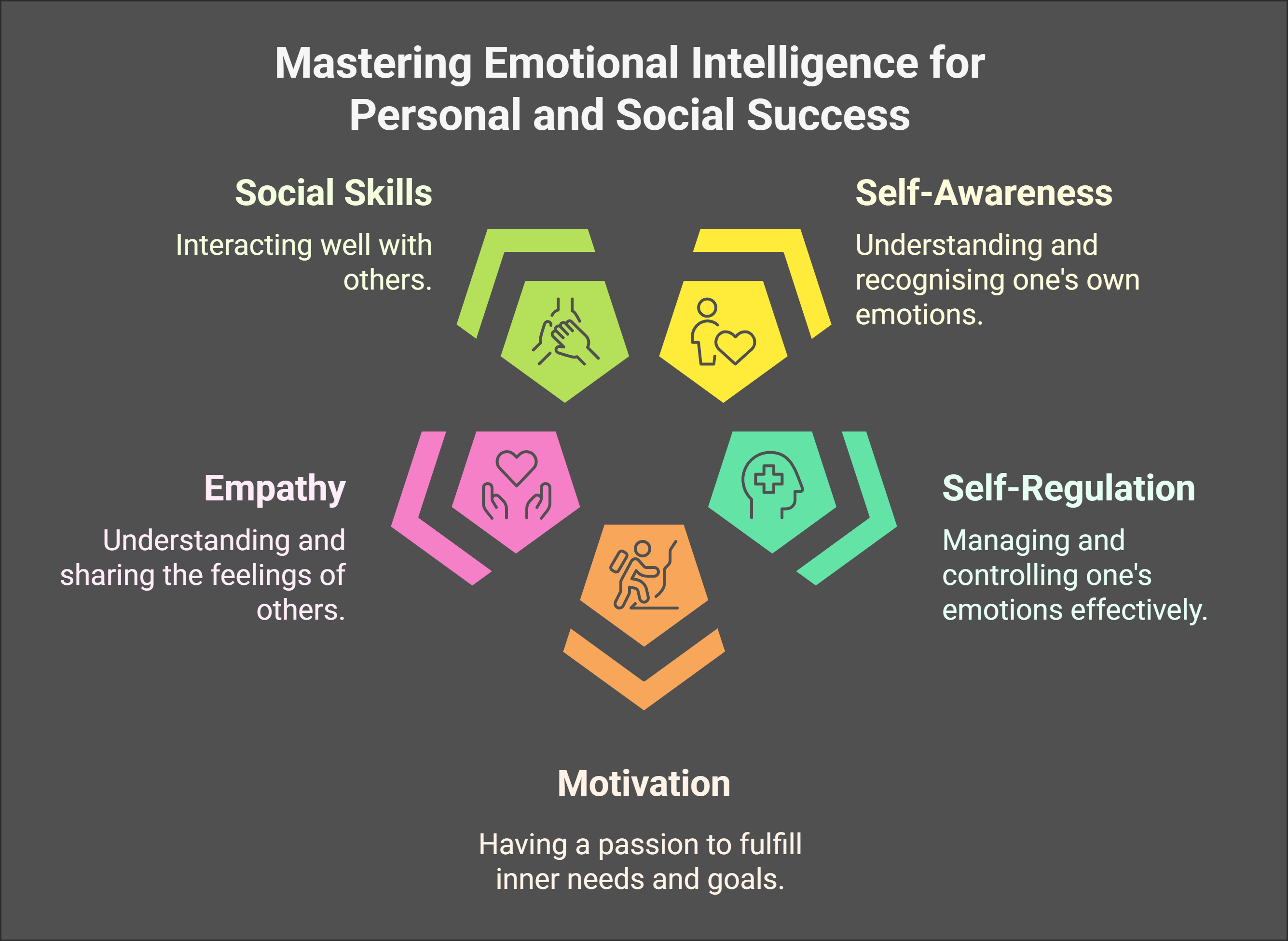
Self-Awareness
Awareness of the self is knowing not just who you are, but also what you feel and why you feel it. It is first and foremost the understanding of one’s emotions and knowing what one’s triggers are and how those emotions and triggers affect one’s behaviour and interactions with others. It is as if you become that objective observer of yourself that allows not just the recognition but also the understanding of the path your brain takes when dealing with not just routine events but also extraordinary ones. When aware of the self, you know what your pathway is during good times and bad, and more importantly, you know what your pathway is during any kind of time.
Emotional Intelligence
Self-awareness, self-regulation, motivation, empathy, and social skills make up what is commonly called the “big five” components of emotional intelligence. (The authors of the book Emotional Intelligence 2.0 would probably add “being good at handling relationships” to that list, but we will stick with the big five for now.) Why is this important? Well, obviously, a good professional relationship is required to work with someone. And if you have a strained relationship with a person, that person is likely still going to be involved with you in some kind of way.
Strategies for Developing a Personal Communication Style
Leveraging Strengths
Recognise and leverage your communication strengths. If you are a good listener, use this skill to build rapport and trust with clients. If you are articulate, use clear, concise language to convey your ideas effectively. Recognising and utilising your strengths can dramatically enhance your interactions. By focusing on what you do well, you can have an even bigger impact and be an even more effective contributor to your workplace.
Addressing Weaknesses
Concentrate on the parts that need mending. If you find yourself being too passive, practise being assertive. If you tend to go overboard and be too aggressive, tone things down and work toward a more collaborative style. Set very specific goals to address the parts of your personality that are getting in the way of your communication with others. By working on these areas, you can change old habits and become a much healthier communicator overall.
Adapting to Different Audiences
Change the style of communication to fit different audiences. Different factors present with different people; not everyone is the same or expects the same thing. When I think of this, I usually consider the divine factors that enable people to relate to each other—cultural backgrounds, personalities, and even the nature of one’s relationship with the individual. Because the audience is not universal, there are many reasons tailor-making an approach can ensure better reception and connection with a diverse range of individuals.
Using Non-Verbal Communication
How your message is received depends a great deal on non-verbal communication—body language, eye contact, and tone of voice. Make sure your non-verbal cues are coordinated with your verbal messages. Otherwise, you might end up with a funny kind of “conversational” situation where everyone is talking but no one is getting the point, which is not what you want in communication. Being mindful of these aspects can help you come across as confident and sincere, which makes communication better and makes it more engaging.
Maintaining and Evolving Your Communication Style
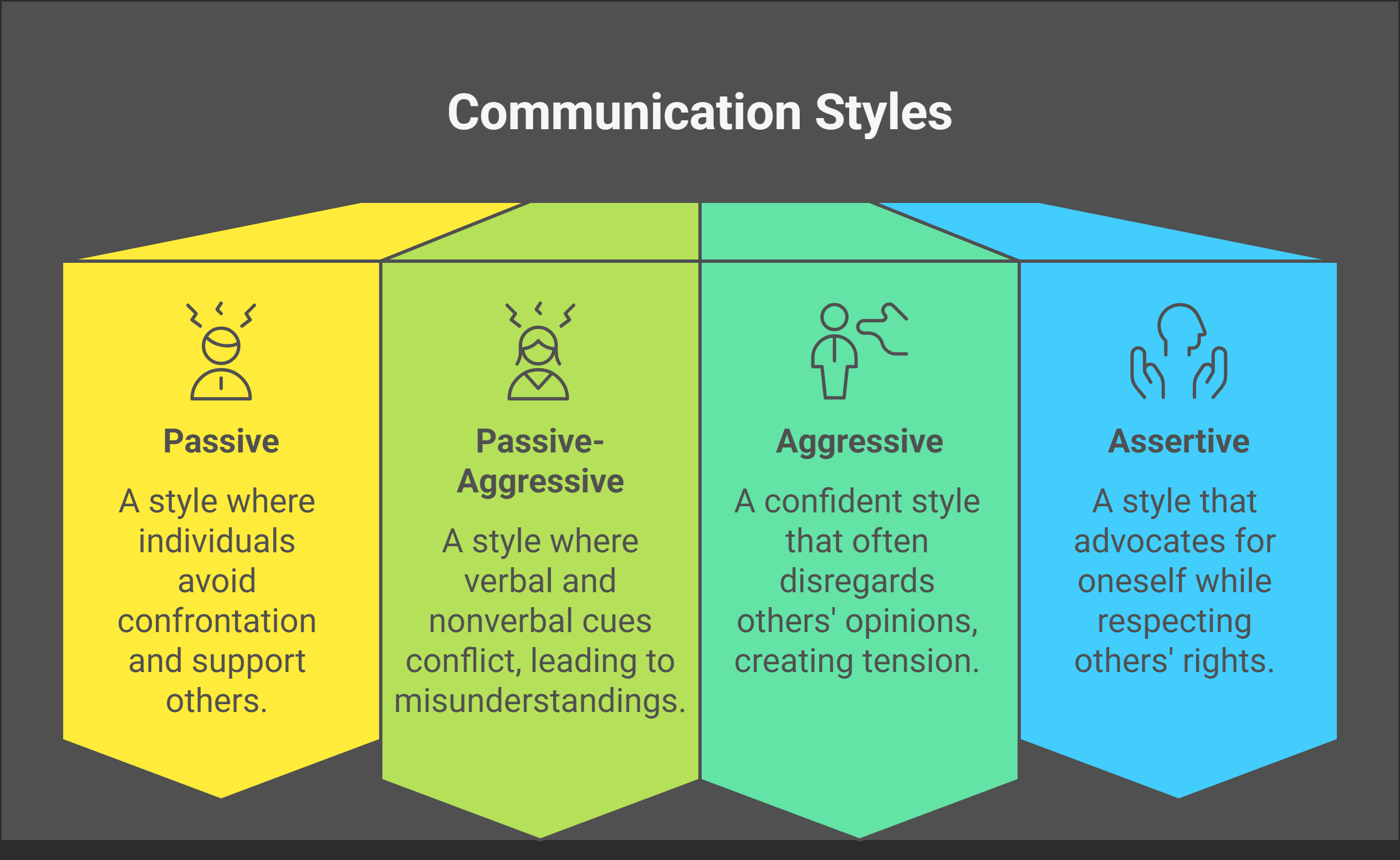
Continuous Improvement
An ongoing process of developing a personal communication style exists. There can be found the types of feedback that one should greedily seek, because they can help one to understand how one truly comes across in life and work. There is the type of reflection one should undertake regularly, as if it were a meditation on one’s not-quite-formed path. And there is the type of commitment to “continuous improvement” (ugh) that one should embrace if one wishes to express oneself better in all situations.
Staying Adaptable
In professional services, it is essential to communicate effectively with a variety of people. The ability to switch your style of communication depending on the situation, client, or team that you are with can dictate your success in any particular interaction. Clients expect a certain formality from a professional service, and you should maintain this formality for the sake of your business relationship. However, once a client has signed on with you, you can and should adapt your communication style to fit the currents of the interaction to ensure that you are navigating the diverse world of professional services effectively.
Leveraging Technology
Enhance your communication with the help of technology. Video conferencing, collaboration platforms, and feedback apps are tools that can support effective communication with clients and colleagues. They can also help you stay connected when remote work is your reality. But what if you are not so familiar with these techy tools? What if they seem more daunting than likely to help? Using these tools efficiently and seamlessly into your routine can have the opposite effect of what you want tech to do: reach, engage, and aid your communication with clients and audience.
Conclusion
Establishing an individual style of communication requires perceiving the strengths and weaknesses that make you distinct; understanding what makes you tick and what makes you act like you do (and especially what makes you communicate like you do); and, finally, being able to adapt all of these traits to the different situations and audiences that you encounter. One basic element that is usually considered in personal style is self-awareness. This is the foundation upon which you can build a more effective, more communicative you.
Embracing Diversity in Communication
Acknowledging and valuing various communication styles is key to thriving in today’s global workforce. Each culture has its own set of communication variables that when ignored can lead to serious misunderstandings. Even when meaning is translated as accurately as possible, the true intended message can be lost. Practising cultural competence—understanding and then adapting to different styles and norms—can eliminate much of the guesswork in communication and, more importantly, can prevent many unnecessary conflicts.
Building a Communication Toolkit
Being “well-versed” in communication is a huge asset when it comes to your professional life and can help you work around several types of “professionally awkward” situations. This can encompass a lot of different scenarios, such as active listening, persuasion, conflict resolution, and public speaking. And to be clear, these professions of listening, resolving, persuading, and speaking en masse are a part of a toolkit that can make “working up” these situations much easier. Having a good set of skills is nice; however, I think this is about having the right set of skills for each situation.
Measuring Your Progress
It is essential to keep track of your progress in developing your communication style if you wish to see continuous improvements. You need to be the driver of your development and, in much the same way that coaches do for teams, hold regular MVC meetings (Mentor, Vision, Check-in). Set goals that are specific and measurable and seek feedback from trusted colleagues or even the 3M group (within which you can include a mirror). The feedback loop that these strategies create ensures that you remain focused on your development and continue to enhance your communication effectiveness over time.
Conclusion: The Journey of Communication Mastery
The path to personal communication mastery is one of unwavering dedication and self-awareness. Above all, it demands the kind of real commitment to never-ending improvement that is all too rare in today’s professional milieu. Yet the payoffs, both tangible and intangible, for working to develop a more powerful personal communication style are monumental. You can calculate some of those payoffs in dollars and cents. A recent survey of 600 U.S. executives found that the most effective leaders are also the best communicators. In business, as in life, poor communication holds up the works. Whether you are a solo practitioner or work in the most sprawling organisation, communication serves as the scaffolding that supports day-to-day functioning. When what you are trying to say is muddled, tentative, or just plain wrong, nothing else you do, or anyone else does, really matters.

Case Study: Developing Personal Communication Style at McKinsey & Company
Background
A junior consultant at McKinsey & Company, Jane found it hard to communicate as she wished. Her feedback indicated that while she was well-informed, her knowledge did not always come through in a positive light. Some felt she was just too bossy and occasionally dismissive, which pushed some buttons among team members and, yes, even clients.
Implementation of Personal Communication Development
Jane chose to hone her personal communication style. She started with a self-assessment to spotlight her strengths and weaknesses. While she identified assertiveness as a communication strength, she also recognised that it needed to be balanced with empathy and active listening. In seeking feedback from mentors and peers, she received some useful insights. While Jane is still very much a work in progress, her recent haul of emotional intelligence has proven invaluable. Part of this course included a look at body language, and Jane also practised open-ended questioning more like a therapist than a manager. She has gotten much better at understanding different perspectives and ensuring that her assertive communication is tailored to the recipient and the circumstances.
Outcome
Eventually, Jane’s attempts to rectify the problems with her communication style paid off. People took notice of her significant and substantial manner of speaking. They complimented her on how well she was able to communicate with others. They told her that she was very persuasive and that her commanding presence made them feel good about following her lead. Even more, people noticed that she combined these qualities with an easy-going style that made it seem as if she had all the time in the world to talk with them, at least until the conversation reached its natural conclusion.

Practical Exercises to Enhance Communication Style

Course Manual 5: Giving Constructive Feedback
Douglas Stone and Sheila Heen, the authors of Thanks for the Feedback: The Science and Art of Receiving Feedback Well, highlight the importance of providing constructive feedback effectively. They assert that the “science” of feedback is about figuring out how to be better at “giving and getting” feedback. The “art” of feedback revolves around understanding its many nuances. Ultimately, Stone and Heen propose feedback is a “tripartite relationship” among the giver, the receiver, and the context in which the feedback is delivered. They suggest several key principles for making this relationship healthy and productive. One major recommendation is to centre the kind of feedback you are giving on specific behaviours rather than on general traits. This ensures your feedback is clear and understandable and that the receiver knows exactly what they need to change or keep doing. Another is to use “I” statements that express your personal perspective, thus reducing defensiveness on the part of the receiver and making it easier for them to accept what you are saying. Also important is the balance between positive and negative feedback. Both are necessary. Finally, there is empathy: “wipe that smirk off your face and for crying out loud, don’t look at the person receiving feedback like they’re a soybean in the middle of an ice cream sundae.”
Giving Constructive Feedback
The personal and professional development of individuals hinges on the necessity of receiving feedback. When it is received well, and when it is given well, it is sometimes referred to as “constructive feedback.” This is feedback that is, in essence, developmental. We all need developmental feedback if we are to grow and if our performance is to enhance and if our relationships with others are to get stronger. There are several key principles that one follows, ideally, when giving and receiving such feedback. They include focusing on specific behaviours, being objective, and attempting to maintain a balance between positive and negative feedback. This essay will explore these principles in detail, provide examples of them in action, and discuss some techniques and techniques to avoid.
Key Principles of Constructive Feedback
1. Focus on Specific Behaviours
Feedback should be directed at specific actions rather than general traits. This makes it clear what the recipient needs to do or stop doing to make the necessary changes. For example, instead of saying, “You are a poor communicator,” it would be more helpful to say, “You tend to mumble and not make eye contact when you talk, which makes it hard to know what you’re saying.” This is much more specific and much more actionable. It also gives the person a better clue about the type of change that they are being encouraged to make. On the other hand, if we do not specify what we are seeing with them, then they might just keep doing what they are doing because they think everything is okay.
2. Be Objective
Crucial in giving constructive feedback, objectivity encompasses a few simple steps of separating one’s personal feelings from the actual feedback and honing in on the observable facts. Feedback given in this manner is much less likely to be received as a personal attack—even if the feedback recipient may naturally be inclined to take it that way. Being objective, therefore, helps immensely in maintaining a sense of professionalism and in keeping the parties involved focused on any needed improvements rather than on who is going to say what next in a seemingly endless finger-pointing soap opera. Supporting your objective claims with data and evidence makes a world of difference, too.
3. Balance Positive and Negative Feedback
When giving feedback, it is important to balance positive and negative comments; otherwise, the recipient may not be as open to what you have to say. And this is vital, because most of us, in most cases, are better off when we receive feedback and act upon it. Positive feedback reinforces what is being done correctly, while negative feedback highlights areas for improvement. According to some scholars, effective feedback can be tricky to provide. On the one hand, you need to tell someone when they need to step it up, and on the other, you want to keep their spirits high enough for them to keep coming to work engaged and excited.
Techniques for Delivering Feedback Effectively
1. Use “I” Statements
Expressing your perspective using “I” statements can make you sound less accusatory and help you focus on your own feelings and observations. For example, you might say, “I felt concerned when the report was submitted late because it affected our project’s progress,” instead of asserting, “You are always late with your reports.” Feedback sessions can be tense, and the last thing anyone should want is to make them more combative than necessary. These sessions are far more successful when both parties collaborate to understand and solve the problems at hand. When ownership of the feedback is said to be in the realm of the “I,” it can also help with making the wrong judgments sound less judgmental.
2. Ensure Appropriate Timing
Delivering feedback takes finesse, and timing is a key element. You can think of times when someone has given you feedback, and it has gone totally awry. Think of those times as examples of what not to do. One of those times, I would argue, when feedback is least likely to land well and be taken in the spirit it is intended is right after a stressful, not-so-great meeting, when it seems like the team is on the verge of breakup. Our obverse proposal is: Use feedback as a vehicle to steer your team into more constructive territory that helps you deliver better results—together. The reception of feedback can significantly influence its effectiveness. Almost everyone reacts better to affirmations; therefore, frame feedback in a manner that is not deconstructive.
3. Be Clear and Concise
Effective communication means knowing when to clear the fog and when to get to the point. The feedback should be clear and direct—and not bogged down in unimportant details that could muddle the recipient’s mind. Take, for instance, the way one supervisor addresses an issue with a missing part in the weekly report. “I noticed that the weekly report was missing some key metrics. Can we ensure all required data is included next time?” This is clear and direct. It would be hard for the report-writer to misinterpret this and think, “Oh, she means I’ve included the wrong kind of data,” or “Hmmm, maybe I shouldn’t include such-and-such in the report because it’s not key.”
4. Offer Suggestions for Improvement
Feedback that is constructive should consist of suggestions that can be acted upon to lead to improvement. This makes it a lot easier for the recipient to understand what they need to change and gives them a clear direction in which to head. Take, for instance, our first example. We have something nice in “To improve your time management, it might help to prioritise your tasks at the beginning of each week and set specific deadlines for each.” Notice that we are really not saying anything negative in this instance. We are merely offering an actionable suggestion that helps the recipient envision a better way to manage their time. Another example might be “I’ve noticed that you’re struggling with managing multiple projects. Have you considered using project management software to help organise your tasks and deadlines?”
Handling Reactions to Feedback
1. Show Empathy
It is crucial for empathy to exist when feedback is given, especially when it involves criticism. The feelings of the recipient must be understood and acknowledged to maintain a positive relationship and encourage openness. It is one thing to give feedback; it is another thing entirely to serve it up with a side of pushback or resistance from the recipient. “I understand this feedback might be difficult to hear, but it’s meant to help you improve and succeed.” Following that statement with an empathetic “I” message proceeds to claim the feedback as help rather than an affront to the recipient’s dignity.
2. Practise Active Listening
When a recipient hears active listening, they know the speaker is fully engaged and trying hard to understand their perspective. Aspiring leaders who are proficient at active listening can use the technique to help clear up concerns or misunderstandings that might arise from their feedback. For example, after giving feedback, an aspiring leader might ask, “How do you feel about this feedback?” and listen with the intent to understand their response. Those proficient at active listening value the recipient’s input and are open to a two-way conversation. Hearing what the recipient says (and does not say) is important, but so is the next step—clarifying the points that need to be clearer.
3. Acknowledge Feelings and Be Prepared for Defensive Responses
People naturally tend to get defensive when they are given feedback that is, shall we say, less than complimentary. It is critical, therefore, for the giver of such feedback to acknowledge the defensiveness feedback elicits and then to deal with that defensiveness in a way that keeps the dialogue going. A better outcome is more likely if the giver of the feedback understands that the receiver will not always be a passive participant in the conversation. They may react with some vigorous pushback. As with many situations in life, there are strategies one can employ to keep the talk moving in a positive direction. A few of these strategies—or ways of coping—are listed below.
Fostering a Supportive Environment
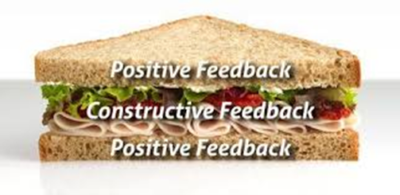
1. Create a Culture of Feedback
Developing a culture in which feedback is consistently given and received can help make the process less daunting and reduce the associated anxiety. This is achieved through fostering direct and open communication. The more natural the dialogue seems, the less stressful the experience will be for all involved. Thus, to reach this ideal state, the “more frequent, and more natural, the conversation is, the better.” Implementing regular performance reviews or feedback meetings can help with reaching this state.
2. Encourage Self-Reflection
Promoting self-reflection can help in getting individuals to take more ownership of their development and be more open to feedback. For instance, you might ask the recipient to perform a self-assessment of their work before you do. This makes sense when you consider that self-assessment is often the first step toward individual ownership and development and when you factor in that not everyone is always completely ready to hear feedback. Self-reflection is a thing we all do to some extent, either when we are or are not being prompted. Some of us do it more than others. For instance, “Before we discuss the feedback I’ve prepared for you, I’d first like you to do some self-reflecting. Can you think back to the project you recently wrapped up and assess it? What are your overall thoughts on the outcome?
3. Provide Training on Giving and Receiving Feedback
Equipping individuals with the skills to handle feedback effectively starts with training on the techniques of both giving and receiving feedback well. This most often occurs in the form of workshops, where a facilitator can model and demonstrate the nuances of delivering and receiving feedback. The virtual workshops on feedback skills that our department offers have been quite beneficial to various teams across the university. We usually get incredibly positive evaluations that say things like, “I think this workshop helped me understand what feedback is and how to have better conversations.” These virtual offerings are open to any team across the university who wishes to sign up.
Examples of Constructive Feedback
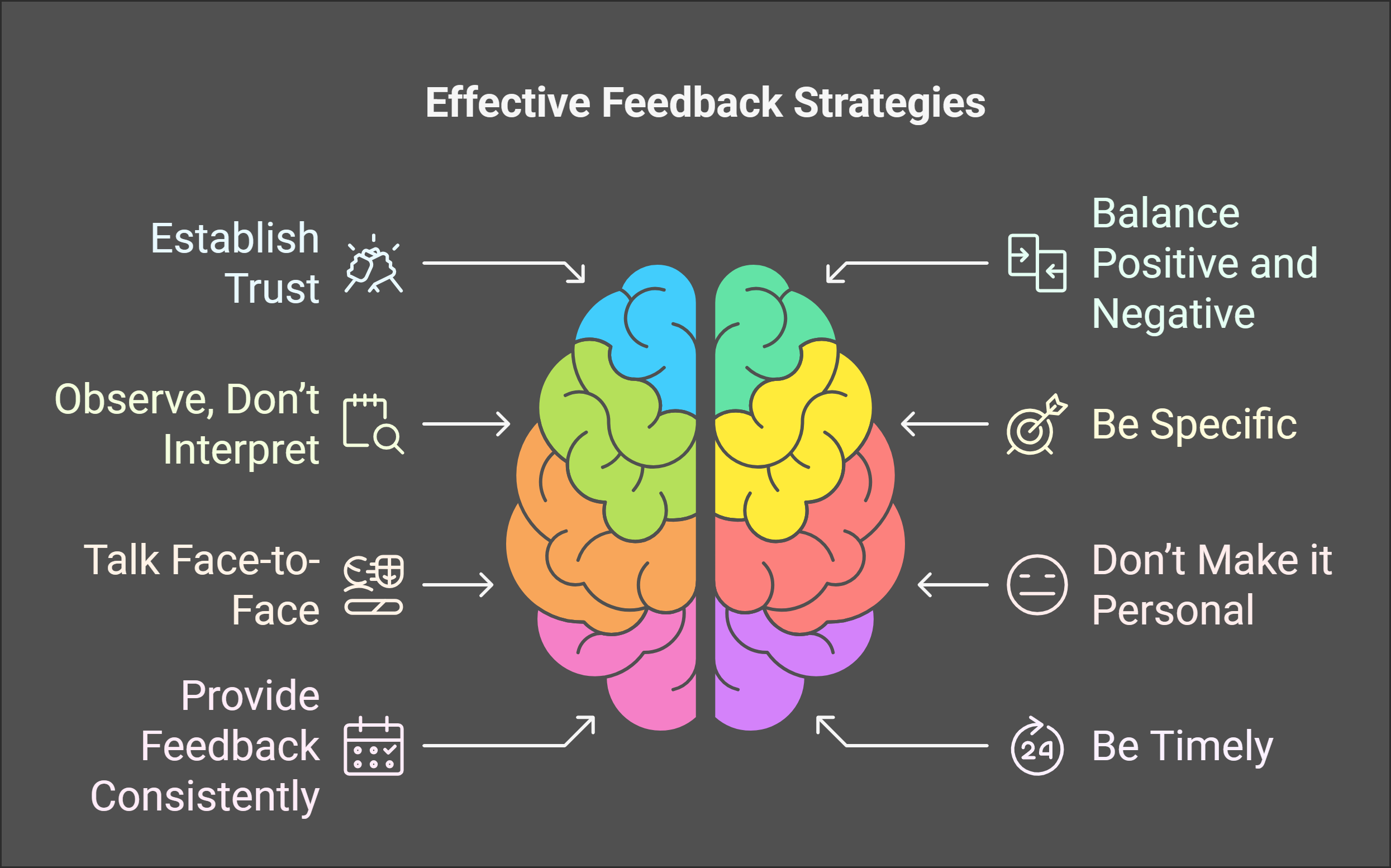
1. Positive Feedback
I was really impressed with the way you managed the client meeting last week. You communicated so clearly and addressed their concerns so well. I was proud to have you represent our team! And that is just one instance. I have been meaning to say you are doing a wonderful job overall. You have a nice way with clients that really shines through when you are on a call or in a meeting with them.
2. Constructive Criticism with Suggestions
The last project report I looked at was missing some key data points that are indispensable for our analysis. Could you see to it that all necessary data is included in future reports? A checklist could be used to ensure that all necessary information is included. I realise that this might seem kind of silly. But if it makes our reports complete and provides necessary context for what we are doing, isn’t it worth your time?
3. Balancing Positive and Negative Feedback
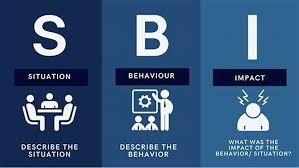
Your presentation held the audience’s interest the whole way through; it was that engaging and well-structured. Still, I think it would be good to include more statistical data to back up your arguments. I say this because when we are in a battle of wits with someone, we need to make our points as unassailable as possible. And, because it is true: More data would equal more engagement, if only because the audience would get to see your arguments in even clearer relief.
Conclusion
Constructive feedback is something that most of us could improve upon. The first reason for that is simple: We do not often receive direct instruction on how to provide feedback. Most of the time, we are simply told to be more specific. I was once given an assignment in graduate school where I was instructed to be as specific as possible while providing feedback. When I asked the instructor beforehand for an example of what my feedback should look like, he gave me an example of the work itself. When I pushed him again for an actual example of feedback he might give me, he paused and then muttered something like, “You’re going to have to figure this one out for yourself, since feedback is pretty subjective.” And he was right.

Case Study: Giving Constructive Feedback in a Scientific Advisory Context
Background
At a leading pharmaceutical company, a senior scientist named Dr. Laura was given the task of mentoring a new postdoctoral researcher, Dr. James. The work of this young scientist was at a standstill and on the verge of going south because, in the judgment of Dr. Laura, it was too early to tell if the project really had any merit. Dr. James’s work was not really going anywhere, which made it that much tougher for Dr. Laura to give him the necessary constructive criticism he required to succeed.
Implementation of Constructive Feedback
A private meeting with Dr. James was scheduled by Dr. Laura to discuss his reports. Right off the bat, she wanted to convey that he showed incredible commitment to the project and that his ideas really were innovative. That made beginning the conversation much easier. Using “I” statements, Dr. Laura spoke to some of the issues she had with the reports: “I had quite a bit of trouble understanding your methodology. Honestly, it felt as if some steps were missing.” Example after example illustrated her point. Dr. Laura’s tone was objective; it was clear that Dr. James’s personal attributes were not in question. After laying out the issues, she offered some suggestions that could realistically be implemented in order to remedy the situation: “You could really help the reader understand your methodology if you laid out each step with a bit more detail. If you included some more precise measurements, I think your results would be much stronger.” When it came to Dr. James’s next steps, Dr. Laura encouraged him to ask questions.
Results
Dr. James held the feedback in high regard and felt it was supportive and corrective, rather than critical. He followed all of Dr. Laura’s recommendations to the letter and produced much improved reports. He not only performed better because of this feedback, but he also reinforced a very positive professional relationship with Dr. Laura. They both now see the value of giving better feedback in a scientific advising context.

Practical Exercises to Enhance Feedback Skills

Course Manual 6: Receiving Feedback Positively
Carol S. Dweck, an esteemed psychologist and the author of Mindset: The New Psychology of Success, highlights the significance of accepting comments about your work through her growth mindset theory. Viewing one’s abilities and intelligence as qualities that can be cultivated, rather than as fixed traits, leads to a much stronger resilience. Dweck says that people with a growth mindset see feedback as a much more useful resource for not just determining how well they are doing but for figuring out how to do better. They are much more likely to take it to heart and use it because it does not feel like a judgment of their current abilities.
Receiving feedback with a positive mindset requires several key strategies, says psychologist Carol Dweck, author of the book “Mindset.” First is the matter of seeking feedback. People with a growth mindset actively solicit feedback from a range of sources and see it as a necessary ingredient in their process of improvement. They also listen to the feedback with great care and attention, allowing the giver to finish without interruption, so they ensure they understand the feedback completely. Next, these individuals do a bit of reflecting on the feedback before they respond to it. In this phase, they are doing some processing of the information and figuring out how to make the receiving of it feel less defensive and more productive.
Finally, Dweck talks about managing the defensive, or not-so-defensive reaction that some of us might have when we hear negative feedback.
Personal and professional growth hinge on an influx of feedback. Feedback renders visible the areas in which one really needs to focus for improvement and serves as a cornerstone for understanding what one is doing “right.” To cultivate a positive mindset around feedback, one must actively solicit it and make oneself receptive to its not-always-pleasant payload. One’s openness must go beyond the level most humans attain with strangers; feedback is seldom welcome if the pond into which it must drop is not deathly still. This essay looks at the fresh-faced forwardness of feedback’s approach, at the ways one can use it without too much inward squirming, and at the always positive upgrades, making oneself a veritable receptacle for the not-so-bitter pill of feedback.
Encouraging and Welcoming Feedback
1. Actively Seek Feedback
To receive feedback positively, you first need to seek it out. Asking for feedback shows that you are concerned about your development and are willing to make changes where necessary. It is not easy to ask someone to critique you, but you should try to make it a part of your routine after completing a project. One possible way to frame this conversation is: “Could you provide some feedback on my performance and any areas where I could improve?”
2. Establish an Open Environment
Creating an open environment where feedback is welcomed can encourage others to provide you with constructive comments. This approach shows that you value their opinions and are committed to continuous improvement. For example, during team meetings, you might invite feedback by stating, “I appreciate any suggestions or feedback on how we can improve our processes.”
3. Demonstrate Feedback Appreciation
Showing gratitude for the feedback you are given—no matter the nature of it—is very important. It indicates you respect the effort someone has undertaken to give it and that you are open to learning from it. For instance, you might reply with something similar to, “I thank you for your feedback. I appreciate the thoughts you’ve provided and will consider them going forward.”
Techniques for Processing and Responding to Feedback
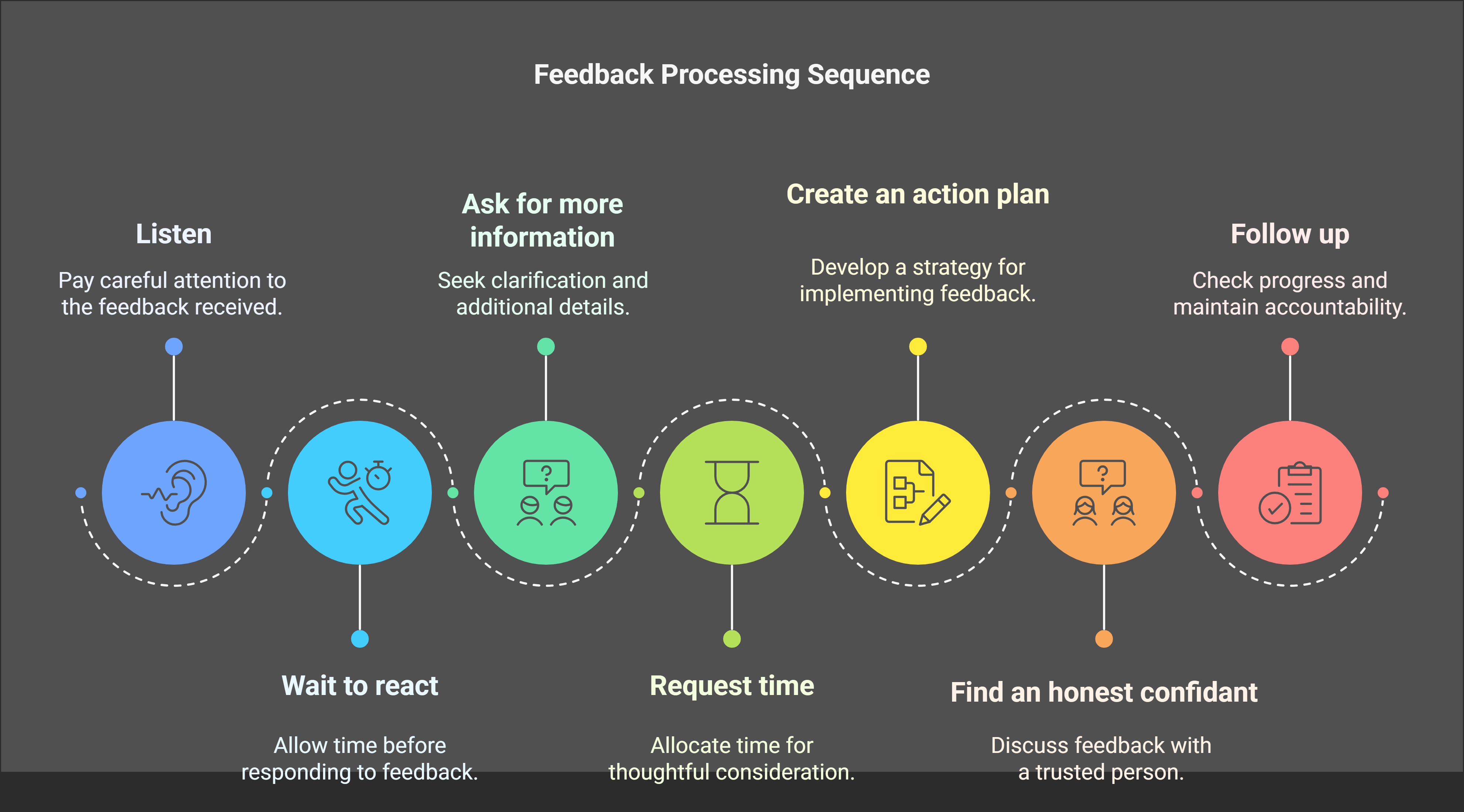
1. Attend to Feedback Without Interruptions
When feedback is being given, it should go without saying that one should listen attentively and not interrupt. It is essential to understand fully what is being said and what is meant. To show that one is listening and paying attention, it is good to maintain eye contact and maybe even a knowing nod or two. It is even better if one can suppress the impulse to interject with something like, “But I thought…” or “But that’s not true…” or “But let me explain what I meant.”
2. Think About the Feedback First and Then Respond
Taking time to think about the feedback first helps in getting hold of the information and producing a response that is not just a reaction. It allows the writer to consider the feedback given in an objective way. For instance, after being given feedback, a writer might say, “Thank you for your feedback. I need some time to think about this, and I will get back to you with my response.”
3. If Needed, Ask Clarifying Questions About the Feedback
If the feedback is unclear or if you need more information, asking clarifying questions can help you better understand the feedback. This approach shows that you are committed to doing better and ensures that you have all the information necessary to act on the feedback. An example of a clarifying question is, “Can you provide specific examples of when you noticed this behaviour?”
Managing Defensive Reactions
1. Acknowledge Your Feelings
It is normal to have a defensive reaction when someone is criticising your work. When you feel defensive, take a deep breath, and remind yourself that the person providing the feedback is doing so in an attempt to help you improve your work. If this does not help you manage your emotions, try thinking of the criticism as a very rigorous and intensive form of editing.
2. Embrace a Growth Mindset
Having a growth mindset means viewing feedback as something that can help you learn and grow rather than as a personal affront. This frame of reference allows you to view feedback in a more constructive way and reduces the natural tendency to be defensive. For example, instead of thinking, “I’m just not cut out for this,” think instead, “With practise and good feedback, I can become proficient.”
3. Stay Calm and Collected
It is crucial to maintain a calm and collected demeanour when receiving feedback to prevent the body from displaying defensive reactions. It displays openness to the feedback and a willingness to consider it objectively. For instance, if unexpected criticism is hurled your way, take a moment to not let it rattle you before responding.
Using Feedback for Personal and Professional Growth

1. Identify Items You Can Act on from the Feedback
It can be easy to dismiss feedback as simply more judgment to accumulate next to the “good job” notes on your last-ever college report card. But a teacher’s actual intent in giving you feedback is to get you to improve. So, when you receive feedback, especially if it is of the negative variety, try to step back and see if you can identify some items you can act on.
2. Set Improvement Goals
It can help to use the feedback to set specific, measurable, achievable, relevant, and time-bound (SMART) goals for yourself. These goals can help you track your progress and keep you motivated. For example, suppose the feedback you receive points to time management as an area needing improvement. You might then set the goal of completing all high-priority tasks each day by noon and low-priority tasks by the end of the day.
3. Monitor Progress Continuously
Keeping a close eye on how you are doing will keep you on the right path and will also, I think, necessitate some adjustments that may be good for you and may have gone under your radar until now. More directly, though, my “plan” (and its framework of goals and sub-goals) gives me a reason to check in regularly, with a kind of dashboard, to see if I am still heading across this vast sea of time toward the lighthouse on the other side.
Embracing Feedback as a Tool for Development
1. Foster Resilience
Accepting feedback positively can aid in developing resilience. It instructs you in dealing with [not] taking criticism badly and teaches you to come back from setbacks. For instance, if you receive negative feedback about a project, use it as a means of bettering [yourself for] future projects.
2. Skills Enhancement
Using feedback to spotlight areas that need improvement can enhance your skills. It lets you zero in on the parts of your work that need a little extra effort to develop. For instance, if a selection of your writing gets the comment, “You narrate better than you argue,” you have been handed a specific weakness that partly defines your current writing skill set. To develop your argumentation, you would focus on this weakness.
3. Ongoing Success Ensures Development
Accepting feedback as a part of development propels you toward success in several life arenas. It encourages you to seek and squeeze out every drop of good juice—every good instruction and piece of advice—that can help you improve continuously. And continuous improvement leads inevitably (we think) to long-term success. Of two guys working at the same company who might be up for the same promotion, the one who takes feedback better (and, yes, uses it better) is more likely to end up at the upper levels.
Examples of Receiving Feedback Positively
Example 1: Professional Feedback
Sarah, a marketing manager, gets feedback from her supervisor that her most recent campaign did not meet the expected engagement metrics. Instead of becoming defensive, Sarah listens attentively, asks clarifying questions about specific areas of improvement, and thanks her supervisor for the feedback. She reflects on the feedback and identifies that her campaign lacked a strong call to action. Sarah sets a goal to improve this aspect in her next campaign and seeks additional training on effective marketing strategies. By embracing the feedback, Sarah not only improves her future campaigns but also demonstrates her commitment to professional growth.
Example 2: Academic Feedback
James, a university student, receives feedback from his professor that his research paper needs more critical analysis. At first, James’ reaction is to feel disheartened, but he recognises the inaccuracy of this feeling and corrects it by acknowledging and then reflecting on the feedback. Next, he makes an appointment with his professor. During this meeting, he gets from his professor the specific details about why the paper does not quite hit the mark that it needs to. “It’s like this, and it should be more like that,” his professor says. After the meeting, James rehashes the feedback and the awkward meeting. He then works on revising the paper. The plan is to fix the paper and then use the “more critical analysis” part of the feedback as a sign to help him calibrate his performance on future assignments.
3. Example 3: Personal Feedback
Emma gets a close friend to give her feedback about how she interacts with other people. The friend’s feedback is that Emma tends to dominate conversations and does not listen as much as she should. This feedback is a bit surprising to Emma. However, she listens without interrupting and thanks her friend for being so honest. She then reflects on the behaviour that her friend highlighted. Upon this reflection, Emma realises that she can be overly eager to express her own thoughts. Emma decides to make active listening a practice and asks her friend for tips on that and on how to otherwise improve her conversational skills.
The Importance of Receiving Feedback Positively
There are several reasons why it is crucial to receive feedback positively. It is good for personal and professional relationships, it is vital for continuous improvement, and, quite simply, it is good for success. Receiving feedback creates dialogues that are good for both the giver and the receiver. I will explore these will explore these dialogues and the benefits they produce in more detail in the section that follows.
1. Strengthening Relationships
Receiving feedback with a positive attitude can build trust and open lines of communication. When feedback is responded to with appreciation and a true willingness to improve, it signals to the other person that their perspective is valued and that the party receiving feedback is deeply committed to personal growth. This is of utmost importance in a workplace setting, where responding positively to feedback from your colleagues can help to foster a collaborative environment.
2. Encouraging Ongoing Enhancement
Feedback yields invaluable information that can drive ongoing enhancement. When you seek feedback and act on it, you can better discern the areas in which you need to develop and, more importantly, you can make continual strides in narrowing those gaps. The work you do with feedback (or the lack thereof) exerts a powerful influence over the long-term maintaining of high performance and the reaching of high-reaching goals. Your life will not always be one of unending victories; this chapter’s opening vignette showed you that clearly. Yet you can and should make ongoing improvement part of your journey’s daily mantra.
3. Contributing to Overall Success
Accepting feedback as a means for development allows one to have an overall success in many aspects of life. It is a tool that assists in adapting to life’s ever-changing circumstances and in overcoming its many challenges. One area of life where this is important—more for some than for others—is in the professional realm. Many successful and not-so-successful entrepreneurs channel this tool to avoid many pitfalls and to lead them down a path of greater chances for business success.
Overcoming Challenges in Receiving Feedback
It can be tough to receive feedback, especially when it is critical or catches you off guard. But there are strategies you can use to overcome these challenges and really hear what the feedback is telling you. And when you hear it, you can use it for your growth. Let us look at some of the common challenges that come with receiving feedback and ways to address them.
1. Handling Criticism Constructively
Negative criticism can be hard to take; yet it may often provide the most potent and direct route to self-improvement. When faced with negative feedback, narrow your attention to the precise kind of behaviour or action that the critic wants to see improved. Do not focus on the fact that the critic thinks you need to change. For instance, if a critic says your presentation skills are lacking, do not wallow in the disparagement. Instead, delineate what you need to do to improve in this area.
2. Handling Emotions When Receiving Feedback
There are naturally emotional responses to feedback—defensiveness, hurt, or even frustration—that can get in the way of a person receiving the feedback in a constructive manner. When responding to criticism, try some classic stress-relief techniques, like deep-breathing or meditation, to calm the mind and re-centre yourself before saying anything back. If you feel your essential self is under threat, it is too easy to just curl up and huddle inside a defensive shell instead of attentively hearing out the helpful suggestions inside the critique.
3. Clarifying the Feedback
Occasionally, the feedback received is imprecise or incoherent, creating a situation where one does not truly grasp what needs to be enhanced. In these instances, it is of utmost importance to obtain clarification. This is not the time to be shy; instead, be bold and ask the sorts of questions that will lead to a productive understanding of the feedback and what actions can be taken to align the work more closely with the giver’s vision. For instance, should one ask for the level of detail that would make the report more “complete”?
The Role of Feedback in Career Development
Feedback is a tremendous factor in career development. It gives an idea about one’s performance and leads to the identification of weak points that need shoring up. Feedback comes from several different places. Most obviously, there is our boss. But there is also feedback from our work colleagues and, to some extent, feedback from our family and friends outside of work. Finally, there’s feedback from the work itself—its quality, its quantity, and its reception by others.
1. Performance Improvement
Feedback is a valuable source of information about your performance. It tells you not just what you are doing well but also what you need to work on to do even better. When you get a chance to act on this information—that is when you really get a chance to grow. For some of us, that growth leads to new careers, which is super exciting. For others, we take the information we have, act on it, and lead new teams within our organisations.
2. Setting Career Goals
Realistic and achievable career goals can be set with the help of feedback. It allows for an understanding that is much clearer concerning one’s present state and the actions that need to be taken to reach a desired endpoint in their career. Take, for instance, the goal to become a project manager. Feedback on one’s skill level concerning project management would give some guide so that the person could concentrate on and better those specific skills that need bettering.
3. Building a Professional Reputation
Your professional reputation can be affected by the way you receive and act on feedback. Responding well to feedback demonstrates a commitment to growth and an ability to handle constructive criticism. For many, this is the extent of thinking about feedback; however, there is much more to this story. For example, it is one thing to receive feedback when someone tells you what you did right and what you did wrong; it is another to receive feedback and then ask for more direction and clarity on what “right” looks like consistently.
Conclusion
Accepting feedback is a vital ingredient of both personal and professional growth. When you make a point of encouraging and welcoming feedback, listening to it with equal parts mind and heart, and you backstage coach the conversation with a set of clarifying questions, you can make that feedback work wonders on you. Follow-up prompts (the kind you do with a mindset of “I really want to get this right”) really turn a grain of feedback into a pearl of wisdom for you. Also, when feedback kind of hurts, it is pretty “growth mindset” (or “resilience-ish”) to say, “Ouch! That was hard to hear, but my gut tells me this is something I need to work on, so yay for me in 2021!”

Case Study: Receiving Feedback Positively in a Scientific Advisory Context
Background
A young scientist at a very respectable research institute, Dr. Emily was working on a project that was going to change things. She had been presenting her work to a panel of senior scientists who were supposed to be giving her feedback. At first, these sessions felt a little too close to the “you’ll sink or swim” evaluations that many of us have faced, and it was way too easy to feel like Dr. Mike’s project was the one that just might make or break his career.
Implementation of Positive Feedback Reception
Dr. Emily was determined to improve and decided to take a new approach to feedback, one that was more in line with a growth mindset. She took the initiative to not just ask for feedback but to encourage it from her advisors. This was early in her journey, and she was demonstrating her openness to learning and moving into a space of improvement. During the sessions where feedback was shared, I always noticed her listening. She was attentive and focused. There was no interrupting; it was as if the pause button had been pressed. She was taking in the points being made, making sure to note all the important things that she places into the session with her advisors. After the feedback was shared, I would say she was practising the art of reflecting on it before moving into a segment of responding.
Outcome
When Dr. Emily adopted a positive attitude toward feedback, her work improved significantly. She made valuable, almost instinctual, changes to her research methods. These changes led to results that any reasonable person would find more results that were more robust and more credible than before. Her advisors were so impressed by her newfound proactivity and attitude of gratitude that they were more willing to provide her with the kind of detailed, helpful guidance that is just a dream for many doctoral students.

Practical Exercises to Enhance Feedback Reception Skills
Course Manual 7: Non-Verbal Communication Skills
Allan Pease, one of the foremost authorities on body language and, along with Barbara Pease, the author of Body Language: How to Read Others’ Thoughts by Their Gestures, accentuates the critical aspect non-verbal communication is to effective interaction. For Pease, in harmony with a few other authorities on body language like Joe Navarro, founder of the non-verbal communication group at the Federal Bureau of Investigation, and Harvard professor emeritus Ray Birdwhistell, body language is part of a universal language. It is a sign language that works across cultures. Pease sees non-verbal communication, or sign language, as being vital for not only understanding and interpreting the messages we receive but also for sending clear and effective messages ourselves. He gives several distinct categories of non-verbal communication, including appearance, facial expressions, gestures, posture, and eye contact. He tells a few stories about historical figures—like British Prime Minister Winston Churchill—that serve to illustrate some of the points he is making.
The Importance of Non-Verbal Communication

Ways of communicating without words is what non-verbal communication is. This can be done through a multitude of methods, such as facial expressions, gestures, or even just the posture of a person. Eye contact and tone of voice are also major parts of this. When someone is speaking to you, the way they are using these non-verbal methods of communication can either complement what they are saying or make it seem as if they are saying something else altogether.
1. Facial Expressions
The power of facial expressions as non-verbal cues ranks among the highest. They convey the widest range of emotions, from the happy to the mournful, and the way one uses facial expressions can indicate anything from friendliness (a smile) to mocking (a wry grin). And yet, despite the facade that facial expressions portray, understanding them can be easy. Following are some common expressions and the emotions they are understood to convey. One might feel tempted to say that a smile is the best universal greeting. But as with any expression, culture often dictates the meaning—intended or otherwise—of a particular facial expression. In some cultures, a smile can indicate that one is mocking another.
2. Gestures
Movements of the hands, arms, or other parts of the body can communicate specific messages. A thumbs-up gesture commonly signifies approval or agreement, while a crossed-arms posture typically indicates defensiveness or resistance. But what about the appearance of non-gestures? When someone you are conversing with appears completely still, is that a message in itself? Or are they enacting something more like a non-gesture?
Even in the U.S. and other Western cultures, gestures can have different meanings in different contexts. Still, it is mostly understood that gestures communicate messages (and the messages can vary widely, as we have just seen). But what if the pain of a gesture is in the path taken by the gesture? What happens when conversations have enclosure as their main agenda?
3. Posture
The way we position our bodies can express attitudes and feelings. An open posture with arms relaxed and the body facing the other person often indicates that one is open and paying attention. On the other hand, a closed posture with arms crossed and the body turned away can signal that one is not really interested or is even uncomfortable. Maintaining a positive posture is one way we can help create a more engaging and receptive communication environment. Mirroring, or mimicking, the posture of another person is a well-known technique in the body language playbook. Merely imitating the other person’s body position can evoke feelings of rapport and trust, which can help smooth over any conversational bumps.
Interpreting and Using Body Language Effectively
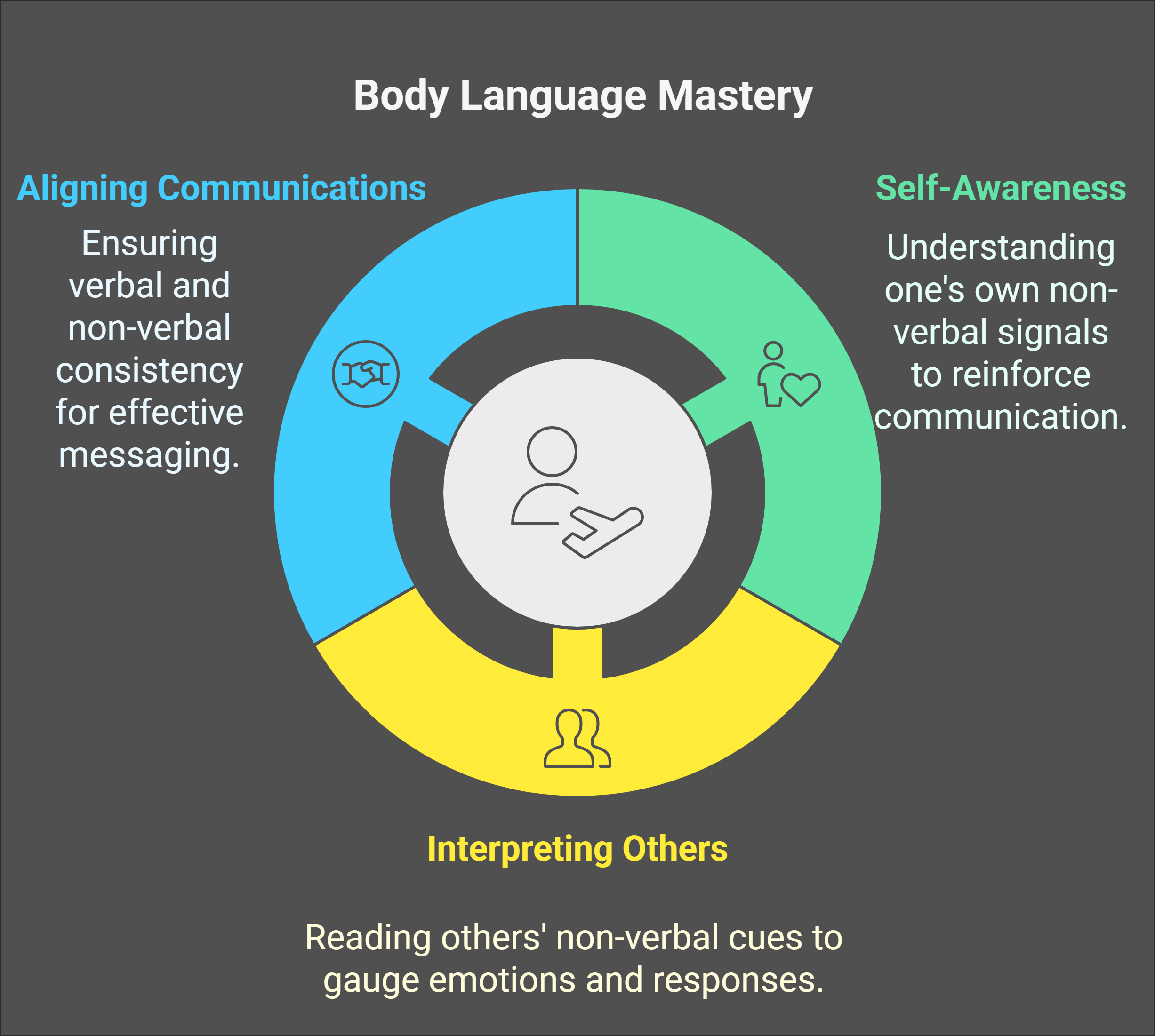
To interpret and employ body language effectively, you need to be conscious of your own non-verbal signals and good at reading the non-verbal signals of others. This skilled reading of signals makes good communication even better because it enhances clarity and accuracy. And when using body language with any degree of effectiveness, it is necessary primarily to know what it is that you’re doing.
1. Awareness of Your Own Non-Verbal Signals
Effective communication requires you to be aware of your own body language. This means not only observing the expressions on your face but also the gestures you are making and the way you are standing or sitting. Indeed, these non-verbal cues are key to effective messages because they can reinforce (or undermine) what you are saying. For instance, if you are giving positive feedback, a supportive smile and open posture reinforce the nature of your words. If you are giving ‘good to know’ messages, such as how someone might improve their work, not fidgeting and maintaining a calm demeanour help convey your persona as someone whose non-verbal signals are reliable.
2. Reading Others’ Non-Verbal Signals
The non-verbal cues of others can provide valuable insights into their thoughts and feelings if you know how to interpret them accurately. To do this, you must focus on the facial expressions, gestures, and postures of the people with whom you are interacting and consider the overall context of the interaction. For example, one person could provide all three kinds of non-verbal communication that signal discomfort: a facial expression that looks like a wince, and a tense, rigid posture that indicates they are not relaxed and are holding something back, as well as avoiding eye contact with you. Because all three kinds of communication can occur both ways (from you to the other person and from the other person to you), it is vital to interpret them correctly.
3. Congruence Between Verbal and Non-Verbal Communication
It is essential to guarantee that there is agreement between your spoken and unspoken communication if you want to ensure that clear and consistent messages are arriving at the other person. When your words and body language are parallel, the communication is enhanced in such a way that it seems more reliable, and it is more effective because it has a chance of being internalised in the other person. For instance, if someone is telling me about a time when they failed at something, and I am nodding my head or saying “uh huh” with a tone of voice that is not conveying much empathy, then they will not feel too emboldened or inclined to keep sharing.
If you say you agree but your body gives off signals that you’re not really into it (like no eye contact, for instance, or a posture that could generously be called “closed”), is it any wonder that the recipient of this mixed-message might not fully believe your front-stage expression of agreement?
Managing Non-Verbal Signals in Virtual Communication
In the age of technology, virtual communication will become predominant in our virtual reality. We must manage the signals we send nonverbally in a virtual world. Eye contact has become a whole new ball game: should the camera lens or one’s own image be regarded as the “audience”? Screens can distort one’s expressions. Adjusting the lighting and the camera angle can make it seem as though one is looking directly at the audience when, in fact, one is not. Virtual communication, then, is more than just the messages we send through spoken word or typed text.
1. Eye Contact
In virtual communication, making eye contact involves looking directly at the camera. This simulates direct eye contact with the other person and is one way of making virtual interactions feel more personal and real. If you are not looking at the camera when you are speaking, you are not really engaging the other person. As easy as this seems, it can be super distracting to try and do this when you are in your own image on the screen. But picture the other person talking to you and just imagine how much more engaged they would be if you were virtually looking them in the eyes.
2. Facial Expressions
It is vital to have a virtual smile. This might sound silly, but it can be a game-changer. Smiling, nodding, and showing appropriate reactions across the virtual space can make you seem engaged and responsive. Nodding while someone else is speaking can signal to them (and those watching with them) that you are paying attention to and understanding their message. Also, in virtual settings, facial expressions need to be more exaggerated than what would seem normal or natural in face-to-face communication. If stoic expressions can be unsettling in person, those same expressions can be downright creepy on camera.
3. Tone of Voice
Virtual communication requires a clear nonverbal component to work effectively. For this reason, tone of voice matters greatly—and for the same reason most people think of when considering the notion of encoding message content with a happy, sad, or mad amalgam of tonal features. Breathe easy, though: speaking to a virtual audience in a warm, friendly manner is a good way to start. Doing so is also an effective way to remain engaging throughout the presentation. Varying the pitch of your voice also to (1) not present in a monotonous fashion, and (2) keep your audience on the edge of their seats—wondering what you will say next—in and of itself is a sign of good vocal health.
4. Lighting and Camera Angles
Effective virtual communication necessitates proper lighting and camera angles. Ample lighting allows good visibility of the facial expressions that accompany effective communication. However, illumination is not sufficient alone. The camera must be positioned in such a way that it can capture the subject’s face in a flattering manner. Natural light is best for virtual interactions—when it is available. Failing that option, the next best solution is soft, diffused light. Whatever the setting, virtual communicators must avoid shiny spots of light as well as shadows on the face that signify an unprofessional appearance. Also crucial to professional appearance is the angle of the camera itself. It must not look up to the subject nor look down upon the subject; eye-level is the only angle that conveys a sense of professional equality suited to all types of interactions.
5. Maintaining an Engaged Posture
Even in virtual situations, keeping an engaged posture is crucial. To show engagement, it is best to sit up straight, lean in slightly (if appropriate), and avoid any kind of distraction in the virtual meeting space. Particularly in want of real estate on the screen, it is important to keep your face visible by angling your body toward the camera. If you are using a laptop, it may be better to continue with a kind of virtual presence by using the laptop’s webcam and continuing to face the screen when you talk; otherwise, you may be using the last of the upstage real estate.
The Impact of Non-Verbal Communication in Different Contexts
In many contexts—from personal interactions to professional environments—non-verbal communication is highly impactful. When you understand the different contexts in which non-verbal communication occurs, you can use this knowledge to enhance your interactions with others.
1. Personal Interactions
In building and maintaining relationships, people rely heavily on non-verbal cues. When most people think of “communication,” they think of talking and listening. But much of the conversation between people is carried out without words. American psychologist Albert Mehrabian has said that about 93 percent of interpersonal communication is non-verbal. When two people are together, they talk and listen to each other; but they also watch and pay attention to each other. They must if they want to understand fully what the other person is trying to convey.
2. Professional Settings
In professional environments, non-verbal communication plays a vital role in establishing one’s credibility and professionalism. For example, a job candidate can create a superb first impression on a potential employer by shaking hands firmly, sitting up straight with good posture, and making eye contact during the interview. Similarly, in a team setting, a member who uses good attentive body language demonstrates to the group that he or she is committed to and engaged in the team’s work. Leading and managing a team also requires non-verbal communication. A manager who uses positive body language can inspire confidence and motivate the team to reach their goals.
3. Cross-Cultural Communication
Communicating without words—through actions, expressions, or presence—takes on a different flavour in every culture. This is why it is imperative to know the almost infinite ways non-verbal communication can vary when you are attempting to converse across cultural lines. If you are sharing a space with someone from another culture, they may well have a completely different interpretation of an action you are performing—something in their culture that pops with meaning, good or bad, without you having a clue. Then again, you may be reading them completely wrong, too. For all this and more, non-verbal communication can get very messy when the cultures involved are in any way divergent.
Enhancing Non-Verbal Communication Skills
To improve your non-verbal communication, you must continuously practice and be self-aware. Here are some strategies to help you get better at this important part of communication:
1. Self-Awareness and Observation
To develop self-awareness, pay attention to your own non-verbal cues and understand how they affect your communication. It can also be helpful to closely observe others and learn from their unspoken interactions. When you pay attention to your own non-verbal communication and the non-verbal communication of others around you, you will start to understand the implicit rules of body language. In other words, you will be able to “read” people better, and in turn, this will help you improve your own body language. Besides closely observing yourself and others, writing can also help you become more self-aware. Keeping a journal of your non-verbal interactions with others can help you really think about your own communication style and make necessary adjustments.
2. Feedback and Reflection
Asking others for feedback and reflecting on your non-verbal communication can help you pinpoint areas for improvement. For example, you might ask a trusted colleague to evaluate your body language during presentations. You could also solicit some general feedback on your actual communication efforts if you are feeling particularly brave. Whatever the case, try to listen well to the feedback you receive. Make sure to think about it all critically and use it to inform your next steps.
3. Practising Active Listening
Fully engaging with the speaker and using non-verbal cues to indicate your attentiveness are essential to active listening. This involves being attentive enough to maintain eye contact and to nod at the appropriate times, as well as to use facial expressions that indicate you understand what the speaker is saying. Practising active listening can enhance your ability to interpret and respond effectively to non-verbal signals that a speaker may be sending. Another way to demonstrate your understanding and reinforce your engagement with the speaker is to sum up or rephrase what the speaker has just said.
4. Mindfulness and Stress Management
Being aware of your emotions and managing stress can help in keeping your non-verbal communication positive. But what happens when you are under stress or feeling negative? Your body could potentially throw off non-verbal cues that are not congruent with what is going on in your mind. For instance, taking deep breaths can help keep you calm and stress-free during a tough conversation. Mindfulness in these moments can lead to more “positive” non-verbal communication.
Examples of Non-Verbal Communication
1. Example 1: Job Interview
In a job interview, non-verbal communication has a huge part to play in establishing a favourable impression. Parts such as making sure to keep eye contact, offering a confident handshake, and sitting with posture that demonstrates quiet and strong confidence are vital to establishing a near flawless non-verbal interview. And frankly, it is very hard to screw up non-verbal communication if you’re listening and engaging in the manner the previous suggestions embody. Parts of the previous suggestions that are more engaging in nature also carry with them a greater amount of non-verbal communication possibilities.
2. Example 2: Public Speaking
In effective public speaking, positive non-verbal communication can boost your message’s delivery. Purposeful gestures, good eye contact, and a varied tone of voice can make your presentation more engaging. For instance, hand movements can be used to emphasise key points, and facial expressions can be varied to achieve desired effects. You can also engage the audience by moving around the stage and using different spatial dynamics. All these elements can make your speech more dynamic and your message more compelling.
3. Example 3: Team Meetings
Team meetings can be collaborative and understandable when non-verbal communication occurs. For instance, one can use open gestures, maintain eye contact with team members, and have an attentive posture that creates a positive and inclusive environment. One can also encourage (or force) communication and teamwork by nodding and smiling in response to what others have said. These are all good ways to use non-verbal communication to one’s advantage in a meeting. Visual aids can be a great boost to non-verbal communication as well, especially when one is making deliberate eye contact with different team members throughout the meeting.
4. Example 4: Customer Service
In customer service, how well a customer interaction turns out can depend greatly on how satisfied the customer was. This is because customer service is, at its essence, providing a service to a customer so that they are satisfied. Non-verbal communication plays a significant role here because, although a customer service representative might say the right words, the way they are said and the manner in which the representative behaves can make all the difference.
Conclusion
Personal and professional interaction requires a skill set that is predominantly not verbal. And yet, we often overlook the clarity and even personal intimacy that can come from visual signals—signals such as facial expressions, gestures, and posture that are so vital to communication. Whether interacting in real life or virtually, the clarity of your own visual signals and your ability to interpret the visual signals of others form the bedrock of effective communication. “They say eyes are the windows to your soul, but for humans, eyes are also windows to one’s visual communication medium.” When it comes to the virtual world, we often substitute other sensorial components in place of a face-to-face interaction. “To effectively communicate with visuals, use the same basic strategies as for messages delivered in person.” You must first command your own visual space with fluidity and fearlessness. And then, if your stage is well lit and your body is engaging enough in (and occasionally out of) the camera’s eye, the visual medium will indeed serve (as it ought) as a powerful communication tool, in both real and virtual settings.

Case Study: Non-Verbal Communication Skills in a Marketing Agency
Background
An effective communication is very necessary in a marketing agency for prospering client relationships and team collaboration. Sarah, a senior account manager, oversees a team that serves a high-profile client. Even though Sarah and her client team are very good at verbal communication, they have suffered some recent misunderstandings that led to client dissatisfaction. These misunderstandings have occurred despite the use of a project management tool that the client and Sarah’s team both access.
Implementation of Non-Verbal Communication Skills
Sarah started a training program on non-verbal communication. She emphasised the importance of body language, facial expressions, and posture. She wanted everyone to understand that they were always sending messages about what they were thinking and feeling all the time, and especially when interacting with clients. For meetings with clients, she wanted her team members to have open postures, to make eye contact, and to use gestures as a compliment to their verbal communication. One meeting in particular stood out. Sarah was with her team, presenting to a client. She had been watching everyone’s non-verbal communication very closely. She noticed one team member, John, was not sending particularly good messages. He was slouched over and not even close to making eye contact. Sarah knew this was not a good signal to send the client.
Outcome
Concentration on non-verbal communication resulted in significant progress in client interaction and team dynamics. This scenario shows how vital non-verbal communication is when one works in a marketing agency.

Exercise
• In what ways did the advisor’s physical demeanour affect the client’s comprehension and involvement?
• Which non-verbal signals were most potent in getting the message across?
1. Have participants work in pairs, facing each other.
2. Give each pair a simple, two-person task to finish together, without talking (e.g., putting a set of objects in a certain, specified order).
3. The pairs must use non-verbal communication. That might seem obvious, but it is really not. When people are told to use only non-verbal communication, they still tend to communicate in the ways we might expect a person who is talking to do.
4. Make some observations. And have some fun at their expense if you like. 5. Discuss this observable behaviour as a group.
• What obstacles did you encounter when depending entirely on non-verbal communication?
• What non-verbal signals were most useful to you in finishing the job?
1. Split participants into little cliques.
2. Each participant will take turns in the roles of feedback giver, receiver, and observer.
3. The feedback giver will provide some kind, constructive feedback and do so with excellent non-verbal communication. This means a couple of things: the feedback giver needs to be clear and supportive. Non-verbal communication is important when it comes to providing feedback because the receiver obviously has to pay attention to what is being said, but also to how it is being said.
4. When the observer’s role comes up, make sure to switch who is observing each time so all can be seen to the observer’s advantage for learning purposes as well as the receiver’s experience.
5. Much can be learned from as well as taught through this process, so make sure to discuss what is seen as a group.
• What was the impact of non-verbal communication on how the feedback was received?
• Which non-verbal cues were most influential in making the feedback come across as supportive and constructive?
Course Manual 8: Building Working Relationships
Keith Ferrazzi, author of “Never Eat Alone: And Other Secrets to Success, One Relationship at a Time,” emphasises that if you want to achieve professional success, you must build effective business relationships. For Ferrazzi, networking is not just about exchanging business cards. It is about creating genuine connections based on trust and mutual benefit. He offers several key strategies for using these relationship-building techniques to cultivate business relationships. The first strategy is generosity. He suggests giving help and sharing knowledge without expecting anything in return. He calls this Givers Gain. Using this strategy, in the long run, you will develop business relationships based on trust because you are not using the relationship for your own gain. You are building goodwill with the person. The second key strategy is open communication. For Ferrazzi, this means being transparent, approachable, and a good listener. The third strategy is maintaining the relationship. Follow-up is critical here because the communication acts as the oil that keeps the engine running smoothly until the next key moment in the relationship that warrants an oil change. Finally, Ferrazzi talks a lot about being authentic when it comes to using these strategies and building relationships. He urges his followers to be themselves and use these strategies sincerely.
Strategies for Effective Teamwork and Collaboration
The foundation of strong working relationships is laid when effective teamwork and collaboration occur. The implementation of strategies that encourage open lines of communication, the setting of clear and attainable goals, and the leveraging of individual unique strengths allows teams to work more in concert and reach their objectives more efficiently.
1. Open Communication
Transparent and active communication is of utmost importance in cultivating team trust. This means not just sharing information but doing so in a way that involves all team members, making them feel included and important to the whole. And it is not just about talking; it is about listening. Open communication is about ensuring that everyone can be part of the dialogue. As with any form of communication, there are many ways to go about it, but I will outline a few that I think are simple and effective:
– Speak in a relaxed manner.
– Do not hesitate to share good and bad news.
– Use video calls whenever possible.
– Make periodical group meetings at which all members of the team can speak without fear of interruption.
In a newly formed team working toward a marketing milestone, such as a new campaign, regular meetings can be held where each team member brings the rest of the group up to date on their progress. These meetings can serve as a kind of obstacle course where we discuss any difficulties we have hit and collectively find ways over, around, or through them. By maintaining effective communication, both in person and online, we can keep the campaign on track and finish it strong.
2. Setting Clear Goals
Providing direction and purpose for the team is what establishing clear, attainable goals accomplishes. When the members of a team all understand the clarity and purpose of a goal, they figure what is on them to do, what is off-limits, and what they need to do if they are going to claim that the goal has been achieved. For example, a sales team is not likely to lack motivation if its members know to aim for a net gain of, say, 1,300 customers and that they have a year in which to achieve that.
In a software development team, defining precise milestones for the various phases of a project—for example, the initial design, prototype development, testing, and final deployment—can help make certain that all team members understand what they need to achieve and when they need to achieve it. Moreover, these milestones can also serve as evaluation checkpoints to assess both individual and collective progress and implement any needed changes to keep things on track.
3. Leveraging Individual Strengths
Identifying and using the distinct strengths and skills of each team member can boost overall team performance. Assign tasks you know individual members can handle, and your team will work more efficiently and produce better results. For example, in a design team, using a member’s graphic design expertise can guarantee the visual elements of the project are stunning.
In a project team that cuts across functions, pinpointing an individual with solid analytical capabilities and directing that person to take on data analysis work can culminate in reports that are both more accurate and more insightful. Comparably, a team member who is an outstanding communicator might be assigned to do the presenting to clients, thus ensuring that the work of the team is being effectively communicated to its stakeholders.
4. Regular Team Meetings
Providing a platform for connecting and sharing within the team, regular team meetings are invaluable. They enable members to share updates and address any issues collectively and serve to maintain team alignment. Team meetings ensure that everyone knows what the team is up to now and what it will be doing soon.
A customer service department can use a weekly team meeting as a venue to talk about the kinds of problems that customers run into, the sorts of successful resolution strategies that team members can share and reapply, and the potential areas for improvement that might help team members serve customers even better. The team can also use the gathering to sharpen and clarify the customer service mission and to work on team-building skills.
5. Collaborative Tools
Using collaboration tools, like project management software, instant messaging platforms, and shared documents, can improve coordination and smooth out workflows. These tools allow for real-time communication and collaboration and make it simpler for teams to do their work and for team members to communicate with each other, no matter where they are.
A dispersed team focused on a product launch can track tasks, assign responsibilities, and monitor progress with a public management tool, like Trello, which can display the project visually. Each team member can see on Trello what tasks they are responsible for and what the deadlines are for those tasks. Trello does not improve coordination by making team members more aware of what each team member is doing but rather by making each team member more aware of what they themselves are doing.
Managing and Resolving Conflicts
Any workplace will conflict, but how they manage can really impact relationships. When addressing issues, they need to be done smoothly and promptly. And when that happens, someone needs to listen to all the parties involved to make a resolution work out for everyone.
1. Addressing Issues Promptly
Addressing conflicts promptly can prevent them from blowing up into big problems. It can show that an organisation is really committed to keeping a workplace harmonious. And early intervention can be a real-time saver, too. Resolving a conflict well can keep the whole office from working around a big, stinky problem. And if two team members are having a disagreement that looks like it is about to become or already is a team-wide issue, then a manager can step in and facilitate a discussion that makes the resolution work better and happen faster.
A sales team might find itself in a disagreement between two of its members over how to approach a client pitch. In such an instance, the team leader can step in and talk with the two members to find out just what the disagreement is about. Once the disagreement is understood, the leader can go about finding a solution that hopefully results in a unified front when it comes time to actually pitch the client.
2. Active Listening
Here is the given text:
“Active listening involves fully concentrating on what the other person is saying, understanding their perspective, and responding thoughtfully. This approach helps in validating the feelings of all parties involved and finding common ground. For instance, in a conflict between two colleagues, active listening can help each party feel heard and respected, and it can facilitate a more constructive dialogue.”
Now here is the rephrased version:
“Concentration is key when it comes to listening actively. You must concentrate on what the other party is saying, understand their point of view, and respond in a way that shows the other person you got what they said, and you are now working with it in your mind as you speak. This is much more than mere acknowledgment; it is true validation of what the person said and their reason for saying it. In the case of two colleagues arguing, this could be a prime technique to employ, helping both find the low road to a more constructive dialogue.”
In a marketing team, when there is a conflict that needs to be resolved, the manager can practise active listening during the resolution meeting. Each team member gets to express concerns, and the manager lets them do this without interrupting. After the team members have expressed their concerns, the manager takes time to summarise and reflect what has been expressed. This ensures that all viewpoints have been considered before the resolution is drafted.
3. Seeking Mutually Beneficial Solutions
Resolving conflicts in a positive way, so that relationships remain intact, usually requires finding solutions that benefit all parties involved. When conflict arises, it often centres around resources, time, or recognition. Battling over these limited commodities can lead to a win/lose mentality. However, some win/win solutions can resolve the conflict while also keeping relationships intact.
One such potential solution involves looking for ways to better distribute the time, recognition, and tasks from the outset.
In a project team where conflict exists over the assignment of responsibilities, the team leader can hold a brainstorming session to consider and explore ways to allocate tasks. This session serves as a means to gather input from all team members and to digress into the area of team member preferences. By using the approach of studying project team member strengths and weaknesses in conjunction with their expressed preferences, the team can arrive at a solution that maximises the appearance of perfect efficiency.
4. Empathy and Problem-Solving Mindset
When conflicts are approached with empathy and a mindset directed toward problem-solving, the emotions and motivations of the other party are understood, and the focus is on finding practical, applicable solutions. This approach might help in de-escalating a tense situation and could lead to a conflict resolution that feels collaborative. For instance, a manager could understand that pushing an employee toward a deadline when that person is already swamped could elicit some pretty negative emotions. But a manager who pushes in that way is not showing empathy, and the relationship between employee and manager might shrink as a result.
When two team members are in conflict over differing work styles, the team leader can show empathy by recognising and validating the difficulties each person is having. The leader can then redirect the team’s focus to the shared goal they all have—making their project a success. Although it is difficult when two (or more) team members are at odds, a leader can help (1) find common ground and (2) develop complementary (read: not identical) strategies that (3) enable all sides to work together more or less comfortably.
Creating a Positive and Inclusive Work Environment
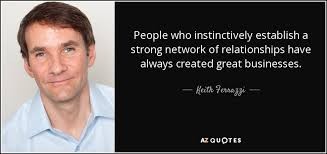
A work environment that is positive and inclusive encourages respect and promotes diversity. Such an environment recognises the contributions of all team members and fosters a sense of belonging. Employees in this environment are highly motivated and perform at their best.
1. Promoting Diversity
Advancing diversity means establishing a workplace that prizes and honours differences in identity, experience, and viewpoint. A diverse team can bring an astounding range of ideas and methods that might not otherwise be part of the conversation. For example, recruiting individuals with various forms of disability can shed light on the almost limitless potential of assistive technologies.
In a technology firm, assembling a development team that is not only male and female alike but also composed of individuals of various ethnicities and ages can lead to the creation of products that are more user-friendly and inclusive. This is not because—perish the thought! —the predominantly white male Silicon Valley workforce is engaging in the kind of tokenism that has long been the kind of lip service to diversity that gets blasted in op-eds.
2. Encouraging Respect
To prompt an environment of respect, team members must be fostered into feeling valued and appreciated. This requires far more than mere lip service to “respecting” human differences; it mandates a real commitment to leading with a common humanity, which is the first step toward harmonious interactions. You must act with good sense and good faith. Then, you must demand that same commitment from all team members and divide the SWOT discussed above among all team members to ensure collective responsibility for workplace respect.
In a law office, promoting respect can mean acknowledging the input of junior associates during team discussions and making sure their suggestions are really listened to and thought about. The firm can make strides with this kind of atmosphere and enhance the kind of ‘collaboration nation’ that can really help junior and senior associates alike.
3. Recognising Contributions
Acknowledging the contributions of team members can lead to improved morale and motivation. Formal recognition (like “Employee of the Month” awards) can serve this purpose. So can informal recognition (like saying “good job” in a team meeting). Both kinds of recognition are helpful. But a recent study highlighted the value of recognising the accomplishments of entire teams, rather than just individuals. This is the same kind of recognition that teams can and should give to one another in team meetings.
In a healthcare setting, it can boost job satisfaction and foster a better work environment when employees are recognised for their efforts. By awarding appreciation events and giving out accolades, healthcare employers can express gratitude not only to the front-line staff who interact daily with patients but also to the many unseen workers whose hard work and commitment allow the patient-facing healthcare workers to do their jobs.
4. Fostering a Sense of Belonging
To engender belongingness, you must accomplish inclusion. Inclusion is achieved when all constituents feel connected to the whole and enjoy their rightful place within it. The processes that lead to inclusion, and thereby to a sense of belonging, are not secret or mysterious. They mainly involve encouraging team members to get to know one another—bonding through shared experience and conversation. Another process that contributes to inclusion and belonging is the creation, cultural or otherwise, of the “right” conditions that allow for inclusivity.
In a school, creating a sense of belonging among new teachers can involve establishing mentorship programmes where veteran teachers work closely with inexperienced hires. By constructing collegial relationships and providing them with essential near impressions, the school can serve as a bridge in leading new teachers across the chasm from not knowing to knowing the school community.
Conclusion
In the productive and harmonious workplace, it is essential to build and bolster working relationships. Open lines of communication pave the way to effective teamwork and collaboration. Clear goals ensure everybody is on the same page. And you might think that using the word “individual” is a slip-up, but it is on purpose; each person’s strength must be leveraged to create a high-functioning office, and regular team meetings help everybody know what is going on. When a healthy working relationship exists, conflicts are rare; when they do arise, however, they must be managed and resolved. Healthy conflict management requires prompt attention to the issue at hand, all parties to the conflict must be listened to (and that means “actively listening”), and a mutually beneficial solution is the desired endpoint. Of course, it is always good to have a plan for what to do if a conflict arises.

Case Study: Building Effective Working Relationships in a Legal Firm
Context Baker & Partners, a leading law firm, struggled with collaboration between its junior associates and senior partners. Unclear communication led to poor collaboration. The overall misunderstanding of the “lawyer role” by juniors and the lack of understanding of “why” and “how” to work with juniors by seniors created inefficiencies in the firm and affected both its performance and its prestige.
Executing Relationship-Building Strategies
To tackle these problems, the company started a program to develop better working relationships. They started having regular team-building exercises. They instituted a mentorship program between senior and junior associates, pairing the latter with a firm partner. The new initiatives were aimed at getting people to communicate openly, foster relationship bonds, and work together toward clearly defined and mutually shared goals. Weekly team meetings were set up to ensure all members of the team were working in concert with ongoing projects and deadlines. All team members shared the digital workspace to cultivate an atmosphere of better coordination and sharing of information, gossip, and other work-related chit-chat.
Result The initiatives caused enormous boosts in the firm’s working relationships. They improved the associates’ sense of support and value, which raised their job satisfaction and productivity. They made senior partners more aware of the understanding that associates need during busy times and more aware of the need for the kind of mentoring that helps associates learn to be good lawyers. They delivered greater “collaboration” and “inclusion” in the office. They propelled the firm toward higher client satisfaction and more efficiently completed projects. They caused a substantial upswing in the firm’s overall performance as measured by these two principal indicators.

Practical Exercises to Enhance Business Relationships
Course Manual 9: Dealing with Difficult Communication Situations
Crucial Conversations: Tools for Talking When Stakes Are High offers a comprehensive guide to navigating emotive, high-stakes conversations. The book emphasises that the most impactful conversations are not necessarily the easiest and that the potential cost (however that may figure into an individual’s or organisation’s bottom line) is huge if one fails to handle such conversations with skill. But what does it mean to “have a skilled conversation”? The authors —Kerry Patterson, Joseph Grenny, Ron McMillan, and Al Switzler —outline some specific strategies that, when followed, they claim will lead to having a skilled conversation (which, in my mind, is to say a conversation that has a good chance of reaching a non-divisive conclusion). Part of what makes these authors successful is that they first establish a theoretical foundation. In this case, they argue for creating a “safe environment” in which all parties can express their views. Once you have begun with a skilled opening (and opening a difficult conversation is indeed a skill), there is still a long road ahead. One family member set the stage for a recent Christmas dinner conversation by suggesting I was an authority figure as I engaged the authors’ ideas. At least I got started without having given a “lead off” that allowed my wife and kids to make me into something monstrous heading into the dinner conversation.
Identifying and Understanding Challenging Scenarios
Identifying tough communication situations as they arise is critical for setting up an appropriate response. Misunderstandings, conflicts, and high-stakes conversations are the three main scenarios that tend to occur.
1. Misunderstandings
When there is a discrepancy between what is communicated and what is understood, misunderstandings can occur. These might arise from ambiguous language, cultural differences, or sheer assumption. Take, for instance, a team member who interprets a project deadline as something that can be stretched when, in reality, it is not. This can lead to some significant delays and an upsurge in frustration for anybody who is working on the project. And then there are directives and suggestions. In a multinational company, an email from a British manager saying, “It might be a good idea to look into this,” could be taken in two very different ways by an American employee. And we all know what misunderstandings can lead to.
2. Conflicts
Disagreements or opposing viewpoints give rise to conflicts. They can be of a personal nature, like different opinions on work methods, or of a professional nature, like competing interests between departments. And they can escalate quickly if not addressed, impacting team morale and productivity. For example: In a marketing team, two colleagues may have different opinions on the creative direction of an advertising campaign. One prefers a traditional approach; the other prefers an audacious, unconventional strategy. Without proper conflict resolution, this disagreement can stall progress and create a tense working environment. Altogether, it can affect the overall effectiveness of the team.
3. High-Stakes Conversations
Conversing under high stakes means talking about things that have severe consequences attached, like when you are negotiating something important, or when you are delivering news that could lead someone to rethink their performance. And what is the key to handling these delicate moments gracefully? It is all in the prep, said Stone, who offers a four-step process.
1. Figure out your story and your counterpart’s.
2. Plan and practise delivering the crucial message and rehearse any likely pushback.
3. Conduct the conversation with empathy and clarity.
4. Maintain moral authority: Do not lie, and do not let others put you in a position where you must lie.
Techniques for Managing and Diffusing Conflicts
Several techniques are used in effective conflict management to understand the conflict’s root cause and find a resolution that satisfies all parties involved. These techniques include:
1. Clarifying misunderstandings.
2. Identifying and expressing feelings.
3. Understanding each party’s perspective.
4. Finding common ground.
5. Identifying possible solutions and agreeing on the best one.
1. Active Listening
Fully focusing on the speaker, understanding their message, and responding thoughtfully and in a way that shows validation and understanding is what the phrase “active listening” means. When we are listening actively, we are not only hearing the words that are coming from the other person but also taking in the whole meaning behind those words and thinking about them. An active listener uses all his or her faculties and powers of the brain to really understand what is being said, while a person who is just passively listening uses far fewer faculties and powers. To say “You’re right” or “I understand” as the other person is talking (in verbal form) is a good way to show that you are listening and that you really do understand, not just saying what you think the other person wants to hear.
2. Maintaining a Calm and Respectful Tone
Keeping a cool and respectful tone when talking can be helpful in de-escalating tense situations. It involves speaking in a measured, non-confrontational way and avoiding inflammatory rhetoric. For example, in a dispute over project responsibilities, a manager might say, “I understand that you both have strong opinions on this issue. Let us talk about how we can more effectively allocate responsibilities,” rather than, “You’re both being totally unreasonable.” A manager with a calm and respectful tone can be more effective at steering conversations towards productive outcomes.
3. Seeking Common Ground
Finding common ground means looking for shared interests or objectives that might serve as a resolution basis in a conflict. This technique shifts the conflict’s focus from “what you’re saying is not right” to “what can we potentially do together.” If two departments are clashing over resource allocation, directing attention to a shared imperative, such as “we both need to serve our customers better,” might lighten the atmosphere and start a productive dialogue. From a Shared Objective to a Shared Strategy: In the previous example, we moved from attention to a shared conflict resolution imperative (“let’s not allocate resources in a way that harms our customers”) to attention to a shared objective (“let’s improve performance while meeting our resource needs”).
4. Addressing Issues Directly but Tactfully
Confronting issues directly means taking them on head-first instead of shying away from them or putting them off until a later date. But when taking on issues, especially ones that involve a person, it is important to be tactful and to not cause the person to become defensive or upset. Doing this poorly can lead to an issue becoming even bigger than it already is. Focusing on the content of the issue instead of the person who is causing the problem is helpful in being tactful. And using “I” versus “you” statements to begin is another helpful method. This approach is about the conduct, not the person. It makes the employee feel safe, encouraging a constructive response.
Communicating Under Stress and Pressure
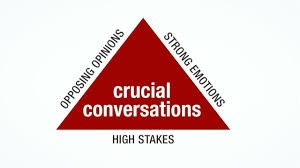
The ability to communicate well when stressed and under pressure is a valued skill, especially in life-and-death situations. It requires a person to remain calm, pay attention to the clarity and conciseness of their messaging, and to emphasise what really matters.
1. Staying Composed
Maintaining one’s composure under pressure requires emotion regulation and the expression of a calm demeanour. These competencies are fundamental to what we often perceive as “grace under pressure.” Grace under pressure is not simply about maintaining a veneer of calm, however; it is also about thinking clearly and making the best possible decisions in the moment.
When immediate decisions are needed in a crisis meeting, a leader who stays calm and collected can guide the team more effectively than one who is panicking. For example, when a major project runs into an unforeseen snag, it is a composed leader who can take stock of the situation, divvy up the work, and effectively communicate the plan of action that will get the team moving again.
2. Being Clear and Concise
In high-pressure situations, clear and concise communication is vital to guarantee that the message being conveyed is understood without any ambiguity. This entails using direct and uncomplicated language while steering clear of unnecessary particulars.
During an emergency briefing, a manager might say, “Our number one priority is to ensure everyone’s safety. Please follow the evacuation plan and proceed to the designated safe areas,” rather than giving a long explanation of what is happening. This kind of direct, simple speech ensures that the most important points are made right away so that people know what to do and can act quickly in an emergency.
3. Prioritising Key Points
Putting the key points first guarantees that the most critical information comes through right away, and this reduces the chance of important details being missed or miscommunicated.
In a high-stakes negotiation, a negotiator might prioritise ensuring that both parties comprehend and concur on the vital terms of the agreement before they proceed to talk about any less crucial details. They might push for agreement on the main points of the negotiation to determine whether they are in the ballpark of reaching a successful resolution.
4. Practising Stress Management Techniques
Practising stress management methods can maintain effectiveness in high-pressure situations. Maintaining strain on the body and mind for short amounts of time can be beneficial—like when meeting a work deadline or preparing for a big test. But overextended periods of stress can lead to burnout, decrease your concentration, and work quality, and affect your mental and physical health.
Rephrased: A speaker might take a few deep breaths and visualise a successful outcome before a tough presentation. This can help calm the nerves and bolster performance. Another helpful strategy is taking a brief pause before answering tough questions. This calm-down technique gives the brain a moment to think through the response.
Practical Application: Examples of Dealing with Difficult Communication Situations
Example 1: Resolving a Team Conflict
In a development team, a conflict occurs between the developers over which programming language to use for a new project. One group favours a language that has been around a long time and is well-established, while the other group would rather use a newer, more innovative language. The project manager steps in and calls a meeting so that both groups can speak their piece and present their arguments. The manager uses active listening to hear the arguments from both sides. After summarising both sides’ viewpoints, the manager rephrases those viewpoints in such a way that makes it clear to all team members which common goals emerged from the group presentations. After some back and forth, during which both sides’ arguments get rehashed and discussed in more detail, a decision is made that satisfies both groups.
Example 2: Handling a Misunderstanding with a Client
Misunderstandings can arise when ambiguous terms are used in a contract. For example, a client might think they are owed additional services when they have only contracted for the service package and not the services in question. Such is the case with a sales representative at my company who had a meeting recently with a client. When the sales rep was telling me about the situation, I could not help but think of the value of clarity in communication and the even greater value of salespeople maintaining respectful, solution-oriented relationships with clients. Here is how I see the meeting going, based on my understanding of the situation. The meeting begins. The client is upset. The sales representative listens, maintaining the calm, respectful demeanour that I expect. The sales representative is clear when she explains the contract. She is clear when she tells the client about the package of services for which the client did contract.
Example 3: Conducting a High-Stakes Performance Review
A performance review for an underperforming employee must be done with great care and sensitivity. Yet, it also must be done with directness and clarity. The conversation is a high-stakes one for both parties, so preparation is key. The manager does not simply wade into the discussion and hope for the best. They gather beforehand specific examples of the employee’s performance issues and a list of potential solutions. During the review, the manager uses clear and concise language, sticking to the key points that have the most direct bearing on the employee’s work. They are not conversational in tone but rather directive. When giving feedback, they are tactful but firm. “I’ve noticed that your recent work has not met our usual standards,” one might say, for instance.
Example 4: Navigating a High-Pressure Crisis Communication
A serious safety incident in a manufacturing plant requires immediate communication to all employees. The plant manager gathers the team and stays composed while delivering the message. Using clear and concise language, the manager prioritises the key points. “We have a safety incident in the production area. Please follow the emergency protocol and evacuate to the designated safe zones immediately. Ensure you assist any colleagues who need help.” This scene illustrates the critical role clear, effective communication plays in managing a crisis. There is something to be said for very direct language when announcing to a team that you have made a safety incident real. Safety is the top priority in any manufacturing setting. A few clear, calm sentences can set in motion the next safe incident response.
Conclusion
Dealing with challenging communication scenarios requires recognition and understanding of the kinds of misunderstandings, conflicts, and high-stakes conversations that can and do occur. This allows better preparation and response. When conflict does arise, there are several techniques that can be used to manage and diffuse it. They include the art of active listening, using a calm and respectful tone (even when one feels anything but calm), and seeking common ground—clear signals to the other person that one is not about to “go off” on them—that can really take the heat out of a situation. Conversely, there are also times when one must directly address another person, and the issue at hand, in a way that is not confrontational but is also not backing down—an address that may call for a near-heroic effort at managing the mixture of calm and firm. Conversely, there are also times when one must directly address another person, and the issue at hand, in a way that is not confrontational but is also not backing down—an address that may call for a near-heroic effort at managing the mixture of calm and firm.

Case Study: Dealing with Difficult Conversations in an Architectural Firm
Background
At the prominent architectural firm ArchDesign Solutions, tensions arose between the design team and the project management team. The project managers felt the designers were missing deadlines consistently, while the designers felt that the project managers set timelines that were unrealistic and did not consider the creative process.
Implementation of Difficult Conversation Strategies
The ongoing conflict was addressed by the senior architect, Maria, who decided to use principles from Crucial Conversations. She called a meeting with representatives from both teams. Maria started the conversation in a way that ensured a safe environment, where blame would not be assigned. She began with respect, acknowledging the dedication and hard work of both teams. Then she got into the goods: Everyone openly expressed concerns that had been simmering for too long. To ensure clarity for all involved, and to help each side understand the other’s perspective, Maria listened a lot better than most bosses do. And when she did not understand, she asked questions that got to the bottom of the issue. She then moved on to the work they all had to do together.
Outcome
An understanding emerged — and it was a big win for both parties. They both left the meeting feeling satisfied and ready to work.
“After having this difficult conversation,” Anna said, “we reached a much-improved agreement for not only the project timelines but also for our two teams to collaborate better going forward.”
Practical Exercises to Enhance Communication Skills
Course Manual 10: Persuasive Communication Skills
Influence: The Psychology of Persuasion is Robert B. Cialdini’s comprehensive guide to the art of persuasion. Cialdini starts with the basics, breaking down the fundamentals of persuasion into six principles: (1) Reciprocity. People want to do nice things for you when you’re nice first. When you give first, you trigger a powerful impulse to give back. You are much more likely to get what you want in life if you start with this principle. (2) Commitment and Consistency. This principle is all about you getting people to make a small commitment first. They do not like to be inconsistent. They like to avoid that cognitive dissonance. They like to look, and they prefer to act, as though they are the same person they were yesterday. (3) Social Proof. People do not know what to do all the time. And when they do not know what to do, they look around and see what everyone else is doing. (4) Authority. People do not question experts. And when you are using this principle, you are wanting to get them to question why they do not question you. (5) Liking. You are probably aware that you are more likely to do something if you are doing it for someone you like. (6) Scarcity. This principle is like hot sauce—you’re supposed to use it sparingly. Because when you do, you increase its value.
The ability to communicate persuasively is vital to having an influence over and motivating other people. It is one of the core aspects of leadership. What communication really is, of course, is a transference of meaning from one entity to another. Persuasive transference of meaning (communication) occurs when a person tries to make another person (or group) think (or do) something that the first person already thinks is (or would be) a good idea. The most obvious “tools” one uses to accomplish this task are words. But body language, tone of voice, and other factors also play a large part in how persuasive one is when communicating.
Crafting Compelling Messages
The foundation of persuasive communication is a compelling message. A well-structured message that highlights benefits and appeals to an audience’s values and needs is more likely to yield a persuasive outcome.
1. Clarity and Conciseness
Effective communication requires that my wife and I lay out what we want in a way that is easy to grasp—and makes us easy to remember. When we ask one of our daughters for help, we want the daughter’s understanding of our request to be immediate. We are not going for depth; we are going for clarity. One way to get there is, of course, to keep it short. But another, often underappreciated, way is to keep it simple.
2. Well-Structured Information
Your audience can follow your argument easily when you have structured your message well. This structure typically includes an introduction, a few key points, and a conclusion. For example, in a business proposal, you might start with a concise overview of the current situation, move into a detailed explanation of your proposed solution, and then wrap up with a summary of the expected benefits and a clear call to action.
3. Highlighting Benefits
Stressing the positive aspects of your proposal is a way to push the proposal toward acceptance. It is a way to achieve persuasion without being pushy. When you lay out the benefits of your proposal, that gives the audience something to grasp and helps them get a handle on what you are proposing. It also gives them a good reason to accept what you are proposing.
Using Persuasive Language and Techniques
The impact of your message can be significantly amplified by persuasive language and techniques. Among these are storytelling, the use of rhetorical questions, and the making of emotional appeals.
1. Storytelling
The persuasive power of storytelling lies in its ability to make your message more engaging and relatable to listeners. When you tell a compelling story, you naturally become more animated, and your audience becomes naturally more focused on you. Imagine yourself standing at the front of a room and delivering a narrative about one of your colleagues. When you close the story with something like “20% increase in her department’s productivity,” won’t everyone in your room just hang on your every word? For example, a poor story tends to make what you are advocating for appear irrelevant or even off-the-wall. When you tell a good story, however, any doubts about your message become momentarily suspended as the audience focus solely on what you’re saying.
2. Rhetorical Questions
Rhetorical questions provoke thought and engage the audience, often without requiring a direct answer. They can help to mark key points and make your audience ponder your perspective. For example, when discussing the merits of a fresh initiative, you might ask, “Can we stand idly by and not embrace the windfall that this project could well generate for us?” The audience is obviously nudged toward an affirmative mindset. Example: “Isn’t it about time we poured some of our vast resources into high-tech, high-payoff projects?”
3. Emotional Appeals
It is particularly persuasive when an emotional appeal taps into the audience’s feelings. Making a message connect on an emotional level really boosts its impact. For instance, when a charitable cause is being championed, you might hear someone tell a very personal story about a transformative experience with the charity. The heart just knows the right kind of tune to play, the chord to strike, to make it resonate. Example: “The musical little boys do not play, for their hands are bound in fetters for playing the kora; the musical little boys do not sing, for their mouths are muzzled in singing cases; and the musical little boys do not make much of a noise, for their noise-making calabashes and their long trumpets have been commandeered by the one who puts or performs in an R & B show.”
Tailoring Messages to Different Stakeholders
Effective persuasive communication requires you to direct your messages to the right stakeholders. To do that well, you must understand their concerns, priorities, and viewpoints. And with that understanding comes the ability to adapt your communication and style to suit them and zero in on their specific interests.
1. Understanding Perspectives and Priorities
Different stakeholders hold diverse perspectives and priorities. Understanding these allows you to create messages that hit home with each group. When you are communicating, say, with senior executives, you are talking to a group that wants to know the strategic payoffs and the financial returns of what you are proposing. When you are communicating with frontline employees, on the other hand, you know that you need to focus on what will make their work lives better and more fulfilling.
When advocating a new project management tool, concentrate on two major persuasion factors: cost and ease of use. For the finance team, show what the new tool will save (in dollars) and what it will earn (in return on investment). For the project team, emphasise how simple the new tool is to use and how many hours the team will save (in all likelihood) by using the new tool rather than the present system.
2. Addressing Concerns
It is essential to gain stakeholders’ support and to do this you must anticipate and address their concerns. This is not about guessing what objections might be raised. It is about knowing what to expect and preparing to counter those objections with evidence or arguments showing that your proposal is a good idea. For instance, say stakeholders are worried that a new initiative is going to cost them. You might remind them of the last cost-benefit analysis you did and point out that the new initiative is going to save them money in the long run.
I comprehend that this software’s first influx of cash is considerable; however, my appraisal indicates that it will cover its backside within 12 months through enhanced efficiencies and diminished operational outlays.
3. Adapting Communication Style
Changing your communication style to fit different stakeholders can make you more persuasive. That might mean using formal language with senior executives and a casual conversational tone with colleagues. On the other hand, directing your stakeholders’ preferred communication channels (e.g., emails, meetings, presentations) can also better direct your message.
When addressing the board, use formal language and detailed slides with data. When addressing a team, use a more conversational tone. Be interactive, encouraging questions and discussions.
Illustrative Examples of Persuasive Communication
Example 1: Persuading a Board of Directors
The board of directors needs to be convinced to authorise an increase in the budget for an upcoming advertising campaign. The marketing director must make a compelling argument for why the company needs to spend more money on top of what was already planned.
Method: The director constructs a clear presentation, working from the market’s overview to the company’s growth prospects—claims that are thoroughly backed up, in part, with the current projected ROI and borderline unbelievable stories of past successes. (Some of these stories may even be true. Who can tell?) Anyway, the presentation must happen as described.
“In today’s competitive markets, our brands need to stand out. This is a direct consequence of basic economics: as the demand for a product increases, so does its price. This advertising campaign, part of an ongoing effort to reinvigorate our brand, will increase both our visibility and our sales. Like the last campaign, which earned us a 30 percent increase in market share, this one has the potential to deliver even greater results.”
Example 2: Motivating a Team
For motivating a team to adopt a promising new workflow that is supposed to increase efficiency, a team leader might consider the following strategy:
1. Be reduced to the mundane.
2. Create stark, relevant contrasts.
Method: The leader employs a mix of emotive appeals and rhetorical questions to get the team engaged. They begin by asking everyone to think about the present problems and annoyances with the current way of working. Then, they move on to tell a story about a team member who has switched to the new workflow and is now—thanks to the new system—doing a much better job than when they were using the old system.
Are you worn out from the current workflow’s inefficiencies and bottlenecks? Picture this: a system where tasks flow as they should, where deadlines are met practically (and not just “by the skin of our teeth”), and where we are somehow less stressed. I know a certain someone whose productivity has gone up since she started using Just. This. Workflow. And if it works for her, it could work for us too.
Example 3: Securing Client Buy-In
A consultant must endeavour to sway a client into adopting a suggested approach.
This is a situation when persuasion, rather than simple informing, is required. In almost any consulting situation, you will have to work to get your client to follow your recommendations. To be successful at this requires skill and talent. Here are some techniques that might help.
Method: The consultant adapts their communication to fit the business objectives and priorities of the client. They provide neat and clear information, which really helps and directs those who are listening to figure out exactly what the strategy is, what goals it is intended to achieve, and how the “wins” will manifest. The consultant also takes care to make numbers and data serve as a basis for their claims.
Implementing this strategy will make your operations much simpler and cut costs by a significant amount. Our analysis indicates the new system could save you as much as £100,000 a year. We also know of other clients in your industry that have used this strategy to good effect. They have achieved better (read: more profitable) results with systems that are now easier and cheaper to run. We know you are worried about the investment required to switch systems, but we think you will find the payoff to be substantial and to come quickly.
Advanced Persuasive Communication Techniques
1. Ethos, Pathos, and Logos
Aristotle identified three modes of persuasion: ethos (credibility), pathos (emotion), and logos (logic). These elements can be found in effective persuasive communication. You might also find persuasive communication that combines two or three of these elements to strengthen the argument.
Establishing your credibility and authority on a subject is what ethos is all about. Consider this scene: A medical professional is presenting a new treatment plan. This person is not just a random person up there with what could be perceived as an unqualified opinion. Instead, this person, by virtue of having a medical degree, is someone whose expertise and experience in the field make the audience trust what is being said.
The audience’s emotions are the target of pathos appeals. For example, a charity organisation might employ emotional appeals to boost their donation rates by telling stories of people whose lives have been transformed by the help of that organisation.
o Logical arguments and evidence are the foundation of logos. A business proposal, for instance, works to demonstrate the feasibility and benefits of a new initiative by deploying data, deploying statistics, and by just plain reasoning.
2. Social Proof
Using the influence of others to persuade your audience is what social proof is all about. When you can show that others have successfully taken up your proposal, you are in a strong position to build credibility and encourage your audience to follow suit.
A number of top firms in our field have put this technology to work and seen great gains in efficiency and clarity of customer communications as a result. Should we implement it, our appearance in the annual report to shareholders would still make it look like we are industry leaders, even if the actual leaders were also using the same technology.
3. Reciprocity
The principle of reciprocity indicates that individuals are more inclined to be influenced when they have the sense that something is being provided to them in return. What is given in return, however, is not always as straightforward as giving someone a present. The “present” can take many forms, and the forms it takes can have various effects. Among the more useful forms the “present” can take (for our purposes here) is as useful information.
We are providing complete training sessions and steady support to help the new system find a home. We believe this investment will lead to mutual benefits for our organisations.
4. Scarcity
The scarcity principle states that people give more weight to options they perceive as limited or rare. This should not, of course, be interpreted as an encouragement to exaggerate or misrepresent the actual availability of our proposal. But we can and should highlight its unique characteristics and the fact that this is a temporary opportunity that can and should be acted upon now, not later. Example: “This is a one-time funding opportunity. If we secure it, we will use it to fast-track the development of our product line.”
5. Authority
Individuals are more apt to be persuaded by those they view as knowledgeable or in positions of authority. Enhancing your message with either your own demonstration of expertise or with the citing of credible, expert sources can improve your message’s persuasive nature. For instance: “Research conducted by Harvard Business School indicates that businesses adopting this strategy experience a 20% bump in productivity within the first year. Our implementation team has the kind of deep knowledge and got the kind of experience that really makes a difference when it comes to guidance in this area.”
Tailoring Messages to Different Communication Channels
Various means of communication call for distinct methods to ensure your convincing message reaches its full potential. When using these different forms of communication, it can be beneficial to modify your style and content to better align with the medium. In doing so, you engage the medium on its terms and utilise its best practices to enhance your overall persuasiveness.
1. Emails
Emails must be unambiguous, succinct, and well-organised. Use bullet points or numbered lists to draw attention to the main points and make your message easy to understand at first glance. Personalise the email so that it speaks to the recipient’s immediate concerns and interests. For example, you could write: “Dear [Recipient], I wanted to share an exciting opportunity regarding an adoption of a new tool that could significantly enhance our project outcomes. If we brought this in, we could work in a much more streamlined way and with an apparent efficiency that is improved by 25%. Please see attached proposal for details.”
2. Presentations
Presentations need to be visually attractive and obviously well-organised. They can and should serve as a type of ” A-B-C” to get across the key ideas, points, and visuals that support the verbal message. As a type of public speaking, presentation delivery can be practised to “turn pro” in terms of confidence and polish. Example: Presenting to potential investors is a good time to use slides to hit hard on market potential, projected returns, and advantages of your proposal over the competition. Use visuals and explanations that are clear, concise, and engaging.
3. Meetings
It is crucial to be well-prepared and articulate in meetings. Present your main points with clarity and encourage open discussion. Use active listening to handle questions and concerns effectively. For instance, in a project kick-off meeting, state the project goals, timelines, and team roles with crystal clarity. Make sure your team has a chance to weigh in, and if any issues come up, address them head-on to ensure the team is aligned and bought in.
4. Social Media
Concise and engaging communication is crucial for social media. Capturing attention and provoking interaction takes more than just good writing. Good visuals, well-placed hashtags, and direct calls to action help posts stand out. Every social media platform has its own rules of engagement, and its user base has its own set of expectations. Tailoring your message for “the stage” is just as key as for “the audience.” Example: Post on LinkedIn. Highlight a professional achievement that speaks to your institution’s calibre and success. When you are finished, share it with your followers.
Conclusion
How to Persuade People is All About Being Clear, Concise, and Well-Structured
The foundation of persuasion is a message that is not only compelling but also clear, concise, and well-structured. In our work with Clear and Simple, we have seen time and again that people naturally gravitate toward a message that is, well, clear. They cannot easily move toward or away from a message that is not easily understood. Clarity not only helps persuade an audience; it also, as my friend Simon Sinek puts it, “makes them able to follow.” Following a message with clarity in a leadership or influence context is like maintaining eye contact when you are talking to someone. Junior Persuaders often think they are being clear when, in reality, they are not. One basic technique for crafting a compelling, persuasive message is to ensure that your message is “sentence sized.” Audiences are better able to follow a message if they are not working too hard to understand it, and especially if they can easily follow the syntax of your sentences.

Case Study: Persuasive Communication Techniques in an Engineering Consultancy Firm
Background
At Apex Engineering Consultancy, a team undertook the responsibility of presenting to a significant customer a proposal that concerned a sustainable infrastructure project. The customer expressed doubts at the outset about the green technologies that were part of the proposal. The expressed doubts focused mainly on the proposed technologies as being feasible and cost-effective.
Implementation of Persuasive Communication Techniques
Lead engineer Emma chose to apply persuasive communication techniques derived from Robert B. Cialdini’s principles. She focused on these strategies:
1. Authority: Emma directed attention to her team’s expertise in sustainable projects and near-rival experience, flaunting enough successful case studies and certifications to establish a level of credibility necessary for this conversation.
2. Social Proof: She mentioned some testimonials and endorsements from similar past projects to give the client some sense of broad acceptance and number of stakeholders involved.
3. Reciprocity: Emma and her team offered a free, detailed feasibility study as a way of building some goodwill and showing that they had enough commitment to the project to provide some of the more valuable (and usually paid-for) information one expects to find in a feasibility study.
4. Liking: Emma and her team got to know the client, finding some common ground that allowed them to build a rapport more genuine than what one finds in most business conversations.
5. Scarcity: Emma had the foresight to work in the limited timeframe of government grants for sustainable projects.
Outcome
The well-rounded, persuasive presentation caused the client to approve the proposal. Winning the contract was one thing; establishing a trusting relationship with the client was another. But it is possible to do both using Cialdini’s principles of persuasion. This case study uses a two-in-one focus: not only does it look at the techniques used to win project approval, but it also examines the communication method used to create a strong, trusting bond with the client, a bond that should last until the project is finished and perhaps long after that.

Practical Exercises to Enhance Persuasive Communication Skills
Course Manual 11: Presentation Skills
The author of Presentation Zen: Simple Ideas on Presentation Design and Delivery, Garr Reynolds, offers a fresh perspective on delivering impactful presentations. He emphasises simplicity, clarity, and engaging visuals as the cornerstones of good presentations. His “Zen” approach focuses on reducing clutter and emphasises the core message. Reynolds highlights the importance of storytelling and encourages presenters to craft a narrative that connects with the audience. This makes the content more memorable. Regarding visuals, Reynolds prefers high-quality images in lieu of words. He wants the audience to “get” the image and connect it to the core message of the presentation. Another key aspect of Reynolds’ approach that is also recommended by many presentation coaches is that the presenter should rehearse extensively. Maintain eye contact, natural gestures, and a tone/pace that matches the audience’s engagement level. In sum, present with confidence and enthusiasm. Also, remember to focus on the audience and tailor the presentation to your specific listeners.
It is of the utmost importance to have effective presentation skills if you want to convey an idea clearly and persuasively. A presentation could be your best chance to impress a number of important people in your life, so you should do everything within reason (and a few things that might be a little outside of reason) to make it a good one. You should win a few battles in the war of impressions. Also, I should say that the practices I describe here as effective presentation skills can also be used in a variety of contexts wherein you must convey something to a large group of people and make it stick.
Structuring and Delivering Impactful Presentations
Effective communication begins with a presentation that has a clear structure. When I say, “clear structure,” this is what I mean: Your audience should be able to easily follow the line of argument or the story you are telling. And when they get to the end, they should be able to summarise the key points that you have made.
1. Organising Content Logically
Content organisation in a logical manner is simply structuring what you are saying in a presentation so that it flows naturally from one point to the next. A clear structure nearly always consists of three parts—an introduction, body, and conclusion.
Introduction: The introduction should set the stage for your presentation. It should grab the audience’s attention, introduce the topic, and outline what you will cover. For example, starting with a compelling statistic or a relevant anecdote can engage the audience right from the beginning. Example: “Did you know that 60% of businesses fail within the first three years? Today, I will share with you the key strategies that can help avoid this fate and ensure long-term success.”
Main points: The main points of the presentation must be arranged in a logical order. Each point ought to be backed with some form of substantiation, like evidence, data, or a well-chosen quote. Moreover, using subheadings to signal transitions between main points helps keep the audience oriented with the content. Consider the following example: If the topic is “effective marketing strategies,” the presentation’s body may very well be divided into sections (indicated by subheadings) that consist of different main points: “digital marketing,” “content marketing,” and “social media marketing.” Each section can then proceed with relevant examples and case studies.
Conclusion: The conclusion should summarise the key points of your presentation and leave the audience with a clear understanding of what comes next or what to take away from the presentation. A well-crafted close can reinforce your message and, more importantly, give the impression of a good ending. Example: “Content and, leveraging digital marketing, creating compelling content, and strategically engaging with our audience on social media all have the potential to elevate our brand visibility in significant ways and drive our business to new heights. Let’s discuss how we can make these approaches our own in the next couple of weeks.”
2. Using Visual Aids Effectively
Your presentation can be enhanced by visual aids that provide visual support for your points, make complicated information easier to grasp, and maintain audience attention.
Presentation Slides: The most effective presentation slides are clear, concise, and visually attractive. They use bullet points to emphasise key points and employ images, graphs, and charts to illustrate data. They do not clutter the slide with excessive text; rather, they use the slide to complement the speaker’s words. For example, in a financial presentation, the speaker might use a slide with a graph showing quarterly revenue growth while stating that revenue has, in fact, seen substantial growth.
Here is a way to rephrase the text while maintaining the structure and formatting of the source material, including elements like lists:
Props: Physical props can introduce a tactile aspect to your presentation that makes it easier for the audience to remember when and why they should be interested in it. For instance, if your presentation centres on a new product, then presenting a prototype could add to the audience’s comprehension and curiosity to a level beyond what their imaginations could achieve.
Video clips: Brief video clips can add variety to your presentation and interrupt your speaking just enough to keep your audience’s attention. As with all items on this list, videos should be relevant and help you make (or reinforce) your point. For instance, a video of a customer giving a testimonial can be a powerful way to illustrate what your company does and the kind of impact it has.
3. Practising Confident Delivery
The successful presentation is one where the presenter is confident. Practising the act of presenting can help one to be clear in one’s speech, manage the timing of the delivery, and project a calm confidence that people tend to admire.
Practising your presentation multiple times, both solo and in front of an audience, can be an effective way to rehearse. This method allows for great familiarity with content and easy identification of weak areas that need working on. Practising in front of others also yields wonderful feedback and makes for great opportunities to work through presentation nerves.
Posture and Poise: A confident posture conveys not only confidence but also enthusiasm. Standing tall allows the natural flow of your energy to fill the space in which you are presenting. Eye contact is essential, and MAKING EYE CONTACT WITH YOUR AUDIENCE SHOULD NOT BE UNDERESTIMATED, as it is one of the simplest ways to express confidence and engage your audience simultaneously. A good presence is vital; the stage should be to you as your room is to the audience. Example: Walk around the stage or room and engage us; we are your audience. We are supposed to be enraptured because YOU are in presence—a powerful presence.
Really Pay Attention to Your Audience
Some speakers get so caught up in their own performance that they forget to pay attention to the audience. Are they smiling? Frowning? Nodding? Looking confused? These are your clues about how your audience is receiving the message. If you are not getting the reception you want, it is time to change things up.
1. Storytelling
Engaging your audience and making your message hit home takes more than just delivering facts and figures. The storytelling and even the story you must tell can be your most potent tools. A well-told story does what no number of bullet points can do. It makes your audience see, hear, and feel what you want them to see, hear, and feel. For example: “When I first started my business, I faced numerous challenges. There was a time when I thought we would not make it. But by implementing the strategies I am about to share with you, we not only survived but thrived. Let me take you through our journey.”
2. Interactive Elements
Including interactive elements in your presentation can make it more engaging and can encourage participation from the audience.
Involving the audience and stimulating their thinking can be done in many ways. One way is to ask questions. For instance, “How many of you have faced similar challenges in your business?” can provoke the audience to reflect on their own experiences and enables them to connect with your message on a deeper level.
Surveys: Surveys are a valuable tool for gathering audience input and making the audience feel truly involved. Tools like Mentimeter or Slido that allow you to do audience surveys during a presentation can make your presentation feel much more like a conversation and less like a one-way street. These tools allow you to receive instant input from your audience, which is why they can serve as excellent “barometers” for testing the audience’s engagement level during your presentation.
Actions: Brief actions or demonstrations can punctuate the presentation and make it more engaging. For instance, in a presentation about teamwork, you might have the audience do a short, well-rehearsed exercise that demonstrates a key lesson about teamwork.
3. Varying Vocal Tone and Pace
Vocal variety is maintained by differing tone and pace, which can help keep audience attention and underscore important parts.
Stressing: Stress important ideas by changing your tone or volume. For instance, say the next part of your speech more loudly or more slowly. When you want to emphasise something, you might say it with more gusto or in a more animated way. You can get a point across and still sound very composed and professional.
Pacing: Slowing down and speaking clearly can reinforce important points and make the audience tune in to what you are saying. Good speech delivery is about more than just saying the right words; it is also about emphasising the right words. Example: “We achieved… a 50% increase… in sales… in just six months.”
Connecting with the Audience
To deliver a convincing presentation, you must connect with your audience. The first step is to make eye contact with as many individuals as possible. Then, using body language that says, “I am excited and confident about what I am saying,” and addressing the audience’s needs and interests can create a connection that leads to a compelling presentation.
1. Eye Contact
Establishing eye contact with your audience may help create a feeling of connection and engagement between you and them. It can signal not just confidence but also that you value the audience enough to interact with them. Example: When you present to some number of people up to about twenty, make eye contact with each person—more or less at random, around the circle and back to in front of you—to create a sense of intimate connection.
2. Body Language
Enthusiasm and confidence come across even without spoken words. . .. You can also say a lot with your body during a presentation. Your . . . gestures . . . are important, but they are not the only thing you need to do or not do with your body. In fact, with poor postures and gestures, even the best-spoken message will not get across very well. Conversely, handling your body in a confident way—open, natural, yet controlled—can enhance the appearance of your message and make the spoken part of it much more memorable.
3. Addressing Audience Needs and Interests
To make your relevance and engagement more potent, direct your presentation to the audience’s needs and interests. This means doing basic research on your audience beforehand and adapting your content to a context they share with one another. For instance, if you are presenting to a group of educators, let most of your examples focus on applying your content in educational settings. “Most” because your group of educators is not a homogenous entity; focus on what is common or shared among them and ensure your presentation does not veer too far into niche territory.
Handling Questions and Feedback
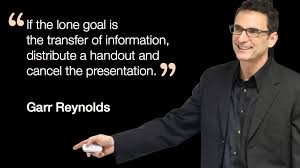
Delivering a successful presentation means handling questions and feedback well. This entails active listening, thoughtful responding, and a preparedness for a range of audience queries.
1. Active Listening
To fully attend and listen to your audience, concentrate on the question being asked, comprehend the speaker’s intent, and respond in a manner that indicates you are on the same wavelength and understand their line of thinking. This is a foundational skill that shows you are engaged with your audience and value their input. For example: When a participant poses a question, listen intently and do not interrupt. Once they have finished, you might say, “That is an excellent question. What you are really going after is how we can implement this whole sustainable thing but with far fewer resources at our disposal, yes?”
2. Responding Thoughtfully
Answering questions with care and thought is an excellent way to demonstrate your expertise and reinforce your message. When you provide clear, concise answers that relate back to the key points of your presentation, you show your audience that you are in command of the situation and the material. Example: If asked something like, “Is this strategy cost-effective?” you might answer, “This strategy does require an initial investment. However, our analysis shows that it will pay off very handsomely—indeed, far more than any other scenario we looked at—within a year, and probably within six months, because of the increased efficiency and reduced costs that we are already starting to see.”
3. Being Prepared for a Range of Queries
Handling the Q&A session confidently can be achieved by being well-prepared for the kinds of questions that might be asked. You can anticipate what people might ask and prepare answers in advance. For instance, before a presentation on a new product, think about what questions might come up regarding its features, pricing, market comparison, and possible challenges. Then, prepare to answer in a way that covers all the bases.
Examples of Effective Presentation Techniques
Example 1: Presentation of Business Proposals
A campaign proposal needs to be presented to senior management by a marketing director.
Method: The director begins with a powerful introduction that lays out the present state of the market—condition so dire it would make even a hardened pessimist wince—and an accompanying absolutely necessary new solution. This is not a paint-by-numbers PowerPoint; it combines the rudimentary elements of a clear “this is what we’re doing, this is why it’s working, and this is how it’s going to happen” structure representative of campaign proposals with dynamic visuals that includes a graph or two of actual market trends and a minute-long video of potential campaign ideas in action. Throughout, the director inhabits the presentation, inserting verbal emphasis where needed and building a kind of urgency that makes one question why such a compelling solution has not already been implemented.
Result: The director arranges the content logically. He uses visual aids effectively. He delivers the presentation with confidence. These three elements—the presentation’s structure, the presentation’s visual components, and the presenter himself—combine to make a successful persuasive pitch to senior management. The campaign is approved.
Example 2: Training Workshop
A leader of a team must guide a training session on a recently introduced software instrument.
Method: The leader tells a story to depict how the software can be beneficial, talking about a colleague whose productivity shot up after they started using the tool. The leader performs to retain audience attention, even incorporating a few live demonstrations of the software in action and makes the proceedings more interactive by throwing in a few questions to the audience and taking some questions back from them. Adding eye contact, open hand gestures, and a little room to roam during the performance securely connects the leader to the audience.
Results: The group attendees walk away from the meeting with a lucid comprehension of the software. They feel enthused about the prospect of implementing it, and this is attributable to the leader’s captivating, interactive, and even directive presentation style.
Example 3: Conference Presentation
A researcher must present their findings at an academic conference.
Method: The presentation is structured with an unambiguous introduction, body, and conclusion. The researcher makes clear their overall objective and the rationale behind it. They progressively build up the presentation’s argument to the effect that much current storage capacity assessments for major aquifers are inaccurate. To support this assertion, they employ logical reasoning, a good amount of relevant data, and a series of lab and field experiments performed at several scales.
Result: The audience comprehends the research findings and what they mean, and the presentation is lauded for being clear and engaging.
Conclusions
Skills that are effective in the presentation are vital to the clear and persuasive idea expression. The way one prepares and delivers a top-notch, “all-there” presentation is not so much a matter of being born with the talent to do so as it is a case of doing the right things in the right way. An impactful presentation is logically structured, looks good, and sounds good. (You’d be surprised at how far “good” will carry you.) You can tell a presentation is good when you can follow it and understand it. I am willing to bet you cannot tell a presentation is good if you cannot follow it and understand it.

Case Study: Effective Presentation Techniques at an Accountancy Firm
A mid-sized accountancy firm, Smith & Co Accountants, was readying itself to go after a large corporate client. The firm’s past presentations were too laden with details and had not connected in a way that made the firm seem like a front-runner for the client’s business. Putting together this bid required the firm to pull together a competent pitch that would be taken seriously and, ideally, carry the day. To that end, they had to rework their presentation style.
Carrying Out Effective Presentation Techniques
Jane restructured the presentation to follow a clear, logical flow—a direction that is, unfortunately, all too often neglected. The payoff from this investment is a more engaging experience that not only attracts the audience’s attention but also serves to hold it. This is precisely what any good presenter should aim for and is something toward which Jane has a tendency. It is, however, a combination of both her comprehensive mastery of the material itself (more on this below) and her visualisation of the piece that can justly qualify and afford her the presentation of a good experience as a presenter. To begin with, the introduction and real path to go after the forthcoming audience was both clear and concise. Jane located the central thesis of the presentation deadpan in the centre of the slide she was using and then punctuated with a compelling call to action.
Outcomes
The reworked presentation was a triumph. The would-be client was taken with the clear, punchy, and well-organised presentation. Jane’s deft use of visuals, along with the storytelling and confident delivery that are part and parcel of the presentation heretofore referred to as “the best of all time,” not only sealed the deal with this new client but also served as a model (for presentation techniques, if not for cutoff shirts, and in the context of an accountancy firm, not in the context of an office party) that the employees of Smith & Co. can look up to and emulate.

Practical Exercises to Enhance Presentation Skills
Course Manual 12: Communication in Virtual Environments
Remote work is a prevalent mode of work for many today, yet the world of remote work is a new one. Many employees have not been in it long or have only just transitioned to it. Consequently, these employees have not had the chance to (re)build the practices and the ethos—that is, the set of underlying attitudes, values, and beliefs—that together constitute the pretty seamless world of in-person communication many of us enjoy. But what I want to get at here is that the world of in-person communication is one in which in-person communicators are privileged. In my experience, the absence of the speaker has long been a mostly regrettable situation for listeners who would rather have the speaker present and speaking in person than not. Conversely, the presence of the speaker has a better than even chance of being advantageous to those who are simply trying to understand the spoken word. Indeed, I would go as far as to say that the ideal world of in-person communication is one in which in-person communicators possess certain advantages and in which the virtual communicator is really an undesirable narrative ending.
Best Practices for Virtual Meetings and Communication
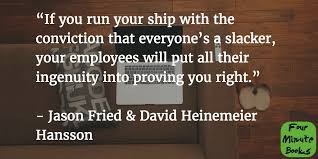
A structured approach to virtual meetings and communication is necessary to ensure clarity and productivity. Enforcing best practices in virtual settings can significantly improve the quality of interactions.
1. Setting Clear Agendas
It is particularly important to set a clear agenda if you want to keep a virtual meeting productive. An agenda outlines what topics will be discussed, what the meeting’s objectives are, and what kind of outcomes people should expect by the end. This kind of preparation helps not just the meeting leader but also the participants, who will come to the meeting anticipating and ready to make a meaningful contribution. For instance, if a project manager is going to hold a virtual team meeting, they might send an agenda ahead of time that states: “This week’s meeting will cover the following topics: 1. Updates on ongoing projects. 2. Any roadblocks we need to address. 3. Planning for the upcoming week.”
2. Ensuring Reliable Technology
Successful virtual communication has technology as its backbone. It is one thing for the host conference to exist in a virtual environment; it is another for all participants to appear as if they are in that environment and to be fully functional within it. Ensuring that all who are about to enter the meeting have stable internet connections and that all microphones and cameras are working well is essential. One for the tech check example: Global sales conference, pre-meeting tech checks. Regular testing of equipment and internet connections; troubleshooting any problems beforehand makes this meeting run more smoothly.
3. Fostering Active Participation
It is especially important to ensure that all participants in a virtual meeting are engaged and collaborating. This can be ensured by making sure all meeting participants are invited to give input, by using engaging features of virtual meeting platforms, and by creating an environment that feels inclusive of all virtual meeting participants. Example: A virtual meeting is held in which the main agenda is to collaboratively solve a problem. The meeting facilitator breaks the main group into smaller groups, putting some in breakout rooms and some in the main room. After a set time, the facilitator brings the main group back together and asks the group in the main room to report first on the ideas they have generated.
Overcoming Challenges of Remote Communication
Communicating from a distance poses various problems, like when the people conversing are on different sides of a world split by the International Date Line. And then there are the never-ending potential for misunderstandings and the actual misunderstandings that crop up even when everyone is trying their best to be clear and direct.
Promoting clear and concise communication is one way to handle these several problems. Another is to encourage everyone to use check-in times as opportunities to make sure that everything is all right on both ends of the line.
1. Addressing Time Zone Differences
Meeting across time zones can be tough. When people are spread across the globe, it is hard to find a time that works for everyone. And when you add to that time zone disadvantage all the tonight and tomorrow cultural and regional differences, plus plain old variation in work styles and paces, you have a recipe for serious meeting malcontent.
A worldwide corporation holds its weekly global team meeting at a time that suits all participants, even if some of them must come to the meeting at what for them is an inconvenient hour. The company makes sure that if it is inconvenient for some team members to meet at that time, it is equally inconvenient for others. The corporation is very much an equal opportunity offender when it comes to setting meeting times.
2. Promoting Clear and Concise Communication
Writing that is clear and direct reduces the chances of misunderstandings and guarantees that everyone is in agreement. Achieving this necessary clarity involves using specific language, avoiding jargon, and, when appropriate, summarising key points to ensure that all parties have a shared understanding of the issue at hand.
Here is a virtual project update with the team leader summarising each discussion point at the end of the meeting. This is then followed up with a written summary distributed via email. All of this serves to give team members a clear record of the discussion and agreed-upon actions and to reduce the risk of any miscommunication that could occur if just a few members of the team were to relay the essence of the meeting to the rest of the team.
3. Regular Check-Ins
In a remote work environment, it is essential to keep up connections and watch over progress. Check-ins can be daily stand-up meetings that the whole team must attend. You might also be in a group that runs a weekly progress report. Or, if you are lucky, you might be in a situation where you can check in one-on-one with your team members to see how they are doing and how you are doing as a group.
A team of software developers conducts a daily stand-up meeting. Each team member presence is required. Each team member talks in turn. Each team member has a story to tell. Each story lasts about 1 minute. In each story, the team member covers three key points: 1. Progress report—what’s been done since the last meeting; 2. Obstacle report—what’s getting in the way of the team member’s movement toward meeting the project deadline; 3. Plan for the day—what the team member intends to accomplish during the next 24 hours.
Using Digital Tools to Enhance Virtual Interactions
Effectively communicating and collaborating in virtual spaces is made possible with the help of various digital tools. Video conferencing platforms, collaborative software, and instant messaging apps can take virtual interactions to the next level. When these are used in combination, they can serve as powerful virtual presence tools that allow teams to work as if they were together in one physical space.
1. Video Conferencing Platforms
The platforms for video conferencing, like Zoom, Microsoft Teams, and Google Meet, allow for direct, even though virtual, interaction. They are set up for features that can make a meeting better than being there in person and more effective than many past forms of remote communication. These features include (but are not limited to) sharing the screen, having a “virtual background,” and using “breakout rooms.”
During a training session that is virtual, the trainer uses Zoom’s breakout room feature to divide the participants into smaller groups for discussion. To present slides and videos, the trainer uses the screen share function. To create a professional and distraction-free environment, all participants have virtual backgrounds.
2. Collaborative Software
Teamwork is made easier and more efficient with the use of collaborative software such as Slack, Trello, and Asana. These programs allow for near-real-time collaboration and enable project management at a level of detail suitable for most teams. They also serve as task tracking and assignment tools in a systematised and orderly workspace.
A content calendar is managed by a marketing team that uses Trello. Each campaign is represented by a card that includes task lists, deadlines, and assigned team members. On these cards, team members can comment, upload files, and move the cards through different stages of completion. This ensures that everyone is aligned and informed about the marketing team’s activities.
3. Instant Messaging Apps
Direct messaging applications, like Slack and Microsoft Teams, afford an expeditious and user-friendly medium of communication with office mates. These applications accommodate for not only group chats, but also for talking with your app-specific “office” in private. They also allow for sending files that you might need your “office” to look at and for integrated features that make day-to-day tasks more manageable.
In a product development project, Slack is used for different aspects of the project, such as design, development, and testing. This helps team members be more efficient and effective. Finding relevant information no longer requires long email threads or meetings that chew up too much time and are hard to schedule.
Enhancing Team Cohesion in Virtual Environments
It can be tough to keep a virtual team cohesive when team members do not have physical interaction. But with the right moves, you can keep your remote team friendly, collaborative, and community oriented.
1. Building a Virtual Team Culture
Establishing a virtual team culture means fostering a shared identity among team members. In a world where some of us are physically distanced from even our loved ones, we must strive to be intentionally together if we are to achieve any type of virtual or hybrid culture. That togetherness can take many forms—for some of us, a “virtual” social hour may suffuse with the powdered scent of a good beer inside a cozy home. This is just one of the ways to build an intoxicating team culture; there are many more.
2. Encouraging Informal Communication
Team engagement is a significant part of team cohesion. By fostering casual interactions among members of virtual teams, informal communication allows a true sense of connection and support. This is especially important as more and more people work in different parts of the world and in different time zones. Distant team members, however, can still have a virtual version of a “water cooler.” The space allows for spontaneous, unplanned interactions that help build not just virtual, but also real-life rapport among team members.
3. Recognising and Celebrating Achievements
Understanding and commemorating accomplishments can invigorate and structure a virtual team’s positivity. Remotely recognising individual and team achievements goes a long way to light up a “virtual room”/”virtual space” with good team culture and positive vibes. Example: My friends at an online marketing agency use their weekly team meeting just for this purpose. They laud loud and long (virtually, of course) those who have excelled, in hopes of lightening up the week for everyone. They also share the kind words in a company-wide newsletter because what is an achievement if your “whole wide world” does not know about it?
Overcoming Technological Challenges
Virtual environments inevitably face technological challenges, yet we can take proactive and even preventive steps to ensure that such disruptions do not unduly affect communication.
1. Providing Technical Support
Helping team members allows us to get to know them better and understand their work and role on the team. It also presents opportunities to model desired behaviours, such as when we assist on matters of substance during team calls and when we offer troubleshooting support on virtual and other tools. Example: The virtual world in which we work requires digital tools for effective communication and collaboration, and for many of us, those virtual tools are new. Our Digital Equaliser team teaches a workshop for workplace Digital Natives to train them on the virtual toolkit.
2. Ensuring Data Security
Virtual environments pose a significant threat to data security. The threat can be counteracted, however, by implementing strong security measures. These include encryption (which may be achieved using several methods), secure access protocols (which can involve a variety of options), and regular security audits (which should be part of any trustworthy operation). Example: For a financial services firm, encrypting communication channels (probably the best method for this kind of operation) ensures that all “talk” and “document sharing” done in a virtual space is safe from eavesdropping.
3. Managing Digital Fatigue
The source of digital fatigue is clear: spending too much time in front of a screen and being too connected in a virtual world. Most of us are not just working on our computers for eight hours a day but also being glued to our devices for two or more hours of virtual socializing. Whether it is work-related or personal, being in a constant state of virtual engagement cannot be good for our brains—or our productivity. Managing it effectively can make all the difference. One group that did a good job managing virtual fatigue was a remote software development team. They took this problem seriously and implemented a “no meeting Friday” policy.

Case Study: Successful Virtual Communication in a Global Company
Let us look at a case study of a worldwide corporation, Tech Innovators Ltd., which made a successful transition to a completely remote work model. This serves as an effective illustration of the strategies we have discussed being put to good use.
Background:
Tech Innovators Ltd. is a global technology firm with a workforce that spans many continents. The company found it difficult to keep lines of communication between team members open and to maintain a sense of camaraderie among employees when they all began working from home, in remote mode, because of the pandemic that originated in 2020.
Implementation:
• Establishing Directives for Meeting Purposes: The business adopted a policy that all virtual gatherings must have a distinct purpose. In consequence, if one were to attend a virtual meeting held by this entity, one would know that the meeting had a clear agenda that was sent out at least 24 hours in advance.
• Ensuring Reliable Technology: Tech Innovators invested in top-tier video conferencing software and provided all employees with the needed tech, including laptops, webcams, and headsets. They also made it a point to regularly check their technology.
• Facilitating Active Participation: Engaging employees in virtual meetings can be a challenge. To counteract this, the company employed interactive features like polls, breakout rooms, and collaborative whiteboards during meetings. They also had employees lead sections of meetings and share their insights to create a more well-rounded perspective during discussions.
• Dealing with Time Zone Disparities: The firm planned key gatherings for moments that were fairly convenient for all the time zones and filmed these gatherings for the folks that could not make the live performance. They also set up a rotating schedule of meeting times to ensure that everyone had a chance to be part of the event.
• Ensuring Clear and Concise Communication: Tech Innovators trained staff on how to communicate effectively in a virtual environment and stress the importance of being clear and brief when delivering messages. They also instituted a new practice of summarising the main messages and action items at the end of each meeting.
• Weekly Individual Meetings: Supervisors engaged in weekly one-on-one meetings with team members to furnish support and handle any matters that might arise. These meetings sustained a sense of connection and served as a vehicle for monitoring progress and tending to any issues that might crop up.
• Employing Digital Resources: A mixture of Slack for instant messaging, Asana for project management, and Zoom for video conferencing was used by the company. These three tools making up the company’s digital bachelor’s for collaborative work kept everyone aligned and together in real time.
• Constructing a Culture of Virtual Teams: Tech Innovators hosted virtual team construction events, like online game competitions and virtual coffee klatches, to bind their teams together. They celebrated success with online awards ceremonies and regular shout-outs in the company newsletter.
• Offering Technical Assistance: The organisation formed a devoted IT support team on hand around the clock to offer any needed help with technical issues. They also conducted some training sessions in which they effectively communicated how to use the digital tools they had provided.
• Safeguarding Data: The Tech Innovators Company has taken several steps to secure the data of its clients. They use encrypted communication channels, for instance. Another step they take is using multi-factor authentication. Finally, they perform regular security audits. These measures secure sensitive information and maintain data integrity.
• Digital Fatigue Management: The organisation established “wellness hours” for employees to step away from screens, as well as to encourage using phone calls or emails for quick communications. They also initiated “no meeting Fridays” to cut back on the virtual meetings of their workforce.
Results:
• Enhanced global team communication and collaboration.
• Enhanced worker involvement and attendance in online gatherings.
• Increased team unity and spirit by means of frequent team-building undertakings and acknowledgment.
• Minimized technical problems and enhanced data protection.
• Enhanced handling of digital burnout, which increases productivity and overall satisfaction.
Conclusion:
Following the best practices for virtual meetings and communications, tackling the challenges of remote conversations, and making effective use of digital tools, Tech Innovators Ltd. has made a transition to a fully remote work model. This study shows that with the right strategies in place, the “face” part of “face-to-face” communication can be fully replicated in a virtual setting.
Conclusion
Virtual environments offer a unique challenge; communicating well in them demands something closer to expertise than mere competence. Workers in all-remote and hybrid settings can learn about—and conquer—their good and bad sides. The only alternative is to stumble through and find oneself at the end of some unproductive meetings, wishing one had done some prep work instead. There are, to be fair, some communication tools that aid in this venture, and if you are reading this, your company probably has a few of them. But using a tool ineffectively can be as much of a hindrance as using it not at all. To make virtual meetings not just “okay” but actually “successful,” several best practices have emerged that, when followed, lead to improved employee engagement and productivity.

Case Study: Communication in Virtual Environments at Global Consulting Firm
Background
Global Consulting Firm (GCF), a top-tier professional services firm, faced declining profits in 2020 and 2021. In response, the firm implemented a series of layoffs, leading to a 14% decline in headcount. By 2022, however, GCF had returned to solid profitability, and staff morale was markedly improved following the layoffs. The report that follows details how GCF has progressed in its diversity and inclusion efforts in recent years.
Implementation of Virtual Communication Strategies
GCF pursued several tactics to enhance communication in virtual environments. They worked to standardise the use of Microsoft Teams for virtual meetings and collaborations, providing a centralised place for instant messaging, video calls, and document sharing. Since their virtual teams are dispersed across different time zones, GCF sought to implement asynchronous practices that would allow team members to work part time and respond to communications in a timeframe that was convenient for them. Shared documents, in conjunction with project management tools like Trello, allow virtual teams to maintain an updated and accessible record of project-related conversations and activities. To maintain a sense of team and to keep the virtual space from feeling too cold or sterile, GCF has also devised a number of ways to work in some virtual socialising.
Outcome
These strategies have led to a marked rise in how well GCF’s far-flung teams communicate and work together. High productivity continued, and employees said they felt much more connected and engaged across the physical distance that separated them. This case shows how well things can go when twice-daily structured communication practices take place and when a team uses multiple digital tools to span the gap from one side of the virtual world to the other.

Practical Exercises to Enhance Virtual Communication Skills
Project Studies
Project Study (Part 1) – Professional Services Team
After the completion of this workshop, the head of the Professional Services Team, with the involvement of all key stakeholders, is to provide a detailed report on the implementation of Effective Communication within their area of responsibility. This report should incorporate process: planning; development; implementation; management; and review elements. Your process should feature the following 12 areas:
01. Active Listening Techniques
02. Building Trust and Rapport
03. Effective Questioning Skills
04. Developing Personal Communication Style
05. Giving Constructive Feedback
06. Receiving Feedback Positively
07. Non-Verbal Communication Skills
08. Building Working Relationships
09. Dealing with Difficult Communication Situations
10. Persuasive Communication Skills
11. Presentation Skills
12. Communication in Virtual Environments
Project Study (Part 2) – Administration and Finance Team
After the completion of this workshop, the head of the Administration and Finance Team, with the involvement of all key stakeholders, is to provide a detailed report on the implementation of Effective Communication within their area of responsibility. This report should incorporate process: planning; development; implementation; management; and review elements. Your process should feature the following 12 areas:
01. Active Listening Techniques
02. Building Trust and Rapport
03. Effective Questioning Skills
04. Developing Personal Communication Style
05. Giving Constructive Feedback
06. Receiving Feedback Positively
07. Non-Verbal Communication Skills
08. Building Working Relationships
09. Dealing with Difficult Communication Situations
10. Persuasive Communication Skills
11. Presentation Skills
12. Communication in Virtual Environments
Please include the results of the initial evaluation and assessment.
Project Study (Part 3) – Leadership Team
After the completion of this workshop, the head of the Leadership Team, with the involvement of all key stakeholders, is to provide a detailed report on the implementation of Effective Communication within their area of responsibility. This report should incorporate process: planning; development; implementation; management; and review elements. Your process should feature the following 12 areas:
01. Active Listening Techniques
02. Building Trust and Rapport
03. Effective Questioning Skills
04. Developing Personal Communication Style
05. Giving Constructive Feedback
06. Receiving Feedback Positively
07. Non-Verbal Communication Skills
08. Building Working Relationships
09. Dealing with Difficult Communication Situations
10. Persuasive Communication Skills
11. Presentation Skills
12. Communication in Virtual Environments
Please include the results of the initial evaluation and assessment.
Project Study (Part 4) – Human Resources (HR) Team
After the completion of this workshop, the head of the HR Team, with the involvement of all key stakeholders, is to provide a detailed report on the implementation of Effective Communication within their area of responsibility. This report should incorporate process: planning; development; implementation; management; and review elements. Your process should feature the following 12 areas:
01. Active Listening Techniques
02. Building Trust and Rapport
03. Effective Questioning Skills
04. Developing Personal Communication Style
05. Giving Constructive Feedback
06. Receiving Feedback Positively
07. Non-Verbal Communication Skills
08. Building Working Relationships
09. Dealing with Difficult Communication Situations
10. Persuasive Communication Skills
11. Presentation Skills
12. Communication in Virtual Environments
Please include the results of the initial evaluation and assessment.
Project Study (Part 5) – Information Technology (IT) Team
After the completion of this workshop, the head of the IT Team, with the involvement of all key stakeholders, is to provide a detailed report on the implementation of Effective Communication within their area of responsibility. This report should incorporate process: planning; development; implementation; management; and review elements. Your process should feature the following 12 areas:
01. Active Listening Techniques
02. Building Trust and Rapport
03. Effective Questioning Skills
04. Developing Personal Communication Style
05. Giving Constructive Feedback
06. Receiving Feedback Positively
07. Non-Verbal Communication Skills
08. Building Working Relationships
09. Dealing with Difficult Communication Situations
10. Persuasive Communication Skills
11. Presentation Skills
12. Communication in Virtual Environments
Please include the results of the initial evaluation and assessment.
Project Study (Part 6) – Sales and Marketing Team
After the completion of this workshop, the head of the Sales and Marketing Team, with the involvement of all key stakeholders, is to provide a detailed report on the implementation of Effective Communication within their area of responsibility. This report should incorporate process: planning; development; implementation; management; and review elements. Your process should feature the following 12 areas:
01. Active Listening Techniques
02. Building Trust and Rapport
03. Effective Questioning Skills
04. Developing Personal Communication Style
05. Giving Constructive Feedback
06. Receiving Feedback Positively
07. Non-Verbal Communication Skills
08. Building Working Relationships
09. Dealing with Difficult Communication Situations
10. Persuasive Communication Skills
11. Presentation Skills
12. Communication in Virtual Environments
Please include the results of the initial evaluation and assessment.
Program Benefits
Management
- Profitability
- Business Adaptability
- Streamlined Operations
- Trust Development
- Change Management
- Problem Solving
- Improved Communication
- Remove Waste
- Project Management
- Refined Metrics
Human Resources
- Talent Retention
- Improved Culture
- Engaged Team
- Skilled Resources
- Employee Satisfaction
- Team Building
- Team Empowerment
- Embracing Change
- Skills Development
- Employer Branding
Marketing
- Client Management
- Client Retention
- Valuable Segments
- Client Targeting
- Service Quality
- Business Development
- Market Positioning
- Strategic Partnerships
- Sales Effectiveness
- Value Creation
Client Telephone Conference (CTC)
If you have any questions or if you would like to arrange a Client Telephone Conference (CTC) to discuss this particular Unique Consulting Service Proposition (UCSP) in more detail, please CLICK HERE.















